By Sam Robinson |
at September 1, 2025 10:20 pm
With Alex Smith the opposing quarterback in the Steelers’ most recent playoff win, the team had set up camp as perhaps the NFL’s lead middle-class resident. The Steelers spun their wheels at quarterback following Ben Roethlisberger‘s retirement, missing on Kenny Pickett and seeing its bargain-basement Russell Wilson/Justin Fields setup deliver predictably modest returns. The franchise’s long-held hesitancy about splashy outside acquisitions also persisted during Omar Khan‘s first years at the helm; that changed noticeably this offseason.
The Steelers operated aggressively on the trade front, extending D.K. Metcalf and Jonnu Smith upon acquiring them and taking on nearly $20MM in Jalen Ramsey money. While another T.J. Watt megadeal transpired weeks after the Dolphins swap, the team’s early-June agreement with Aaron Rodgers — after months of stalling on the future Hall of Fame QB’s part — represents the most important move for the 2025 team’s outlook. Will the high-action offseason finally move the needle for a franchise that continues to end seasons in the wild-card round?
Trades:
A draft-and-develop receiver factory, the Steelers showed signs of a stripe change last year when they inquired about several pass catchers — most notably Brandon Aiyuk — via trade. The team had trade parameters worked out with the 49ers on Aiyuk, who was interested throughout the saga despite the Steelers not reaching the $30MM-per-year price point the Patriots had. Aiyuk recommitting to San Francisco changed Pittsburgh’s plan, and after Mike Williams did not accomplish much in what turned out to be his final season, the Steelers dedicated the early part of their offseason to a legitimate upgrade.
 While a Deebo Samuel rumor circulated, the Steelers aimed higher. Samuel has an All-Pro season on his resume, but Metcalf has been the steadier option. The Steelers’ monthslong WR trade quest included checking in on Metcalf with the Seahawks before the 2024 deadline; Seattle balked then. Months later, Metcalf requested a trade. In the same week, Seattle unloaded 2020s pillars Metcalf and Geno Smith. The Chargers and Texans came up as preferred Metcalf destinations. The Steelers including a second-round pick in their offer sealed the deal.
While a Deebo Samuel rumor circulated, the Steelers aimed higher. Samuel has an All-Pro season on his resume, but Metcalf has been the steadier option. The Steelers’ monthslong WR trade quest included checking in on Metcalf with the Seahawks before the 2024 deadline; Seattle balked then. Months later, Metcalf requested a trade. In the same week, Seattle unloaded 2020s pillars Metcalf and Geno Smith. The Chargers and Texans came up as preferred Metcalf destinations. The Steelers including a second-round pick in their offer sealed the deal.
Rather than renting Metcalf and evaluating his fit in Arthur Smith‘s offense, the team paid up by giving the two-time Pro Bowler an extension that ranked third among wide receivers at the time. Months later, Metcalf is the NFL’s fourth-highest-paid wideout.
He had sought a $30MM-plus-AAV deal upon requesting a trade, and a Steelers team not known for big investments in its own receivers — let alone other teams’ — stepped up. Metcalf received nearly a $10MM-per-year raise, following A.J. Brown (and now Terry McLaurin) as 2019 WR draftees to land a lucrative third contract.
Metcalf’s $60MM fully guaranteed also ranks fourth among receivers. The Steelers kept their non-Roethlisberger/T.J. Watt guarantee precedent here by refusing to guarantee any of Metcalf’s post-2026 salary, splitting his full guarantee between 2025-26 salaries and a $30MM signing bonus. The Steelers have some flexibility beginning in 2027, when roster bonuses begin to appear in the contract. If rostered on Day 5 of the ’27 league year, Metcalf will see a $6.5MM roster bonus. Day 5 of the 2028 and ’29 league years will provide a $5MM roster bonus.
 Although short-term second contracts for Diontae Johnson and JuJu Smith-Schuster commenced, the Steelers have only awarded Antonio Brown and Hines Ward long-term deals at receiver this century. Metcalf breaks stride due to being a six-year Seahawk, but the Steelers spent most of 2024 trying to add an outside hire here. They paid up to do so a year later.
Although short-term second contracts for Diontae Johnson and JuJu Smith-Schuster commenced, the Steelers have only awarded Antonio Brown and Hines Ward long-term deals at receiver this century. Metcalf breaks stride due to being a six-year Seahawk, but the Steelers spent most of 2024 trying to add an outside hire here. They paid up to do so a year later.
Certainly more good than great, Metcalf is 2-for-6 in Pro Bowl nods and 3-for-6 in 1,000-yard seasons. While not proving himself a high-ceiling player, Metcalf has some prime years left. He is going into an age-28 season, having shown plus durability throughout his career. Metcalf has missed just three career games. The Ryan Grubb offense did not prove beneficial to the former second-rounder, who posted a 992-yard year in 2024. Mike Tomlin played a key role in recruiting Metcalf, as he did Aiyuk, and Metcalf in turn attracted Rodgers to Pittsburgh.
At the time the Steelers acquired Metcalf, Pickens was still on the roster. A future with both was technically possible, but it does not sound like Pittsburgh wanted to remain in business with its latest mercurial wideout. Pickens follows Brown, Chase Claypool, Martavis Bryant and Santonio Holmes as modern-era Steeler WRs traded during their rookie deals. Even though Pickens and Metcalf overlapped, the Steelers decided after last season they were going to get out early on the talented WR.
Rumblings about a separation emerged in January, thought it was not known if Pickens would follow the likes of Mike Wallace and Emmanuel Sanders as WR talents who merely played out their rookie deals before leaving in free agency. Trade rumors surfaced during draft week, however. The Packers were mentioned as a suitor, but the Steelers held tight during the draft. The post-draft period does not regularly bring trades; the Cowboys were unconcerned with trade timing, as it turned out, this offseason.
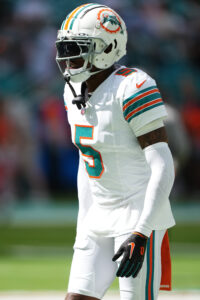 Omar Khan said the Cowboys reached out post-draft, and the team will pair Pickens with CeeDee Lamb. The Cowboys trading for Pickens and then unloading Micah Parsons is a rather interesting transaction log. Only going into his age-24 season, Pickens has a significant opportunity to impress after being the Steelers’ No. 1 target for much of his rookie deal. It is now quite possible he will be on a third team in three years after the 2026 free agency period, though a franchise tag — particularly with Parsons in Wisconsin — will be in play.
Omar Khan said the Cowboys reached out post-draft, and the team will pair Pickens with CeeDee Lamb. The Cowboys trading for Pickens and then unloading Micah Parsons is a rather interesting transaction log. Only going into his age-24 season, Pickens has a significant opportunity to impress after being the Steelers’ No. 1 target for much of his rookie deal. It is now quite possible he will be on a third team in three years after the 2026 free agency period, though a franchise tag — particularly with Parsons in Wisconsin — will be in play.
Attitude issues, which are not new for a Steelers wide receiver, affected the team’s view of the 2022 second-round pick. And a summer report pegged Pittsburgh as not deeming Pickens and Rodgers as an ideal partnership. Depleting a receiving corps before the QB had even committed is an interesting move, and big questions about Roman Wilson‘s viability as a WR2 — after a five-snap rookie season — exist.
The Steelers did add a weapon for Rodgers, but it involved the tight end room. Smith also became the third name in the Ramsey-Fitzpatrick swap. After acquiring a disgruntled Fitzpatrick in Year 2 of his rookie deal, as the Dolphins used 2019 as a teardown mission, the Steelers sent him back to Miami at 28. Ramsey enters the picture at 30, coming after yet another instance of the likely Hall of Fame-bound corner wearing out his welcome with a team.
Obtaining Ramsey for a third-round pick and tight end Hunter Long in 2023, the Dolphins generally received solid play from the three-time All-Pro. Ramsey missed nearly half the 2023 season after knee surgery but played 17 games last year. Pro Football Focus graded the versatile cover man 11th among CB regulars in 2024, but Ramsey became unhappy in Miami.
 A clash with Mike McDaniel and general discontent with the state of the Dolphins was believed to have irked Ramsey, though his reasoning for seeking an exit after two seasons is still not fully known. Despite a rumor pointing to Ramsey eyeing another West Coast move, the Steelers became a suitor.
A clash with Mike McDaniel and general discontent with the state of the Dolphins was believed to have irked Ramsey, though his reasoning for seeking an exit after two seasons is still not fully known. Despite a rumor pointing to Ramsey eyeing another West Coast move, the Steelers became a suitor.
The extension the Dolphins gave Ramsey last summer limited his trade market. Teams were believed to have balked at taking on too much of Ramsey’s 2025 compensation, but Chris Grier — despite yet another instance of the GM catering to a star player with an early extension or guarantee package — did well on this trade.
The Dolphins are only picking up $7MM of Ramsey’s 2025 tab, leaving the Steelers with $19.6MM. Ramsey’s three-year, $72.3MM extension runs through 2028, and the Dolphins took on the dead money (a non-QB-record $35.68MM). The Steelers cutting Ramsey during one of the next three offseasons, barring the corner securing yet another payday, would not bring any dead money.
Ramsey appears set for a hybrid role in Pittsburgh. The former Jaguars boundary defender began seeing extensive slot time with the Rams, logging 325 inside snaps in 2021 and 213 in 2022. After a perimeter role under Vic Fangio in 2023, Ramsey saw 185 slot snaps last season. He still played mostly on the boundary, which will be something to monitor here. But the Steelers could best utilize their top three corners by playing Ramsey inside more; that would leave room for Joey Porter Jr. and Darius Slay outside.
Fitzpatrick moved himself toward at least the Hall of Fame fringe with three first-team All-Pro seasons (2019, 2020, 2022), helping the Steelers remain a top-tier defense for most of his Pennsylvania stay. The dynamic safety intercepted 17 passes from 2019-22 and just one between the 2023 and ’24 seasons. The Steelers used Fitzpatrick closer to the line of scrimmage frequently in 2023, but even after a return to more of a deep safety role last season, his playmaking did not increase. The Steelers determined a $22MM 2025 cap hit was not worth what Ramsey (and Smith) could bring.
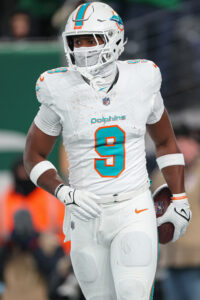 Pittsburgh gave Fitzpatrick a then-safety-record four-year, $72.99MM extension in 2022. Two years remain on the deal. The Steelers took on just $6.86MM in dead money by dealing the eighth-year vet. Lower-cost cogs DeShon Elliott and Juan Thornhill are set to work as the first-string safeties. This could bring a substantial downgrade, but the expected cornerback improvement may offset it to a degree.
Pittsburgh gave Fitzpatrick a then-safety-record four-year, $72.99MM extension in 2022. Two years remain on the deal. The Steelers took on just $6.86MM in dead money by dealing the eighth-year vet. Lower-cost cogs DeShon Elliott and Juan Thornhill are set to work as the first-string safeties. This could bring a substantial downgrade, but the expected cornerback improvement may offset it to a degree.
This will be Jonnu Smith‘s third time playing for Arthur Smith, the former Titans OC and Falcons HC. Two years after Atlanta traded for Jonnu, Pittsburgh was connected to yet another Smiths reunion in May. Although Jonnu Smith-Dolphins extension talks occurred and the veteran tight end — who had been attached to a two-year, $8.4MM deal agreed to shortly after his 2024 Falcons release — expressed a desire to stay in Miami. A trade came together a month later, with the Steelers readier to pay the resurgent tight end than the Dolphins, who operated more conservatively this offseason.
Chock full of tight ends thanks to the presences of Pat Freiermuth, Darnell Washington and Connor Heyward, Jonnu Smith completes an interesting set. With the Steelers light at receiver beyond Metcalf, plenty of two-TE sets figure to emerge. Jonnu improved on his 2023 bounce-back season under Arthur (50 catches, 582 yards, three TDs) with a banner Miami slate (88/884/8). The 30-year-old TE’s cap hit will rise from $5.13MM in 2025 to $10.87MM in 2026.
Extensions and restructures:
 The cost of Watt’s extension began to rise when Maxx Crosby started the offseason edge rusher market boom, but the price crystalized after the Browns convinced Myles Garrett to rescind his trade request with a $40MM-per-year extension. While Garrett’s deal reset the market, the Steelers were smart to hammer out a Watt deal when they did. Had Pittsburgh waited until September like they did in 2021, the contract would assuredly have been pricier thanks to the Packers’ Micah Parsons windfall.
The cost of Watt’s extension began to rise when Maxx Crosby started the offseason edge rusher market boom, but the price crystalized after the Browns convinced Myles Garrett to rescind his trade request with a $40MM-per-year extension. While Garrett’s deal reset the market, the Steelers were smart to hammer out a Watt deal when they did. Had Pittsburgh waited until September like they did in 2021, the contract would assuredly have been pricier thanks to the Packers’ Micah Parsons windfall.
Unlike in 2021, Watt skipped minicamp. Plenty of rumors pegged the sides as far apart — particularly on guarantees — but a Steelers organization that does not negotiate in-season beat its self-imposed deadline by nearly two months.
Trade rumors became part of this process, but it never appeared anything was close. Watt’s slower finish (after a torrid start) last season was believed to factor into the Pittsburgh negotiation, but with the team in Year 4 without franchise-QB money on the books, flexibility existed. It took a monster guarantee package to seal this deal, though. Considering the Steelers are 1-10 without Watt since his 2017 arrival, the ninth-year sack ace carried notable leverage in his second round of extension talks.
Read more
At the time of signing, Watt’s $108MM fully guaranteed sum checked in $20MM higher than Garrett’s. This was a particularly impressive score by Watt’s camp, considering Garrett is signed through 2030; the all-time Steelers great’s deal only runs through 2028. Receiving such a substantial portion of a third contract fully guaranteed without a longer-term commitment illustrates how highly Watt is valued in Pittsburgh.
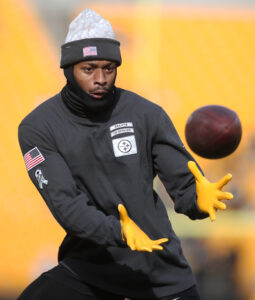 Like the Bengals and Packers, the Steelers do not make a habit of post-Year 1 guarantees. As they did in 2021, however, the Steelers bent for Watt on this crucial front. Watt sought guarantees into Year 4 of the deal. While that proved unrealistic, scoring fully guaranteed salaries in 2026 and ’27 (when the future Hall of Famer will be 33) represented impressive negotiating.
Like the Bengals and Packers, the Steelers do not make a habit of post-Year 1 guarantees. As they did in 2021, however, the Steelers bent for Watt on this crucial front. Watt sought guarantees into Year 4 of the deal. While that proved unrealistic, scoring fully guaranteed salaries in 2026 and ’27 (when the future Hall of Famer will be 33) represented impressive negotiating.
Watt is the only NFLer to finish with three sack titles (2020, 2021, 2023). J.J. Watt is the only player to post multiple 20-sack seasons; his younger brother will continue taking aim at the feat in Pittsburgh.
A lower-profile extension — but perhaps a telling one, given the Steelers’ offseason path at safety — transpired before the Watt deal. An ex-Ravens draftee who played sidekick to Fitzpatrick in 2024, Elliott received a raise on a through-2027 contract. The Steelers became the fourth team to employ Elliott, adding the former Dolphins and Lions starter last year. After 14 Pittsburgh starts, the 28-year-old defender secured a decent guarantee.
Elliott’s PFF grades have been consistent throughout his career; the advanced metrics site ranked him 27th among safety regulars last season. More will be on the seventh-year vet’s shoulders in 2025, with Fitzpatrick out of the picture.
 A UDFA success story, Warren was retained on a second-round RFA tender ($5.35MM) that narrowly eclipsed Najee Harris‘ Chargers base value. The pass-down option/three-year Harris complement should maintain an extensive role this season, and the Labor Day extension affirmed Warren’s importance to the Steelers.
A UDFA success story, Warren was retained on a second-round RFA tender ($5.35MM) that narrowly eclipsed Najee Harris‘ Chargers base value. The pass-down option/three-year Harris complement should maintain an extensive role this season, and the Labor Day extension affirmed Warren’s importance to the Steelers.
Rather than an audition year in an age-27 season, Warren will stay and perhaps lead the way in the backfield this season — before potentially sliding into a Kaleb Johnson complementary role down the road. Warren will earn more than $7MM in 2025, doing well to collect a $5.95MM signing bonus to go with his base salary. With Harris and James Conner leaving after one contract and the Le’Veon Bell mess producing two franchise tags (one unsigned), this is the first multiyear Steelers RB extension since Willie Parker in 2006.
Warren’s most recent full season (2023) brought 1,154 scrimmage yards and a fourth-place ranking in rush yards over expected (148). After missing early-season time due to injury last year, Warren has earned some trust thanks to a three-year role. The Johnson third-round pick had slotted Warren as Pittsburgh’s RB priority, but he will be retained as at least a high-end sidekick option for a team seemingly headed toward rebooting around a rookie-QB deal in 2026.
Free agency additions:
- Aaron Rodgers, QB. One year, $13.65MM ($10MM guaranteed)
- Darius Slay, CB. One year, $10MM ($8.75MM guaranteed)
- Malik Harrison, ILB. Two years, $10MM ($4.08MM guaranteed)
- Mason Rudolph, QB. Two years, $7.5MM ($3MM guaranteed)
- Brandin Echols, CB. Two years, $6MM ($1.83MM guaranteed)
- Juan Thornhill, S. One year, $3MM ($1.83MM guaranteed)
- Daniel Ekuale, DL. One year, $2.8MM ($1.63MM guaranteed)
- Kenneth Gainwell, RB. One year, $1.79MM ($620K guaranteed)
- Andrus Peat, G. One year, $1.42MM ($168K guaranteed)
- Chuck Clark, S. One year, $1.42MM
- Donald Parham, TE. One year, $1.17MM
A marriage of convenience is set to unfold in Pittsburgh. Rodgers had effectively let it be known he preferred to end up in Minnesota or Los Angeles; the Steelers wanted to either re-sign Justin Fields or add Matthew Stafford in a trade. Option C for both parties figures to bring one of the more interesting QB fits in modern NFL history.
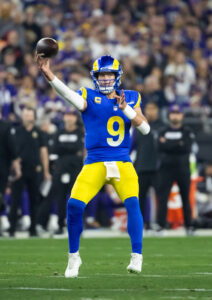 A quarterback with a late-career drama penchant joins an old-school organization with an established head coach. Mike Tomlin will be far more difficult for Rodgers to overpower compared to Robert Saleh, but this will be a lead NFL storyline to monitor this year. That said, Tomlin’s presence helped convince Rodgers to postpone retirement for one more year.
A quarterback with a late-career drama penchant joins an old-school organization with an established head coach. Mike Tomlin will be far more difficult for Rodgers to overpower compared to Robert Saleh, but this will be a lead NFL storyline to monitor this year. That said, Tomlin’s presence helped convince Rodgers to postpone retirement for one more year.
The Giants and Raiders became the lead Stafford suitors, while the Steelers stood down. Pittsburgh also spoke with Joe Flacco and kept Kirk Cousins on its radar. With would-be target Sam Darnold drawing a three-year, $100.5MM Seahawks offer and Stafford seeking a $50MM-per-year deal, the Steelers did not appear to be in those races long. Once the Vikings bowed out on Rodgers in March, the Rodgers-to-Pittsburgh path cleared. Minnesota building around J.J. McCarthy left Rodgers with two real options (as he did not want to join the Giants, who submitted the best offer): Steelers or retirement.
Contract parameters were in place before Rodgers’ late-March visit. Despite declining play since his 2021 MVP season, Rodgers still had a willing suitor — one he strung along for nearly three months. Rodgers putting off joining this eager suitor until days before minicamp looks to have rankled some in the organization, as rumors about internal doubt surfaced. Elliott and Cameron Heyward also questioned Rodgers’ fit due to the QB dragging his feet. But the sides are in business together for an expected one-and-done.
 For better or worse (assuredly better for NFL content), Rodgers is in Pittsburgh for what he expects to be his last season. The list of QBs to remain preferred starters past their 42nd birthdays stops at Tom Brady, though Warren Moon (1997 Seahawks) and Vinny Testaverde (2004 Cowboys) were primary starters at 41. Rodgers will turn 42 in December. He is coming off a 25th-place QBR season — three spots behind Russell Wilson — and ranked 26th in his final Packers campaign. QB-needy teams, however, viewed Rodgers as a better option than Wilson this offseason.
For better or worse (assuredly better for NFL content), Rodgers is in Pittsburgh for what he expects to be his last season. The list of QBs to remain preferred starters past their 42nd birthdays stops at Tom Brady, though Warren Moon (1997 Seahawks) and Vinny Testaverde (2004 Cowboys) were primary starters at 41. Rodgers will turn 42 in December. He is coming off a 25th-place QBR season — three spots behind Russell Wilson — and ranked 26th in his final Packers campaign. QB-needy teams, however, viewed Rodgers as a better option than Wilson this offseason.
Rodgers did throw 28 TD passes compared to 11 INTs in his Jets finale, showing glimpses of his Packers version, but averaged 6.7 yards per attempt — tied for a career-worst figure. The Steelers are also parking him in an offense without a proven No. 2 receiver and behind an O-line featuring three 2024 draftees and a 2023 first-rounder (Broderick Jones) who has not shown much yet. Cynics could note this looks a lot like the 2023 Jets setup that crumbled after four plays, but a Steelers team with a perennially high floor bought in.
After whiffing on Kenny Pickett and seeing Wilson and Fields’ limitations last season, the Steelers are betting on Rodgers’ historic arm talent. It will be interesting to see if Rodgers tones down his antics, which landed him in regular headlines as a Jet, now that he is working for Tomlin and leading a veteran-laden team.
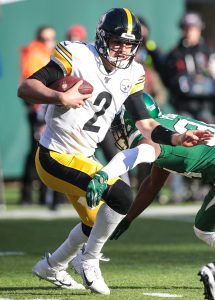 With Rodgers expected to retire in 2026 (though, here’s betting that process takes a while), the Steelers are preparing to dive back into the draft pool with a high-level investment. Rodgers as a means to punt on a shaky 2025 QB class makes sense, but plenty of pressure will be on the team to land a long-term answer next year.
With Rodgers expected to retire in 2026 (though, here’s betting that process takes a while), the Steelers are preparing to dive back into the draft pool with a high-level investment. Rodgers as a means to punt on a shaky 2025 QB class makes sense, but plenty of pressure will be on the team to land a long-term answer next year.
Tomlin at least paid lip service to being OK with Rudolph reprising his late-2023 role as a starter, but the veteran’s contract suggests that was obviously never the plan. Rudolph did usurp Pickett, rising from QB3 to QB1 in 2023, and help the Steelers into the playoffs. Results were less impressive during his Titans one-off. The Steelers know what they have in the ex-Roethlisberger backup, who is entering his age-30 season. With Rudolph signed for two years, he could certainly be in place to groom a 2026 first-rounder.
The Steelers continue to buck league trends by deploying 30-something cornerbacks. Pittsburgh, which acquired Ramsey ahead of an age-31 season, signed Patrick Peterson at 33 in 2023 and had employed Joe Haden until his age-32 campaign. Under Tomlin, they also deployed Ike Taylor at corner until age 33 and William Gay at 32. Slay will bring an even older option, turning 34 before the Eagles’ Super Bowl-winning season wrapped.
 Despite his advanced NFL age, Slay was a full-time starter for the championship Eagles outfit last season. Slay started 14 games and all four Philly playoff tilts, ranking as PFF’s No. 23 overall corner. The career-long boundary defender played under DC Teryl Austin in Detroit.
Despite his advanced NFL age, Slay was a full-time starter for the championship Eagles outfit last season. Slay started 14 games and all four Philly playoff tilts, ranking as PFF’s No. 23 overall corner. The career-long boundary defender played under DC Teryl Austin in Detroit.
A Pro Bowler in 2022 and an alternate in 2023, Slay played a lead role on the Eagles’ Super Bowl LVII-qualifying team and has six Pro Bowls on his resume. Like Rodgers, Slay — whom the Eagles cut rather than pay out an option bonus — is expected to walk away after this season. He will be a rare modern-era 13th-year starting CB first.
Gainwell joins Slay in the cross-Pennsylvania migration. He served as the Eagles’ RB2 for three years, playing behind Miles Sanders, D’Andre Swift and Saquon Barkley. Gainwell gives the Steelers a fresh option, having taken only 280 handoffs in four seasons.
Harrison stepped in as Ravens insurance last year, replacing would-be Patrick Queen successor Trenton Simpson in Baltimore’s lineup. A 2020 third-round pick, Harrison started 34 games in Baltimore. He profiles as an Elandon Roberts replacement alongside Queen, though Cole Holcomb — after a substantial pay cut — made the 53-man roster after missing all of 2024 due to injury.
Re-signings:
- Ben Skowronek, WR. Two years, $4.48MM ($1.08MM guaranteed)
- Calvin Anderson, T. Two years, $4MM ($830K guaranteed)
- Isaiahh Loudermilk, OLB. One year, $1.63MM ($168K guaranteed)
- Max Scharping, G. One year, $1.34MM ($168K guaranteed)
- Scotty Miller, WR. One year, $1.34MM
- James Pierre, CB. Practice squad
- Robert Woods, WR. Practice squad
Miller and Skowronek reside as backup options, each making the 53-man roster over Woods despite far less notable careers. Woods is 33, however, and did not impress in the preseason. Rodgers influenced the Jets to bring in ex-Packer teammates, as Allen Lazard‘s arrival predated Randall Cobb and Davante Adams signing on. Lazard was mentioned as a Steelers option in May, and Rodgers spoke with Odell Beckham Jr. — a player on his 2023 Jets wish list — despite the injury-prone wideout’s unproductive Dolphins year. With an aging Rodgers needing better WR investments than he did in Green Bay, Pittsburgh rumors here likely will not die down for a while.
Notable losses:
- Montravius Adams, DL (released)
- Kyle Allen, QB
- James Daniels, G
- Justin Fields, QB
- Najee Harris, RB
- Nate Herbig, C
- C.J. Henderson, CB
- Donte Jackson, CB
- Van Jefferson, WR
- Cameron Johnston, P (released)
- Damontae Kazee, S
- Tyler Matakevich, ILB
- Dan Moore Jr., LT
- Larry Ogunjobi, DL (released)
- Cordarrelle Patterson, RB/KR (released)
- MyCole Pruitt, TE
- Elandon Roberts, ILB
- Preston Smith, OLB (released)
- Cameron Sutton, CB
- Mike Williams, WR
- Russell Wilson, QB
 Wilson’s gradual descent, aside from the heavily Nathaniel Hackett-influenced 2022 debacle, continues to come with acceptable stats. But the Seahawks, Broncos and Steelers have moved on in three of the past four years. This marked a seeming reversal on Pittsburgh’s part. Extension buzz circulated as Wilson had the 2024 squad at 10-3. It slowed to a crawl after the ensuing five-game losing streak. After the Ravens’ one-sided wild-card win, a Fields-over-Wilson stance formed.
Wilson’s gradual descent, aside from the heavily Nathaniel Hackett-influenced 2022 debacle, continues to come with acceptable stats. But the Seahawks, Broncos and Steelers have moved on in three of the past four years. This marked a seeming reversal on Pittsburgh’s part. Extension buzz circulated as Wilson had the 2024 squad at 10-3. It slowed to a crawl after the ensuing five-game losing streak. After the Ravens’ one-sided wild-card win, a Fields-over-Wilson stance formed.
Tomlin’s decision — made over objections in the building — to bench Fields once Wilson’s balky calf healed was believed to have impacted the younger passer’s call to test free agency. The Steelers’ 30-plus-year avoidance of in-season negotiations left them a truncated timetable to re-sign Fields, and when it became clear the dual-threat QB would test the market, Pittsburgh needed to scramble for a free agent or trade option.
This was not the team’s initial preference, as flexibility became required once Fields began to waver on Pittsburgh. The team did talk terms with Wilson, but it became clear their 11-game 2024 starter was a backup plan. The gradual humbling of a player who once appeared a near-lock for the Hall of Fame continued.
 Fields’ decision to spurn Steelers interest will come up again plenty this week, with the Jets — who gave the inconsistent passer/elite runner a two-year, $40MM deal ($30MM guaranteed) hours into the legal tampering period — being the Week 1 opponent.
Fields’ decision to spurn Steelers interest will come up again plenty this week, with the Jets — who gave the inconsistent passer/elite runner a two-year, $40MM deal ($30MM guaranteed) hours into the legal tampering period — being the Week 1 opponent.
Neither Wilson nor Fields was an above-average option last season; the former’s contract and latter’s trade — a sixth-rounder due to playing-time conditions not being met — price pointed to unremarkable returns. Wilson, 36, needed to wait multiple weeks to sign. He continued to express a desire to stay in Pittsburgh, and a 16:5 TD-INT ratio with minimal weaponry was certainly not a bad season. But Wilson was stuck waiting behind Rodgers. It took a Giants team Rodgers rebuffed to end Wilson’s free agency stay, via a one-year, $10.5MM bridge deal.
Harris said he knew late last season he would not be back in Pittsburgh. The four-time 1,000-yard back did bring excitement, but he proved durable — during his Pittsburgh stay, at least — after not missing a game. Harris’ market not topping $6MM, as he signed a one-year Chargers deal worth $5.25MM, represented a telling sign of the team’s interest in retaining the 2021 first-round pick. Harris is not a Week 1 lock after the July 4 fireworks accident relegated him to the active/NFI list throughout Bolts camp.
 Pittsburgh’s O-line will be far less experienced this year, making it interesting an immobile QB will play behind it. That said, Wilson and Fields take sacks at a historic rate. That impacted Moore’s sacks-allowed numbers, and teams were undeterred by them. The Titans outbid the Patriots and others for Moore, who is now the NFL’s 10th-highest-paid left tackle.
Pittsburgh’s O-line will be far less experienced this year, making it interesting an immobile QB will play behind it. That said, Wilson and Fields take sacks at a historic rate. That impacted Moore’s sacks-allowed numbers, and teams were undeterred by them. The Titans outbid the Patriots and others for Moore, who is now the NFL’s 10th-highest-paid left tackle.
Tennessee gave the four-year Pittsburgh starter $42MM guaranteed at signing on a deal averaging $20.5MM per year. Moore benefited from Ronnie Stanley and Alaric Jackson being taken off the market early and was one of free agency’s big winners.
Moore’s exit leaves Broderick Jones at LT. The 2023 first-rounder did not impress at RT, for the most part, and the team will entrust the former No. 14 overall pick to protect Rodgers’ blind side. Jones’ shift will clear a spot for 2024 first-rounder Troy Fautanu, whose arrival pointed to a Moore 2025 exit. After Fautanu missed his rookie year, the Steelers will see their hopeful long-term tackle tandem in action. Hopes are 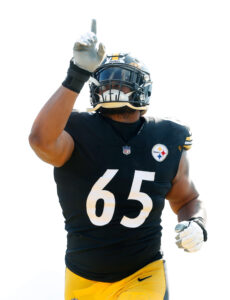 probably higher for Fautanu than Jones at this point.
probably higher for Fautanu than Jones at this point.
Second in pass block win rate in an abbreviated 2024 season and ninth during a full 2022 slate, Daniels said before last season he did not expect to re-sign with the Steelers. The Achilles tear the three-year Pittsburgh starter sustained in Week 4 hurt his market, as a three-year, $24MM Dolphins deal arrived (one light on guarantees).
The team is going with 2024 fourth-round pick Mason McCormick, whom PFF slotted 54th among guards last season. Improvement should be expected in Year 2, but with Zach Frazier also a second-year cog at center, the Steelers will likely need to lean on LG Isaac Seumalo‘s experience up front.
Draft:
- Round 1, No. 21: Derrick Harmon (DT, Oregon) (signed)
- Round 3, No. 83: Kaleb Johnson (RB, Iowa) (signed)
- Round 4, No. 123: Jack Sawyer (OLB, Ohio State) (signed)
- Round 5, No. 164 (from Lions through Browns, Eagles and Chiefs): Yahya Black (DE, Iowa) (signed)
- Round 6, No. 185 (from Bears through Seahawks): Will Howard (QB, Ohio State) (signed)
- Round 7, No. 226 (from Panthers through Chiefs): Carson Bruener (LB, Washington) (signed)
- Round 7, No. 229 (from Falcons through Eagles): Donte Kent (CB, Central Michigan) (signed)
 On draft week, a report indicated the Steelers viewed the 2025 or ’26 first rounds as the window to grab a quarterback. Considering the disparity between how the two QB classes are viewed, skepticism existed about the Steelers’ willingness — especially after Art Rooney II doubled down on an expectation Rodgers would join the team — to make that move at No. 21.
On draft week, a report indicated the Steelers viewed the 2025 or ’26 first rounds as the window to grab a quarterback. Considering the disparity between how the two QB classes are viewed, skepticism existed about the Steelers’ willingness — especially after Art Rooney II doubled down on an expectation Rodgers would join the team — to make that move at No. 21.
Despite Jaxson Dart and Shedeur Sanders being on the board, Pittsburgh indeed passed. It took the Steelers until Round 6 to grab a quarterback, and Howard is already on IR after suffering a broken finger early in training camp.
The Steelers were believed to have placed a first-round grade on Dart, and Tomlin was mentioned pre-draft as a Sanders fan. Peak smokescreen season points teams in varying directions. As it turned out, the Steelers were among the teams to take Sanders off their board during the Colorado QB’s poor approach to the pre-draft process. The Giants correctly guessed the Steelers would leave Dart on the board for them, deeming it unnecessary to trade in front of them. The Steelers bolstered their defense with Harmon, whom they had hosted on a “30” visit.
Profiling as a long-term replacement for Cameron Heyward, Harmon will first learn from the 15th-year  veteran. The interior disruptor at Oregon and Michigan State, Harmon is the first D-lineman the Steelers have drafted in Round 1 since Heyward. After a five-sack, 11-TFL 2024 season, Harmon was viewed as a first-round lock.
veteran. The interior disruptor at Oregon and Michigan State, Harmon is the first D-lineman the Steelers have drafted in Round 1 since Heyward. After a five-sack, 11-TFL 2024 season, Harmon was viewed as a first-round lock.
He will be expected to team with Heyward and Keeanu Benton up front, but an MCL sprain will delay the rookie’s debut. The Steelers did not view Harmon’s recovery timetable as lengthy enough to warrant an IR-return slot, so fans should not need to wait long to see their old-school/new-school D-end duo line up together.
The team also met with Johnson, whom both Daniel Jeremiah and Dane Brugler rated as a top-55 prospect in the draft. No. 44 on Brugler’s The Athletic big board, Johnson was nevertheless the sixth running back to hear his name called this year. A dominant junior season (a Big Ten-leading 1,537 rushing yards, 21 TDs) rocketed Johnson onto the Day 2 radar in a deep RB class. Even with Warren now extended, Johnson — as the team’s highest non-Harris RB draftee since Le’Veon Bell (2013) — will be a key part of Pittsburgh’s future at this position.
Other:
Tomlin non-hot-seat posts are a near-annual PFR staple, making it unsurprising the Bears were denied permission to meet with the 19th-year Steelers HC amid their expansive search. Tomlin, 53, takes plenty of heat for his worsening playoff record (now 8-11, no wins since 2016) but few coaches in NFL history have brought a higher floor.
 Tomlin’s eighth Steelers contract runs through the 2027 season; he has passed Bill Cowher for Steelers duration but needs to reach Year 23 to tie Chuck Noll. Even with Tomlin on a year-to-year arrangement, the historically patient Steelers appear nowhere close to considering a firing.
Tomlin’s eighth Steelers contract runs through the 2027 season; he has passed Bill Cowher for Steelers duration but needs to reach Year 23 to tie Chuck Noll. Even with Tomlin on a year-to-year arrangement, the historically patient Steelers appear nowhere close to considering a firing.
The other Steelers power broker enjoyed a more eventful offseason. As bigger swings for outside talent ensued, Khan received backing from ownership via an extension announced days after the Jalen Ramsey/Jonnu Smith trade. Showing a greater willingness to dole out notable contracts to outside hires than predecessor Kevin Colbert, Khan has now overseen three Steelers offseasons (he was hired after the 2022 draft). While the Steelers have hovered off the Super Bowl contender tier under their current GM, the team remains a playoff fixture.
The longtime Steelers cap czar oversaw easily the most eventful offseason of his tenure, with Rodgers and Metcalf joining the two Dolphins as big-ticket acquisitions. This came after endless receiver rumors emerged in 2024. How this year’s O-line — which now holds five Khan-acquired starters — performs will be important to judging the GM’s draft acumen. Kenny Pickett does not count against Khan technically, even as he was in the organization during Colbert’s final draft, but how the Steelers handle their 2026 QB search will be Khan’s most important task through four years on the job.
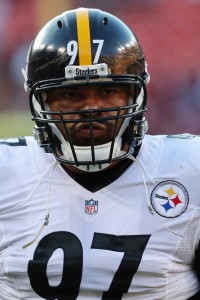 Heyward, 36, signed an extension coming off a down year. He agreed to a two-year, $29MM add-on. But he then became the oldest D-lineman to post a first-team All-Pro season since Reggie White and Bruce Smith did so (at ages 37 and 35, respectively) in 1998. Building a Hall of Fame case over the back half of his career like Jason Kelce and Trent Williams, Heyward now has four first-team All-Pro nods and seven Pro Bowls — all since 2017. Heyward and T.J. Watt represent one of the great inside-outside pass-rushing duos in the sack era, but the Steelers have contract policies they only break in extreme circumstances.
Heyward, 36, signed an extension coming off a down year. He agreed to a two-year, $29MM add-on. But he then became the oldest D-lineman to post a first-team All-Pro season since Reggie White and Bruce Smith did so (at ages 37 and 35, respectively) in 1998. Building a Hall of Fame case over the back half of his career like Jason Kelce and Trent Williams, Heyward now has four first-team All-Pro nods and seven Pro Bowls — all since 2017. Heyward and T.J. Watt represent one of the great inside-outside pass-rushing duos in the sack era, but the Steelers have contract policies they only break in extreme circumstances.
Seeing far less proven D-tackles collect big paydays this offseason, Heyward has been bumped down to third-tier status on that market. Not only did proven younger players like Zach Allen, Alim McNeill and Zach Sieler lap Heyward’s current deal, contract-year wonders Milton Williams and Tershawn Wharton passed him as well. Heyward sits 23rd for DT AAV, but the Steelers do not renegotiate deals with multiple years remaining.
The 2016 Antonio Brown rework showed some flexibility, in the form of a single-year raise, but time is running out due to Pittsburgh’s Week 1 negotiating shutdown. Heyward said he would be willing to miss games, but he ended a brief hold-in and is on track for the Steelers’ opener — with or without a raise. Will the cornerstone D-lineman make a final push to augment his deal?
Top 10 cap charges for 2025:
- T.J. Watt, OLB: $23.37MM
- Cameron Heyward, DL: $19.65MM
- Jalen Ramsey, CB: $19.5MM
- Alex Highsmith, OLB: $18.6MM
- Patrick Queen, ILB: $17.69MM
- Aaron Rodgers, QB: $14.15MM
- Pat Freiermuth, TE: $12.89MM
- D.K. Metcalf, WR: $11MM
- Isaac Seumalo, G: $10.19MM
- Darius Slay, CB: $10MM
The Steelers went to greater-than-usual lengths this offseason to shake things up in hopes of leaving their upper-middle-class confines. Skepticism about Rodgers’ 2025 capabilities have understandably emerged, but the Steelers will attempt to pair the QB icon with a high-priced defensive core that has regularly given lesser passers playoff access.
Breaking into the AFC’s top tier may be unrealistic given the proven contenders residing in Kansas City, Buffalo and Baltimore. And the Bengals-Texans-Broncos-Chargers contingent features ascending quarterbacks who have already led their teams to the playoffs. A playoff win would represent a successful Steelers season, even if the franchise will aim higher. Rodgers is certainly one of the most fascinating stopgap QBs in NFL history. Will this provide a better ending to his career or follow the Jets’ mistake as a footnote in a 21-year legacy?
The Steelers are betting they can coax enough from the likely 2031 Canton inductee to make their experienced defense a more formidable threat — after four straight playoff losses by double digits — come January. Either way, rumors connecting the team to the 2026 QB class will hover in the background of what will be one of the most interesting seasons in Steelers history.
By Ely Allen |
at August 31, 2025 10:00 pm
2024 marked a year for improvements in Arizona. In the second year of the Jonathan Gannon–Monti Ossenfort regime, the head coach and general manager duo took a team that had finished last in the NFC West for two straight years and had given up the second-most points and most rushing yards on defense in 2023 and improved in every one of those facets. Seeing that the new leadership was having a positive effect and knowing that quarterback Kyler Murray is now well over two years removed from his late-2022 ACL injury, the Cardinals came into this offseason with a new plan.
With a 2024 salary cap carryover of $11.38MM and another cap increase by the league, Arizona entered the offseason with $71.33MM in cap space — good for the fourth-highest amount in the NFL — and a plan to utilize it. With the small caveat of having to shoulder Murray’s $43.33MM-cap hit — good for the fifth-highest such figure in the NFL — the Cardinals came out of 2024 looking to improve the roster with tons of new contracts for players both foreign (to the team) and domestic.
Extensions and restructures:
Early this offseason, the Cardinals expressed hope to sign their star tight end to an extension as soon as he became eligible. They got it done just two months after that report, making McBride the highest-paid tight end in NFL history (for a little less than four weeks, until George Kittle moved the market just past him).
 McBride, 25, has proven to be more than worth the $19MM-per-year price tag after finishing just one catch (111) and 48 yards (1,146) short of matching the totals of the league’s leading tight end in both stats. The TE market remains south of the $20MM-per-year place, even as WR salaries are now past $40MM AAV, but McBride set the table for such a breakthrough after his strong third season.
McBride, 25, has proven to be more than worth the $19MM-per-year price tag after finishing just one catch (111) and 48 yards (1,146) short of matching the totals of the league’s leading tight end in both stats. The TE market remains south of the $20MM-per-year place, even as WR salaries are now past $40MM AAV, but McBride set the table for such a breakthrough after his strong third season.
Although frustrating fantasy GMs by catching only two touchdown passes last season, McBride has established himself as the most prolific receiving tight end in the Cardinals’ Arizona-years history. McBride’s past two seasons rank first and second for Cards TEs in single-season yardage since the team relocated to the desert in 1988. This contract ensures the Colorado State product will team with Marvin Harrison Jr. as the Cardinals’ top pass-catching weapons for the foreseeable future.
Part of McBride’s full guarantee comes via a $16.5MM signing bonus. The former second-round pick secured a fully guaranteed 2026 base salary, and the Cardinals used $7.5MM in option bonuses — in lieu of void years — to help keep his cap hits low. McBride will not be tied to a cap number higher than $9MM until 2027. McBride’s $1.88MM 2026 option bonus is guaranteed, while $3MM of his 2027 base salary locks in on Day 5 of the 2026 league year. Per Spotrac, the other $7.53MM of McBride’s 2027 base salary shifts from an injury guarantee to a full guarantee on Day 5 of the 2027 league year.
Free agency additions:
- Josh Sweat, DE: Four years, $76.4MM ($38MM guaranteed)
- Dalvin Tomlinson, DT: Two years, $29MM ($15.5MM guaranteed)
- Jacoby Brissett, QB: Two years, $12.5MM ($8MM guaranteed)
- Akeem Davis-Gaither, LB: Two years, $10MM ($5MM guaranteed)
- Calais Campbell, DL: One year, $5.5MM ($4.25MM guaranteed)
- J.J. Russell, LB: One year, $1.17MM
- Jake Curhan, T: Practice squad
- Josiah Deguara, TE: Practice squad
- Simi Fehoko, WR: Practice squad
The area in which the Cards were most prepared to spend was in free agency, and the main focus was on a defense that, despite showing improvement in 2024, still had a long way to go in order to be considered an impressive unit. A defensive line last year that most often was comprised of L.J. Collier, Dante Stills, Roy Lopez, and Naquan Jones has been transformed into a unit led by a familiar face in Campbell, with Tomlinson, Sweat, and last year’s first-round pick, Darius Robinson, filling out the rest of the line. 
Campbell spent the first nine years of his career in Glendale, and when he tested the free agency waters for the first time at 30 years old, he was a hot commodity. To Arizona’s credit, the team tried to retain the star lineman on a $9MM-per-year hometown discount back in 2017, and the Denver native even received a $13MM-per-year offer from his actual hometown Broncos team. Ultimately, he landed in Jacksonville — which promptly became known affectionately as “Sacksonville,” due in part to his presence — and gave the Jaguars three of the best years of his career.
Campbell was traded in 2020 to the Ravens, where he put forth three more decent campaigns, but injuries began to nag a bit when his time in Baltimore ended at 36 years old. Not one to bow to Father Time, though, Campbell played all 17 games in each of the past two seasons — 2023 with the Falcons, 2024 with the Dolphins — before heading back to the team that drafted him. The Cardinals, in fact, had attempted to reacquire him in the middle of the 2024 season.
Set to turn 39 Monday, Campbell has not posted double-digit sacks since his second year in Jacksonville. But he routinely grades as one of the strongest defensive linemen in the NFL, per Pro Football Focus (subscription required), and his leadership and community work are often considered second to none. Recent rumblings have revealed Campbell’s return to Arizona may include a swan song performance as he anticipates retiring after his 18th NFL season.
 Joining Campbell on the line are top signees Sweat and Tomlinson. Sweat arrives in Arizona after seven years in Philadelphia, where he had established himself as a full-time starter after earning a three-year, $40MM extension and collected 43 sacks in his final six years with the team after going sackless as a rookie.
Joining Campbell on the line are top signees Sweat and Tomlinson. Sweat arrives in Arizona after seven years in Philadelphia, where he had established himself as a full-time starter after earning a three-year, $40MM extension and collected 43 sacks in his final six years with the team after going sackless as a rookie.
It became clear the Eagles were not going to be able to retain Sweat following their Super Bowl-winning campaign, and the 28-year-old switched his representation up in preparation to land a deal like the one he got with the Cardinals. PFR’s No. 2 overall free agent, Sweat dominated in Super Bowl LIX — with 2.5 sacks and a crucial second-quarter pressure that forced a Patrick Mahomes interception — to cement himself as a top-tier free agent. This will bring a reunion with Gannon, Sweat’s DC from 2021-22.
Tomlinson, on the other hand, found himself a surprise free agent after the Browns made him a cap casualty in the aftermath of making Myles Garrett the highest-paid non-quarterback in the NFL (at the time). Tomlinson, 31, had been midway through his third NFL contract after playing out his rookie deal with the Giants and spending two years in Minnesota. Per PFF, his first season in Cleveland was a down year for the veteran, but he recovered quite well in 2024.
 Before becoming a Brown, though, Tomlinson routinely graded out as a top-25 interior defensive lineman in the NFL. The new one-two of Campbell and Tomlinson in the middle with Sweat and Robinson on the ends should make for a formidable new-look unit.
Before becoming a Brown, though, Tomlinson routinely graded out as a top-25 interior defensive lineman in the NFL. The new one-two of Campbell and Tomlinson in the middle with Sweat and Robinson on the ends should make for a formidable new-look unit.
The team’s linebacking corps also got some renovations. Deciding to move on from the Kyzir White experience, the Cardinals added a budding Davis-Gaither to the group. Davis-Gaither spent the first four years of his career as a rotational player with the Bengals, starting only four games in 54 appearances. More was asked of Davis-Gaither at the end of last season, though, when an injury to Logan Wilson forced him into the starting lineup for the final six games. The team’s current depth charts indicate that Davis-Gaither may retain a starting role in his first year with the Cardinals.
The team made relatively very few moves on offense when looking at external free agents, deciding instead to focus their efforts on bodies in the building already, as we’ll visit in later sections. One spot in which the team figured it could make a significant improvement was at backup quarterback.
When Murray suffered his ACL injury two years ago, the two backup quarterbacks, Joshua Dobbs and Clayton Tune, went a combined 1-8 to open the 2023 season. Luckily for Arizona, Murray started every game last season, but it seems the Cardinals still felt a need to find a more experienced, successful option than the former fifth-round pick out of Houston.
 Brissett seems to be the latest entry into the journeyman emergency starter archetype. Like those who came before him — Ryan Fitzpatrick, Josh McCown, Vinny Testaverde — he comes to town with multiple years of experience as a full-time starter and double-digit starts for the Browns and/or Jets.
Brissett seems to be the latest entry into the journeyman emergency starter archetype. Like those who came before him — Ryan Fitzpatrick, Josh McCown, Vinny Testaverde — he comes to town with multiple years of experience as a full-time starter and double-digit starts for the Browns and/or Jets.
While it is true that Brissett has never finished a season with more starts won than lost, the 32-year-old is a composed professional that rarely throws the ball to the other team. When your star quarterback is out for any reason, being able to minimize mistakes becomes a crucial part of winning games. Regardless, Arizona will hope it doesn’t see much of its new $6.25MM-per-year asset.
One area on the defense the team failed to improve through free agency was at cornerback. While Garrett Williams earned much acclaim for his performance in the slot, the outside group of corners was pretty average. A season-ending knee injury in May for returning starter Sean Murphy-Bunting put a scare into the team, then a torn ACL for the other returning starter, Starling Thomas, exacerbated concerns (more on that below) at the position even more three weeks ago.
Very early in the offseason, the Cardinals kicked the tires on former Chargers starting cornerback Asante Samuel Jr., who’s coming off an injury of his own. No contract emerged from the visit, but Samuel remains unsigned to this day. At the moment, though, it appears Arizona will be content with the help it obtained at the position through the draft.
Re-signings:
- Baron Browning, OLB: Two years, $15MM ($10MM guaranteed)
- Evan Brown, G: Two years, $11.5MM ($6MM guaranteed)
- Kelvin Beachum, OL: One year, $4MM ($3.49MM guaranteed)
- L.J. Collier, DE: One year, $3MM ($1.5MM guaranteed)
- Zay Jones, WR: One year, $2.4MM ($1.3MM guaranteed)
- Will Hernandez, G: One year, $2.17MM ($790K guaranteed)
- Joey Blount, S: Two years, $3.75MM ($400K guaranteed)
- Aaron Brewer, LS: One year, $1.42MM ($167.5K guaranteed)
When Ossenfort and Co. looked at the free agent market, they saw a lot of players they liked who wore the same logo they did. The front office then got busy re-signing several key players from last year’s team.
Read more
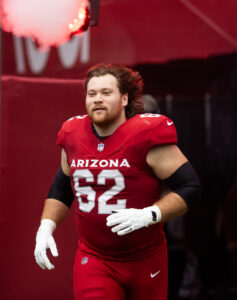 On the offensive line, 2024 saw another strong season from center Hjalte Froholdt and a phenomenal first season on the blind side by Paris Johnson Jr. After winning the starting job in camp, Brown held his own in his first season as a full-time left guard starter, and the versatile interior veteran earned another two years under contract, as a result.
On the offensive line, 2024 saw another strong season from center Hjalte Froholdt and a phenomenal first season on the blind side by Paris Johnson Jr. After winning the starting job in camp, Brown held his own in his first season as a full-time left guard starter, and the versatile interior veteran earned another two years under contract, as a result.
A knee injury in 2024 to last year’s biggest free agent addition, right tackle Jonah Williams, forced Beachum back into a starting role he had lost in 2023, and the returning backup tackle also earned another year of work for his efforts. This will be Beachum’s 14th NFL season.
The right guard position was thrown into disarray when Hernandez followed Williams onto injured reserve with a season-ending ACL tear. When the veteran guard received medical clearance, he did so as a free agent — his injury having occurred in a contract year. The team seemed to be moving on from Hernandez, with Isaiah Adams initially poised to win the right guard job after starting the final five games of last season at the position as a third-round rookie.
Ultimately, the team met with Hernandez to consider a reunion and re-signed him the next day, giving Arizona a potential starting five of Johnson-Brown-Froholdt-Hernandez-Williams with Beachum and Adams providing some extremely competent depth. Hernandez started his training camp on the active/PUP list, though, so Adams has had some time to push for a starting role. Hernandez was activated from the PUP list just before roster cuts, but he may still have to prove he’s healthy enough to start in front of Adams.
Also on offense, the Cardinals gave Jones a slight raise after an ineffective Year 1 with the team. The veteran receiver — who tallied an 82-catch, 823-yard, five-touchdown campaign for the Jaguars in 2022 — will certainly be expected to contribute more than the eight catches for 84 yards he put up in 2024. His start with the team, coming off a release from Jacksonville, was delayed by a five-game suspension, and he never recovered from the late start to put himself into a major offensive role. In Year 2 with the Cardinals, Jones will likely run as WR3 behind Harrison and Michael Wilson. 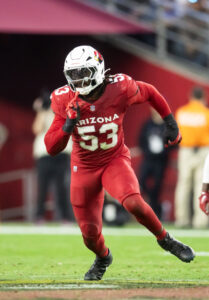
On defense, most of the contracts went to players from other teams, but Arizona did decide to bring back Browning and Collier on new deals. Despite Browning not receiving the opportunity to showcase much of his abilities coming off of a midyear trade from the Broncos, the Cardinals had their reasons for acquiring him, and those reasons likely led to his new two-year deal.
Browning had been seeking a starting role in Denver that he was not likely to get, and it seems Arizona was willing to give the former third-round pick more of a shot at one. They made it clear shortly after the season that they did not intend for him to be a half-season rental.
A former first-round pick out of TCU,Collier had not enjoyed much success since his only season as a full-time starter back in 2020. But he made a slight resurgence in 2024. Starting 15 of 17 Cardinals games, Collier tallied career highs in sacks (3.5) and tackles (29) while adding four tackles for loss and six QB hits for Arizona. The ex-Seahawk likely won’t return to a starting role due to the influx of talent on the line in free agency, but the Cardinals appreciated his contributions last year enough to bring him back on another deal.
Brewer, the longest-tenured member of the team since Larry Fitzgerald‘s retirement, has spent the last nine seasons as the Cardinals’ long snapper and will continue in that role for at least one more year. The team played a little roster Jenga at the 53-man deadline, cutting him so they could place defensive tackle Justin Jones on IR and sign Brewer back two days later. The 35-year-old has been playing on renewed one-year deals since 2022.
Notable losses:
- Krys Barnes, LB
- Jackson Barton, T
- Andre Chachere, S
- Trystan Colon, C
- Victor Dimukeje, OLB
- Dennis Gardeck, OLB
- Naquan Jones, DT
- Roy Lopez, DT
- Jesse Luketa, LB
- Julian Okwara, OLB
- Michael Palardy, P
- Zach Pascal, WR
- Matt Prater, K
- Khyiris Tonga, DT
- Kyzir White, LB
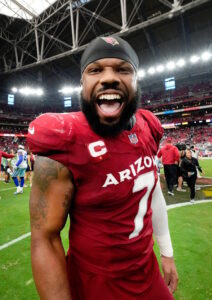 Seemingly confirmed by the names they signed, the Cardinals appeared more than willing to let several members of their 2024 defense walk in free agency. White played the second-most snaps last season of anyone on Arizona’s defense, but his being a liability in coverage made it an easier decision for Arizona, White remains on the market today. Lopez gave the Cardinals two decent seasons of, mostly, starting play after being waived by Houston. Like the team that drafted him, though, Arizona was fine letting him test the waters, and he landed in Detroit on a one-year, $3.5MM deal.
Seemingly confirmed by the names they signed, the Cardinals appeared more than willing to let several members of their 2024 defense walk in free agency. White played the second-most snaps last season of anyone on Arizona’s defense, but his being a liability in coverage made it an easier decision for Arizona, White remains on the market today. Lopez gave the Cardinals two decent seasons of, mostly, starting play after being waived by Houston. Like the team that drafted him, though, Arizona was fine letting him test the waters, and he landed in Detroit on a one-year, $3.5MM deal.
That was actually the largest contract any departing Arizona free agent landed, and no one earned a multiyear deal, either. Tonga, Gardeck, and Jones, three rotation players on last year’s defensive line, all earned one-year deals with the Patriots, Jaguars, and Chargers, respectively, on deals all worth $2.1MM or less. It was more of the same on offense as Colon landed just a one-year, $1.27MM deal in Detroit with Lopez after factoring in heavily amidst last year’s right guard issues.
On special teams, the Cardinals dismissed two veterans for younger options. Prater’s age-40 season was derailed when he was placed on IR after only four games, and it wasn’t uncovered until December that he had been working his way back from meniscus surgery to the knee on his plant leg. In Prater’s absence, the team relied on Chad Ryland, who had been waived by the Patriots after they drafted him in the 2023 fourth round.
 Ryland was made available due to an abysmal rookie year in which he missed two kicks from inside 40 yards, five kicks from inside 50 yards, and two more from 50-plus yards. Ryland was put into an offseason kicking competition with Joey Slye and waived in Patriots final roster cuts after failing to win the job last year. He landed a second chance in Arizona, though, and made the most of it, converting 87.5% of his field goal attempts and going 4-for-4 from 50-plus yards. Ryland is now Arizona’s full-time kicker.
Ryland was made available due to an abysmal rookie year in which he missed two kicks from inside 40 yards, five kicks from inside 50 yards, and two more from 50-plus yards. Ryland was put into an offseason kicking competition with Joey Slye and waived in Patriots final roster cuts after failing to win the job last year. He landed a second chance in Arizona, though, and made the most of it, converting 87.5% of his field goal attempts and going 4-for-4 from 50-plus yards. Ryland is now Arizona’s full-time kicker.
Palardy’s time in Arizona was the complete opposite of Prater’s last year. The 33-year-old lefty punter was brought in for the final four games of the season as regular punter Blake Gillikin was dealing with an ankle injury on his kicking leg. With Gillikin under contract for another year, there was no need to bring Palardy back.
Draft:
- Round 1, No. 16: Walter Nolen (DT, Ole Miss) (signed)
- Round 2, No. 47: Will Johnson (CB, Michigan) (signed)
- Round 3, No. 78: Jordan Burch (OLB, Oregon) (signed)
- Round 4, No. 115: Cody Simon (LB, Ohio State) (signed)
- Round 5, 174 (from Cowboys)*: Denzel Burke (CB, Ohio State) (signed)
- Round 6, No. 211 (from Cowboys)*: Hayden Conner (G, Texas) (signed)
- Round 7, No. 225 (from Jets through Chiefs): Kitan Crawford (S, Nevada) (signed)
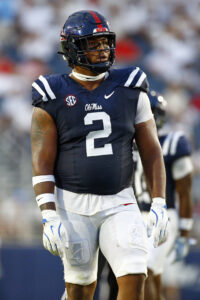 The leadup to the 2025 NFL Draft held plenty of intrigue around Arizona. In a first round that saw several teams itching to trade back, the Cardinals’ No. 16 overall pick seemed to be among the most likely targets for other clubs looking to move up. It was believed that, since the Cardinals were set to enter the draft with the third-fewest draft picks (six) of all 32 clubs, they would be open to listening to offers that could increase their draft capital. Throw in the fact that the Bengals were expected to be aiming for a pass rusher a pick later, and some thought teams who could be worried that Cincinnati would take their desired pass rusher would be dying to trade into Arizona’s slot.
The leadup to the 2025 NFL Draft held plenty of intrigue around Arizona. In a first round that saw several teams itching to trade back, the Cardinals’ No. 16 overall pick seemed to be among the most likely targets for other clubs looking to move up. It was believed that, since the Cardinals were set to enter the draft with the third-fewest draft picks (six) of all 32 clubs, they would be open to listening to offers that could increase their draft capital. Throw in the fact that the Bengals were expected to be aiming for a pass rusher a pick later, and some thought teams who could be worried that Cincinnati would take their desired pass rusher would be dying to trade into Arizona’s slot.
Intrigue continued as many speculated at which positions of need may be targeted first. Early sources indicated that pass rushers could be targeted, while later suggestions seemed to point to offensive line or wide receiver. Even before all that, though, the team had met with Johnson and Nolen, who were destined to join the team weeks later.
Nolen was the first to come off the board, proving that the Cardinals prioritized his addition to the team over accumulating more draft picks, though they would end up adding one draft pick later on. A day before the draft, Arizona found out about the Murphy-Bunting injury, and while Johnson had projected as a top-10 pick at one point, injury concerns allowed the Cardinals to pursue Nolen first and catch Johnson as their next priority in Round 2.
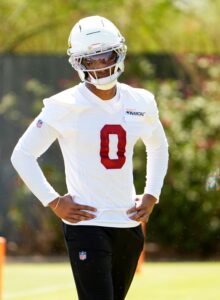 All the picks seem to uniquely fit the Cardinals’ current and future situation. Nolen missed a lot of training camp with injuries and will start his rookie year on the reserve/PUP list, but the team likely has no plans to rush him onto the field. With linemen, it can often be worthwhile to bring them up slowly anyway, and Nolen will get to learn as much as he can from Campbell before he retires, at which Nolen filling the new starting role can be a seamless transition.
All the picks seem to uniquely fit the Cardinals’ current and future situation. Nolen missed a lot of training camp with injuries and will start his rookie year on the reserve/PUP list, but the team likely has no plans to rush him onto the field. With linemen, it can often be worthwhile to bring them up slowly anyway, and Nolen will get to learn as much as he can from Campbell before he retires, at which Nolen filling the new starting role can be a seamless transition.
Johnson and Burke are other examples of perfect fits for now and later as they help fill out a desperately thinned secondary with potential for bigger roles in the future. The same is essentially true of the other draft picks, as well; none are expected to come in and start Week 1, but all are in positions to make an impact at positions that need it. While they may not make up the majority of snaps in 2025, this group could feature numerous starters by 2026 or 2027.
Other:
Luckily, the Cardinals avoided too much turnover on their coaching staff. Though, they weren’t completely spared. After serving two seasons as Arizona’s O-line coach, Adams took over as the Cowboys’ OC. Frye is making his NFL coaching debut, replacing Adams after coaching lines at Temple, Boston College, UCLA, and Ohio State. He also served as Bruins offensive coordinator for three seasons.
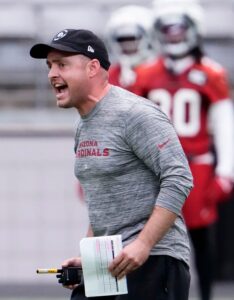 Petzing was among the first to interview for the open job in Chicago that ended up with former Lions offensive coordinator Ben Johnson winning the job. Woolfork didn’t end up interviewing with the Bears, choosing instead to stay with Petzing in Arizona.
Petzing was among the first to interview for the open job in Chicago that ended up with former Lions offensive coordinator Ben Johnson winning the job. Woolfork didn’t end up interviewing with the Bears, choosing instead to stay with Petzing in Arizona.
Elsewhere on the coaching staff, linebackers coach Sam Siefkes left to become the defensive coordinator for Virginia Tech, and defensive line coach Derrick LeBlanc‘s contract was allowed to expire. Joining them on the way out this summer was pass-game specialist Spencer Whipple, who became the Jaguars’ QBs coach. To replace them all, Winston DeLattiboudere and Cristian Garcia were hired to serve as defensive line and linebackers coaches, and Conner Senger was elevated from his quality control role to replace Whipple. Lastly, Matt Feeney was hired as a new OLBs coach.
While the front office avoided much turnover, Bidwill continued to appear in unfavorable headlines. The owner’s name made the rounds in February as a defendant in a civil suit with numerous allegations. In the summer, as details began to surface on the NFL ownership collusion scandal, Bidwill was once again front and center as leaked texts between him and another team owner (the Chargers’ Dean Spanos) appeared to show a shared initiative.
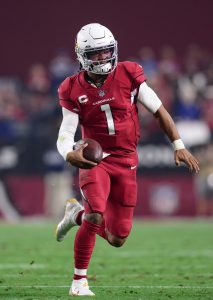 Moving to the players, following his ACL recovery, there were concerns on how Murray’s future would play out in Arizona. With all of the money on his contract that was fully guaranteed at signing being paid out, the opportunity existed for the Cardinals to avoid paying other guarantees by releasing Murray from the team. The rolling guarantee structure the QB secured back in summer 2022 will once again benefit him.
Moving to the players, following his ACL recovery, there were concerns on how Murray’s future would play out in Arizona. With all of the money on his contract that was fully guaranteed at signing being paid out, the opportunity existed for the Cardinals to avoid paying other guarantees by releasing Murray from the team. The rolling guarantee structure the QB secured back in summer 2022 will once again benefit him.
On March 17, Murray was still on the roster; this status fully guaranteed his $22.84MM 2026 base salary as well as a $17MM 2026 90-man roster bonus. Murray is set to lead the team for a seventh season, as this offseason’s guarantee will make it more difficult for the Cardinals to move on next year as well. The two-time Pro Bowler, now 28, also revealed his desire to take more opportunities to tuck the ball and run more in 2025.
On defense, a couple of players suffered injuries that will significantly impact their campaigns. First, returning starting cornerback Murphy-Bunting suffered his aforementioned knee setback — one that led him to the reserve/NFI list in May — followed by Thomas’ own ACL tear two months later. Russell, a free agent LB addition this offseason, will miss his debut season in Arizona. He was carted off the field in a scary moment that saw him suffer a concussion in training camp, and the team placed him on IR with no designation to return.
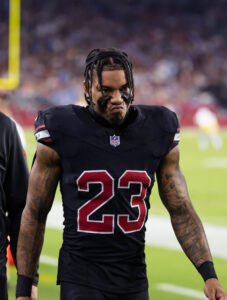 Arizona’s cornerback contingent presently consists of Johnson, 2024 second-round pick Max Melton, slot cog Williams, and expected backups Burke, 2024 third-round pick Elijah Jones, and third-year performer Kei’Trel Clark. The team used Murphy-Bunting as a full-time starter last season, after having given the ex-Buccaneers and Titans regular a three-year, $25.5MM deal in March 2024. Thomas worked as a 15-game starter last year, logging a 75% snap rate on defense in his second season.
Arizona’s cornerback contingent presently consists of Johnson, 2024 second-round pick Max Melton, slot cog Williams, and expected backups Burke, 2024 third-round pick Elijah Jones, and third-year performer Kei’Trel Clark. The team used Murphy-Bunting as a full-time starter last season, after having given the ex-Buccaneers and Titans regular a three-year, $25.5MM deal in March 2024. Thomas worked as a 15-game starter last year, logging a 75% snap rate on defense in his second season.
These losses will bring significant change for the Cards’ CB corps, with Johnson expected to play a central role as a rookie. As the team hopes the Michigan product can live up to his previous status as an expected first-round pick, Arizona’s corner crew will roll into the season with no players with more than two years’ worth of experience (and Jones spent his rookie year on IR). Although cornerback is a young man’s game, deploying a group with such little experience will be a storyline to monitor as Gannon’s third HC season begins.
Ultimately, only six Cardinals rookies made the initial 53-man roster out of the 13-man draft/UDFA class. One landed on IR (with a designation to return), another on the reserve/PUP list; two others made the practice squad.
Top 10 cap charges for 2025:
- Kyler Murray, QB: $43.33MM
- Jonah Williams, T: $16.06MM
- Jalen Thompson, S: $13.73MM
- Justin Jones, DT: $11.35MM
- Budda Baker, S: $10.82MM
- Trey McBride, TE: $9.57MM
- Marvin Harrison Jr., WR: $8.04MM
- Bilal Nichols, DT: $7.83MM
- Paris Johnson, T: $7.65MM
- Dalvin Tomlinson, DT: $7.64MM
It is hard to gauge what success would look like at the end of the 2025 season in Arizona. It’s fair to say that continued improvement is certainly expected, but it is difficult to predict just how much the upgrades on defense and maintenance of the offense will do amid an evolving NFL. Seattle and Los Angeles’ offseasons may not have seen as much improvement as Arizona’s, but a healthy San Francisco squad isn’t likely to finish at the bottom of the division again.
Ultimately, the Cardinals can only focus on the road in front of them, and with the sixth-easiest schedule in the NFL this year (based on last year’s records), Arizona has a chance to make a run for the playoffs for the first time since 2021. With very few key players in contract years in 2025, though, this could be a year that allows the team to judge just how close it is to contention in its third season under this leadership structure. That critical evaluation will help shape the outlook for 2026 as the franchise continues a journey toward hopeful Super Bowl contention under its current leadership structure.
By Nikhil Mehta |
at August 30, 2025 10:40 pm
In 2024, the Buccaneers won their fourth straight NFC South title – a feat dimmed by the division’s struggles in recent years – but lost in the wild-card round. The team again opted for continuity this offseason, extending general manager Jason Licht and head coach Todd Bowles. The Bucs also rewarded quarterback Baker Mayfield with more guaranteed money after back-to-back Pro Bowl seasons.
Licht retained key talent – including star wide receiver Chris Godwin on a hometown discount – and stocked up on premium positions in the draft. With succession plans in place for the starters who departed in free agency, the team’s biggest loss this offseason was not a player, but a coach: offensive coordinator Liam Coen. He left Tampa to take the head coaching job in Jacksonville after a back-and-forth saga that may have frustrated the team’s decision-makers. Can replacement Josh Grizzard — the Bucs’ fourth play-caller in four years — keep the the offense in high gear as a pursuit of a fifth straight division title begins?
Extensions and restructures:
The Buccaneers made multiple moves with Mayfield’s contract this offseason, starting with a traditional restructure in April. The team converted $18MM of Mayfield’s $30MM salary to a signing bonus that reduced his cap hit by $14.4MM and added $3.6MM to the four remaining years of the deal.
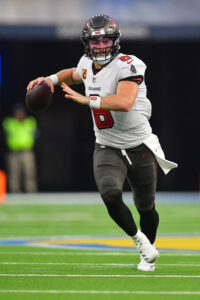 A few months later, Licht expressed a desire to keep Mayfield past the end of his contract in 2026, but no extension materialized. Instead, Tampa Bay converted $30MM of his 2026 salary into two roster bonuses.
A few months later, Licht expressed a desire to keep Mayfield past the end of his contract in 2026, but no extension materialized. Instead, Tampa Bay converted $30MM of his 2026 salary into two roster bonuses.
The first, worth a fully guaranteed $13MM, is due in 2026 but will prorate across the team’s salary cap starting in 2025. That decreased Mayfield’s cap hit by $10.4MM in 2026 with $2.6MM added to 2025 and each of the three void years after 2026 (via OverTheCap). The second roster bonus is worth $17MM and guarantees in early 2026, per Pewter Report’s Joshua Quiepo.
As a result of these moves, Mayfield’s 2025 cap hit decreased by $11.8MM (to $26.48MM) and his 2026 cap hit decreased by $6.8MM (to $38.98MM). The Bucs also pushed $18.6MM into void years that increased the dead money scheduled to hit the team’s 2027 salary cap to $30.15MM. For a Bucs team that needed to swim in the shallow end of the QB pool in 2023 — thanks to the Tom Brady $35MM retirement bill brought on by void years — a clear incentive exists to extend Mayfield before that point.
Tampa Bay isn’t necessarily tied to Mayfield in 2026 by these contract restructures, but the tweaks indicate the team is planning for him to start for at least two more years. The release of 2021 second-round pick Kyle Trask and the Bucs’ subsequent signing of once-retired Teddy Bridgewater as their new backup were additional signals that Mayfield would keep his job through 2026.
Mayfield, meanwhile, received $30MM in new guarantees along with an improved cashflow, both well-deserved rewards for an elite 2024. He originally signed with the Buccaneers in 2023 on a $4MM “prove it” deal and blew expectations out of the water with his first 4,000-yard season. That earned him his current three-year, $100MM contract — agreed to a day before the 2024 legal tampering period — that seemed like a good value at the time and aged well for the Bucs after just one year. Mayfield has seen Sam Darnold and Geno Smith eclipse his middle-class QB terms, and the Bucs appear prepared to enter into extension talks before his deal expires.
Among all quarterbacks in 2024, Mayfield ranked third in passing yards (4,500), second in passing touchdowns (41), and fourth in passer rating (106.8), all career-best marks. He did also throw a league-high 16 interceptions, but that didn’t stop him from earning the first MVP votes of his career. With his contract up after 2026, a similar performance this season will put the 30-year-old passer in a strong negotiating position next offseason.
Free agency additions:
- Haason Reddick, OLB. One year, $14MM ($12MM guaranteed)
- Riley Dixon, P. One year, $3MM ($3MM guaranteed)
- Kindle Vildor, CB. One year, $1.34MM, ($1.2MM guaranteed)
- Charlie Heck, T. One year, $1.57MM, ($400K guaranteed)
- Teddy Bridgewater, QB. One year, $1.26MM
The Buccaneers’ only major free agency addition was a dice roll on Haason Reddick with the hopes that he can recapture his pre-Jets form. Reddick’s holdout limited him to 10 disappointing games in 2024, with only one sack, but he reached double-digit sacks in each of his previous four seasons.

That production came with three different teams, so there’s hope that Reddick can quickly acclimate to Tampa Bay’s defense and consistently impact opposing quarterbacks. However, his 7.6% pass rush win rate in 2024 was almost half his 14.0% win rate in 2023, per Pro Football Focus (subscription required).
Still, Reddick could be worth the risk with the rest of Tampa Bay’s pass rushers returning in 2025 including ascending talents YaYa Diaby and Calijah Kancey, both of whom contributed 7.5 sacks last season. Diaby’s official contributions – which also included 11 tackles for loss – somewhat underrepresent his pass-rushing performance; he was credited with 70 pressures (via PFF), tied with Micah Parsons and Greg Rousseau for seventh-most among edge rushers last year. Kancey, meanwhile, took a clear step forward from his four-sack rookie year and will look to pair with the always-imposing Vita Vea as an disruptive pair of defensive linemen.
This season will determine if Reddick can return to the upper echelon of EDGE earners, as last year’s failed holdout proved costly. As the position’s market exploded via the Parsons, Myles Garrett and T.J. Watt deals, Reddick was not in a realistic position to command more than what he did.
Despite Reddick powering an Eagles pursuit at the 1984 Bears’ single-season sack record in 2022, Philadelphia chose Josh Sweat over him to build around in 2024. Amid constant ownership intervention, then-Jets GM Joe Douglas balked at a post-trade extension largely due to Reddick’s age. Set to turn 31 in September, the former first-round pick faces a crucial year regarding his future value. In addition to Watt’s megadeal, Danielle Hunter scored another big guarantee at 31. Reddick will attempt to cash in again on the back of a strong Bucs season, potentially joining fellow accomplished (and disgruntled) 30-something Trey Hendrickson on the 2026 market.
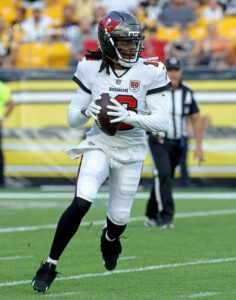 The only other starter signed in free agency was veteran punter Riley Dixon. The Buccaneers cycled through three punters in 2024, none of whom cleared 40 net yards per punt, so they opted for reliability in the 32-year-old Dixon. The 10th-year veteran’s fully guaranteed $3MM deal quickly looked like an excellent value after the positional market eclipsed $4MM later in the offseason. He will look to add some consistency to Tampa Bay’s special teams operations this year.
The only other starter signed in free agency was veteran punter Riley Dixon. The Buccaneers cycled through three punters in 2024, none of whom cleared 40 net yards per punt, so they opted for reliability in the 32-year-old Dixon. The 10th-year veteran’s fully guaranteed $3MM deal quickly looked like an excellent value after the positional market eclipsed $4MM later in the offseason. He will look to add some consistency to Tampa Bay’s special teams operations this year.
Bridgewater has replaced Trask as Mayfield’s backup. This will be the Miami native-turned-high school coach’s eighth NFL team. The former Vikings first-rounder unretired last year to rejoin the Lions, replacing Hendon Hooker as Detroit’s QB2 late in the season. Bridgewater should probably be considered an upgrade on Trask, even if he is a year-to-year proposition at this point. Mayfield has proven durable in Tampa, making every start since his 2023 signing, but he has run into injury trouble in the past.
Bridgewater, 32, has made 65 career starts. Although Trask competed with Mayfield for the Bucs’ 2023 starting job, the team asking Bridgewater to come in late in the offseason reflects a lack of faith in the former second-round pick.
Re-signings:
- Chris Godwin, WR. Three years, $66MM ($44MM guaranteed)
- Ben Bredeson, G. Three years, $22MM ($12.5MM guaranteed)
- Lavonte David, ILB. One year, $9MM ($9MM guaranteed)
- Anthony Nelson, OLB. Two years, $10MM ($4.5MM guaranteed)
- Greg Gaines, DT. One year, $3.5MM ($3MM guaranteed)
- Sterling Shepard, WR. One year, $1.5MM, ($500K guaranteed)
 Godwin started the 2024 season on pace for a career year before a dislocated ankle in Week 7 forced him to undergo season-ending surgery. At the time of the injury, Godwin’s 576 yards ranked second in the NFL. Despite an uncertain return timeline, he was expected to draw heavy interest in free agency, even with several other well-regarded veterans hitting the market. A February agreement to delay the void date on Godwin’s contract was an early sign that he would stay in Tampa Bay, but the Patriots and the Steelers — among other teams — tried to change his mind.
Godwin started the 2024 season on pace for a career year before a dislocated ankle in Week 7 forced him to undergo season-ending surgery. At the time of the injury, Godwin’s 576 yards ranked second in the NFL. Despite an uncertain return timeline, he was expected to draw heavy interest in free agency, even with several other well-regarded veterans hitting the market. A February agreement to delay the void date on Godwin’s contract was an early sign that he would stay in Tampa Bay, but the Patriots and the Steelers — among other teams — tried to change his mind.
New England came in with a $30MM-AAV offer that would have made Godwin the sixth-highest-paid receiver in the league. Pittsburgh also expressed interest before pivoting to D.K. Metcalf. But Godwin declined to chase the biggest check and agreed to a three-year, $66MM extension hours before the legal tampering window opened on March 10.
The decision was a clear act of loyalty by the longtime Buccaneer, who began his NFL career in Tampa as a third-round pick in 2017. He was franchise-tagged twice at the end of his rookie deal and reached a $20MM-AAV extension off the second tag in 2022. His new deal is an increase of just $2MM per year, lagging well behind cap inflation and the receiver market as a whole. After all of the offseason dust settled, Godwin’s $22MM average salary only ranked 21st among all wideouts. Though, his $44MM in fully guaranteed money is a top-10 figure.
Read more
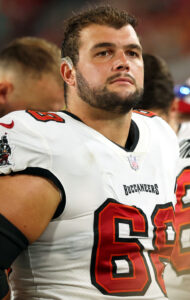 This also marked the second time the Bucs paid Godwin after a major injury. ACL and MCL tears sustained in December 2021 preceded his second Tampa Bay franchise tag, and the team showed faith via the March 2022 extension. But the perennial Mike Evans sidekick will not be ready for Week 1 like he was three years ago.
This also marked the second time the Bucs paid Godwin after a major injury. ACL and MCL tears sustained in December 2021 preceded his second Tampa Bay franchise tag, and the team showed faith via the March 2022 extension. But the perennial Mike Evans sidekick will not be ready for Week 1 like he was three years ago.
Godwin’s injury outlook remained unclear throughout the offseason, but he was able to pass a physical before final roster cuts and will begin the season on the Buccaneers’ 53-man roster. Even though the 29-year-old wideout — the second-leading receiver in franchise history — avoided the reserve/PUP list, he is not expected to play until October.
Bredeson earned the Bucs’ starting left guard job on a “prove it” deal in 2024 and played almost every snap in the regular season. However, he finished as one of PFF’s lowest-graded players at the position and accepted a below-market deal to stay in Tampa Bay. The Buccaneers seemed to agree that he struggled by offering him just $7.33MM per year, only the 27th-highest AAV among guards.
Bredeson’s deal still marked a sizable raise, as it includes $12.5MM in fully guaranteed money. The deal guaranteed Bredeson $5MM of his 2026 salary, giving him some security for another year. The Buccaneers will be hoping that continuity along the interior of the offensive line with center Graham Barton and right guard Cody Mauch can help Bredeson improve into a long-term starter. If he does, his contract would become an excellent value, but another poor year could lead Tampa Bay to seek an improvement next offseason.
 After considering retirement, David decided to return for his 15th season in Tampa. David drew outside interest in free agency, but there was little question that he would stay with his only NFL team.
After considering retirement, David decided to return for his 15th season in Tampa. David drew outside interest in free agency, but there was little question that he would stay with his only NFL team.
David’s fully guaranteed one-year, $9MM deal, signed on March 7, matched that of fellow 2012 draftee Bobby Wagner, who re-signed with the Commanders a day earlier. (The pair of former All-Pros are two of 11 players left from their draft class.) David has logged 198 starts for the Buccaneers, meaning he is all but certain to cross the rare 200-game mark in 2024. The stalwart second-level defender sits comfortably in third for all-time Bucs starts (behind Hall of Famers Ronde Barber and Derrick Brooks).
This year could be a swan song for the 35-year-old linebacker. He has been somewhat underrated in his career, earning a Pro Bowl nod only once (2015) and All-Pro recognition (first-team in 2013, second-team in 2016 and 2020). He also achieved the ultimate goal with a Super Bowl victory, also in 2020. Though David may lack the resume for the Hall of Fame — though, a case could emerge one day — he is an obvious candidate to join the Buccaneers’ Ring of Honor after his retirement.
Notable losses:
- Shaquil Barrett, OLB
- K.J. Britt, ILB
- Jack Browning, P (waived)
- Mike Edwards, S
- Robert Hainsey, C
- Royce Newman, G
- Justin Skule, T
- Tavierre Thomas, DB
- Kyle Trask, QB (released)
- Jordan Whitehead, S (option bonus declined)
At this point, Barrett’s name probably means more than his impact. He was never quite the same after tearing his Achilles in 2022, his age-30 season. He recovered in time to start 16 games in 2023, but his production waned and the Buccaneers made him a 2024 cap casualty to wrap a five-season stint.
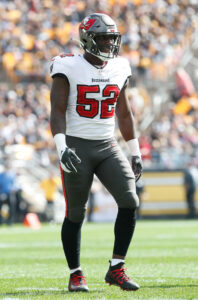 Barrett then signed with the Dolphins during the 2024 offseason before abruptly retiring over the summer. He changed his mind during the regular season, but Miami wasn’t willing to reactivate him. He was eventually released and re-signed with the Buccaneers but only played 17 snaps in two appearances (including the playoffs). Barrett has declared an intention to play in 2025, but there’s been no news on that front since April.
Barrett then signed with the Dolphins during the 2024 offseason before abruptly retiring over the summer. He changed his mind during the regular season, but Miami wasn’t willing to reactivate him. He was eventually released and re-signed with the Buccaneers but only played 17 snaps in two appearances (including the playoffs). Barrett has declared an intention to play in 2025, but there’s been no news on that front since April.
A 2021 fifth-round pick, Britt cut his teeth on special teams before breaking into the starting lineup at the end of his third year. He started 11 of his 14 appearances in 2024, but made few impact plays. His spot next to David will be filled by 2023 fifth-rounder SirVocea Dennis. He appeared to be on the verge of overtaking Britt last year before a shoulder injury forced him onto injured reserve, ultimately ending his season. In free agency, Britt signed a veteran-minimum deal with the Dolphins.
Browning was one of the Bucs’ three struggling punters in 2024. He was retained on the roster entering the offseason, but one day after the team signed Dixon, it waived Browning.
Hainsey, a 2021 third-rounder, converted from tackle to center as a rookie and stepped into a starting role the following year after Ryan Jensen‘s career-altering knee injury. Hainsey started every game in 2022 and 2023 but failed to impress the team’s decision-makers. In the offseason, they used a first-round pick on Hainsey’s replacement, Duke center Graham Barton, making it clear that the the fourth-year lineman would be hitting free agency after the season. In free agency, Hainsey followed Liam Coen to the Jaguars on a three-year, $21MM deal.
 Newman entered the 2024 season as the Bucs’ backup guard, but healthy seasons from Bredeson and Mauch kept him on the sidelines for most of the year. Skule, the team’s swing tackle, played a more important role with four starts on the right side and one on the left. He’ll fill the same role in Minnesota this year.
Newman entered the 2024 season as the Bucs’ backup guard, but healthy seasons from Bredeson and Mauch kept him on the sidelines for most of the year. Skule, the team’s swing tackle, played a more important role with four starts on the right side and one on the left. He’ll fill the same role in Minnesota this year.
Thomas, 29, was a core special teams contributor for Tampa Bay last season. Between his lack of defensive role and the team’s desire to get younger at cornerback combine, it wasn’t surprising to see him depart in free agency. Like Skule, he’s taken his talents to Minnesota.
In 2024, Whitehead returned to Tampa, the team that drafted him in 2018, after a two-year sojourn with the Jets. He stepped back into a starting role next to All-Pro Antoine Winfield Jr. with then-rookie Tykee Smith dropping into the slot.
Whitehead started 11 games before a four-week stint on injured reserve for a pectoral injury. He returned to start in Week 17 before a car accident forced him to end the year on the non-football injury list. Tampa Bay declined to pick up his option bonus as a result of his medical situation, making him a free agent. Whitehead has since been medically cleared, but he’s still searching for his next club. The Buccaneers, meanwhile, are moving Smith back to a more traditional safety role with rookie Jacob Parrish expected to man the slot.
Draft:
- Round 1, No. 19: Emeka Egbuka (WR, Ohio State) (signed)
- Round 2, No. 53: Benjamin Morrison (CB, Notre Dame) (signed)
- Round 3, No. 84: Jacob Parrish (CB, Kansas State) (signed)
- Round 4, No. 121: David Walker (OLB, Central Arkansas) (signed)
- Round 5, No. 157: Elijah Roberts (OLB, SMU) (signed)
- Round 7, No. 235: Tez Johnson (WR ,Oregon) (signed)
 The Buccaneers kept their interest in Egbuka under wraps before selecting him with the 19th overall pick in April’s draft. Receiver didn’t seem like a primary need with the offense returning its top seven pass catchers from last season. Tampa Bay had already extended Mike Evans in 2024 and re-signed Chris Godwin before the draft. Third-round pick Jalen McMillan also showed promise as a rookie, averaging 4.8 receptions and 63.2 yards over the last four weeks of the season.
The Buccaneers kept their interest in Egbuka under wraps before selecting him with the 19th overall pick in April’s draft. Receiver didn’t seem like a primary need with the offense returning its top seven pass catchers from last season. Tampa Bay had already extended Mike Evans in 2024 and re-signed Chris Godwin before the draft. Third-round pick Jalen McMillan also showed promise as a rookie, averaging 4.8 receptions and 63.2 yards over the last four weeks of the season.
Regardless, Licht went after the team’s top-ranked target in Egbuka, a three-year starter at Ohio State, a program known for producing elite NFL receiving talent. His resume included a pair of 1,000-yard, 10-touchdown seasons and an all-around skillset from the slot that could fit in many NFL offenses. Leaving Columbus as the powerhouse program’s all-time receiving leader, the 6-foot-1 wideout drew interest from the Broncos, Texans, and Rams, but the Bucs were positioned ahead of them all at No. 19.
Evans’ game seems ageless, and Godwin was playing some of the best football of his career before going down last year. However, Evans is 31 years old and Godwin is coming off the second major injury of his career. They might represent the present of the Bucs’ receiver room, but Egbuka represents the long-term future.
Egbuka will be needed early, as Godwin and McMillan will be on the shelf to start the season. The Bucs stashed McMillan on IR after he suffered a “severely sprained neck” in the team’s preseason finale. The 2024 third-round pick, who scored seven touchdowns in Tampa Bay’s final five games last season, will miss extensive 2025 time.
Morrison was considered a potential first-round pick heading into the 2024 season, his third at Notre Dame. A season-ending labral hip tear fueled concerns about his injury history, which featured a similar injury in high school and shoulder surgery in March 2024. That dropped Morrison to the Buccaneers in the second half of Round 2.
 He recovered from his hip surgery in time for training camp and may have had a chance to push fourth-year corner Zyon McCollum for a starting job if not for a hamstring injury. Morrison was sidelined for all three preseason games and may not be ready for Week 1. Availability always presented a risk in drafting Morrison. Missing so much of training camp will make it hard for the CB prospect to carve out a role early in the year, but if his hamstring issue proves to be minor, he could get on the field later in the season.
He recovered from his hip surgery in time for training camp and may have had a chance to push fourth-year corner Zyon McCollum for a starting job if not for a hamstring injury. Morrison was sidelined for all three preseason games and may not be ready for Week 1. Availability always presented a risk in drafting Morrison. Missing so much of training camp will make it hard for the CB prospect to carve out a role early in the year, but if his hamstring issue proves to be minor, he could get on the field later in the season.
Parrish primarily played on the outside at Kansas State but was projected by some draft experts to slide into the slot. The Buccaneers had the same vision, drafting Parrish in the third round and quickly converting him into a nickel. He emerged as a potential starter in spring practices and appears to have secured the job heading into the regular season.
The Buccaneers will be hoping Morrison can stay healthy and start opposite Jamel Dean on the boundary in 2026. That would likely keep Parrish as the starting nickel. However, if Morrison’s injury woes continue, Parrish could emerge as a full-time starter in his second season. He could return to his college position in base personnel and bump inside for nickel and dime formations.
Other:
After taking the Bucs’ offensive coordinator job in 2024, Coen emerged as one of the Sean McVay disciples to find success in the NFL. He was lauded for continuing Baker Mayfield’s midcareer ascent and helping to ensure the Buccaneers had a post-Brady future under center. That drew the attention of the Jaguars, who launched a massive search for a new head coach after moving on from Doug Pederson.
 Like Jacksonville’s other top candidates, Coen considered the continued presence of general manager Trent Baalke to be a poison pill for his interest in the job. He turned down a second interview and quickly agreed to terms with the Buccaneers to join the ranks of the NFL’s highest-paid coordinators. Jaguars owner Shad Khan was undeterred and removed Baalke in the hopes of reviving his chances with his preferred future coach.
Like Jacksonville’s other top candidates, Coen considered the continued presence of general manager Trent Baalke to be a poison pill for his interest in the job. He turned down a second interview and quickly agreed to terms with the Buccaneers to join the ranks of the NFL’s highest-paid coordinators. Jaguars owner Shad Khan was undeterred and removed Baalke in the hopes of reviving his chances with his preferred future coach.
Suddenly holding enormous leverage, Coen was drawn back into negotiations in Jacksonville. That set off a dramatic day of reports about Coen’s physical location and communication with the Buccaneers. A round of secret Jaguars negotiations ensued. Ultimately, the Jags made an offer that Coen couldn’t refuse: a $13MM per year salary and the ability to choose the next general manager. He said yes.
The Buccaneers were understandably frustrated by Coen’s back-and-forth, especially after he twice delayed the signing of his new Tampa Bay OC contract. He told Licht and assistant general manager Mike Greenberg that he was handling a personal matter; in reality, he was finalizing his deal with the Jaguars.
 As a result, Tampa Bay didn’t allow any of their assistant coaches to follow Coen to Jacksonville. Coen also tried to poach Greenberg as his handpicked GM, a move the Bucs could not block. The Jaguars requested an interview, but a day later, the longtime Bucs cap guru informed them he would stay in Tampa.
As a result, Tampa Bay didn’t allow any of their assistant coaches to follow Coen to Jacksonville. Coen also tried to poach Greenberg as his handpicked GM, a move the Bucs could not block. The Jaguars requested an interview, but a day later, the longtime Bucs cap guru informed them he would stay in Tampa.
The Bucs interviewed a series of OC candidates before installing Grizzard, their 2024 pass-game coordinator, as Coen’s replacement. Grizzard was a somewhat unexpected hire given that he only arrived in Tampa the year prior.
Grizzard spent his first seven seasons as an NFL coach in Miami and survived multiple head coaching changes. Mike McDaniel retained him in 2022 and the two found new ways to unleash Tyreek Hill and quickly developed Jaylen Waddle into a worthy No. 2. Grizzard joined the Bucs’ staff in 2024; in his first year, Mayfield and the passing offense as a whole ranked among the best in the league.
As OC, he will be challenged right away with Godwin and Wirfs both sidelined to start the regular season. This technically represents continuity for Mayfield, as Grizzard was on staff last season. But the former No. 1 overall pick will be tied to a sixth play-caller since 2021. Mayfield helped Coen and Dave Canales climb to HC positions; the Bucs will hope that string halts at least for a year in an effort to give their quarterback overdue continuity.
A few months after the Coen dust settled, the Bucs continued to show faith in Licht and Bowles. The length of Licht’s extension remains unknown, but Bowles’ added three years to his deal, keeping him in Tampa Bay until 2028.
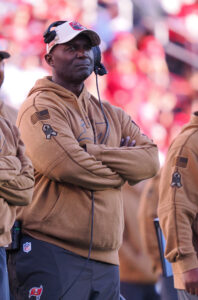 Licht has grown into one of the NFL’s best GMs since he took the job in 2014. He was an inconsistent drafter in his first few years but seemed to figure it out in 2018. Since then, he has been one of the best talent evaluators in the league. In 2025, a league-high 82.5% of the Bucs’ 53-man roster consists of homegrown talent, per OverTheCap’s Jason Fitzgerald.
Licht has grown into one of the NFL’s best GMs since he took the job in 2014. He was an inconsistent drafter in his first few years but seemed to figure it out in 2018. Since then, he has been one of the best talent evaluators in the league. In 2025, a league-high 82.5% of the Bucs’ 53-man roster consists of homegrown talent, per OverTheCap’s Jason Fitzgerald.
However, Licht struggled to stabilize the team’s quarterback situation. He drafted Jameis Winston with the No. 1 overall pick in 2015, but his rollercoaster performance under center kept the team out of the playoffs for the duration of his rookie deal. Then, opportunity struck.
Licht had already coaxed Bruce Arians out of retirement in 2019, and in 2020, he seized the chance to sign Tom Brady. Finally building around a championship-caliber QB, Licht quickly stocked the Bucs’ roster with veteran talent. Combined with recent hits in the draft – including home-run picks in rookies Wirfs and Antoine Winfield Jr. – Tampa Bay journeyed to a Super Bowl. The team tried to run it back with Arians, Brady and its entire Super Bowl starting lineup in 2021 but lost in the divisional round.
Arians’ mid-offseason 2022 retirement gave Bowles the chance to step back into a head coaching role after coordinating some excellent Bucs defenses dating back to 2019. He essentially held onto the DC role as well. The second-chance HC has fended off job security-based rumors and is now on OC No. 4 in four years, but the Bucs have continued to book playoff berths on their sideline leader’s watch.
Brady retired after Tampa Bay lost in the 2022 wild-card round, but Licht and Bowles quickly retooled by signing Mayfield and hiring Coen. Both turned out to be sound decisions as the Buccaneers won the third and fourth division titles in a row in 2023 and 2024.
Top 10 cap charges for 2025:
- Baker Mayfield, CB: $26.48MM
- Mike Evans, WR: $25.36MM
- Vita Vea, NT: $22.47MM
- Jamel Dean, CB : $15.14MM
- Haason Reddick, EDGE: $13.18MM
- Chris Godwin, WR: $12.39MM
- Tristan Wirfs, OT: $11.5MM
- Antoine Winfield, S: $9.14MM
- Lavonte David, LB: $9MM
- Calijah Kancey, DT: 3.95MM
Although the Bucs pushed the Lions in the ’23 divisional round, they have remained a second-tier contender since Brady’s final season. Wirfs’ expected early-season return will give the team all five of its offensive line starters back, and even with McMillan down with the concerning neck injury, Mayfield having an Evans-Godwin-Egbuka trio to target presents a quality setup in Grizzard’s first play-calling year. There are plenty of reasons for optimism in Tampa.
The NFC South might not be as much of a cakewalk with intriguing young offenses in Atlanta and Carolina, but the Buccaneers remain the favorites to win the division. Once again, their true test will likely come in the playoffs. It will be interesting to see if Mayfield, the Super Bowl LV holdovers and Licht’s collection of younger talent can help move the Bucs onto the Super Bowl LX radar.
By Sam Robinson |
at August 23, 2025 10:45 pm
Hovering near the bottom of most power rankings entering last season, the Broncos overcame a record-setting Russell Wilson dead money anchor to make a surprising playoff berth. Viewed as a reach by many, Bo Nix played the lead role in the Broncos snapping an eight-year postseason drought. Nix’s strong finish to his rookie year also provided a ray of hope Denver has finally solved a quarterback issue that had lingered since Peyton Manning‘s retirement.
The Broncos did benefit from drawing the NFC South last season, sweeping the division en route to a 10-7 record. Denver went 2-7 against teams with winning records, and while the team’s showing in Kansas City pointed to the eventual AFC champions having a tough assignment in Week 18 even had they played starters, Sean Payton‘s third Broncos squad has questions to answer about navigating over-.500 opposition. But addressing deficiencies in free agency and the draft have moved the Broncos into a better place roster-wise, creating considerable optimism compared to where they stood entering the past two seasons.
Extensions and restructures:
The Broncos did well to pay Sutton before the 2022 wide receiver market transformation, locking down one of their key pass catchers on a four-year extension worth $60MM in November 2021. Sutton did not approach 1,000 yards in 2021 or ’22, but Denver’s offensive struggles as a whole dragged down its receivers in those years. Jerry Jeudy did not make a step forward in Payton’s offense in 2023, but Sutton reestablished himself as the team’s top target by hauling in 10 touchdown receptions — a few of which of the acrobatic variety — to help Wilson (to a degree, at least) bounce back from a career-reshaping 2022. This came during an endless run of Sutton trade rumors, buzz that did not stop until after the 2024 deadline.
 Denver discussed Sutton in 2022 deals and dangled him during the ensuing offseason, with Baltimore talks nearly producing a March 2023 swap. Odell Beckham Jr.‘s Ravens interest may have changed the Broncos’ WR plans, as the AFC North team backed off Sutton. The Broncos had sought a second-round pick for the 2018 second-rounder and a first for Jeudy, but they ended up selling low on Jeudy (fifth- and sixth-rounders) in March 2024. The Broncos stuck with Sutton and prioritized him to the point they declined a third-round offer from the 49ers, who would have added Sutton as part of a three-team Brandon Aiyuk trade with the Steelers in August 2024.
Denver discussed Sutton in 2022 deals and dangled him during the ensuing offseason, with Baltimore talks nearly producing a March 2023 swap. Odell Beckham Jr.‘s Ravens interest may have changed the Broncos’ WR plans, as the AFC North team backed off Sutton. The Broncos had sought a second-round pick for the 2018 second-rounder and a first for Jeudy, but they ended up selling low on Jeudy (fifth- and sixth-rounders) in March 2024. The Broncos stuck with Sutton and prioritized him to the point they declined a third-round offer from the 49ers, who would have added Sutton as part of a three-team Brandon Aiyuk trade with the Steelers in August 2024.
The Beckham and Aiyuk what-ifs behind him by Week 1 of last season, Sutton posted his second 1,000-yard year to help Nix to the second-most rookie-year TD passes (29) in NFL history. The 6-foot-4 WR had sought a true raise from the Broncos during the 2024 offseason, but only an incentive package emerged.
With 1,081 receiving yards and the Broncos improving on their 2023 offensive standing, Sutton maxed out that $1.5MM package. After the Broncos had informed him 2025 would be his true negotiating window, his camp informed the team the wideout would not play out a contract year on the $15MM-per-year deal. That set the stage for another round of Sutton rumors.
Although an offseason report listed Allen and Nik Bonitto as higher extension priorities, Sutton did not need to wait much longer. The Broncos locked down their No. 1 target at a team-friendly rate but one, illustrating how far the WR market has climbed since Sutton was last extended, that provided a considerable raise. At $23MM per year, Sutton’s AAV matches Calvin Ridley‘s for 18th among wideouts. Ridley, who used free agency to his advantage, received more fully guaranteed ($46MM); still, Sutton’s $40MM there ranks 14th at the position.
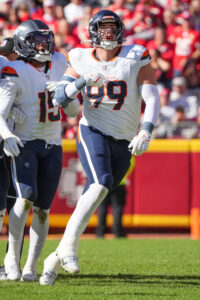 Sutton, 29, admitted he left a bit on the table to help the Broncos extend teammates. It is unlikely he left too much, but the Broncos had a complex task in completing a fair deal with a player 2-for-7 in 1,000-yard seasons — with QB play largely contributing on that end. Sutton also observed the Broncos pass on adding a No. 1-type wideout this offseason, strengthening his leverage. But a compromise figures to benefit the Broncos, who only guaranteed $1MM of Sutton’s money beyond 2026. It would cost the Broncos $15.85MM (due to two void years) to escape the contract in 2027; that number drops to $9.78MM in 2028 — which would be Sutton’s age-32 season.
Sutton, 29, admitted he left a bit on the table to help the Broncos extend teammates. It is unlikely he left too much, but the Broncos had a complex task in completing a fair deal with a player 2-for-7 in 1,000-yard seasons — with QB play largely contributing on that end. Sutton also observed the Broncos pass on adding a No. 1-type wideout this offseason, strengthening his leverage. But a compromise figures to benefit the Broncos, who only guaranteed $1MM of Sutton’s money beyond 2026. It would cost the Broncos $15.85MM (due to two void years) to escape the contract in 2027; that number drops to $9.78MM in 2028 — which would be Sutton’s age-32 season.
Shortly after that long-rumored deal was finalized, the Broncos paid one of their three first-time All-Pros from 2024. Allen had proven a value on a three-year, $45.75MM deal, going from J.J. Watt sidekick to interior disruption force as a D-line’s anchor. The career-long Vance Joseph pupil led the NFL with 40 QB hits last season; that ranked second among all 2020s performances and eighth over the past 10 years. Basically, that list is Aaron Donald, the Watts and Allen’s 2024.
Allen’s extension path was not nearly as complicated as Sutton’s. The Broncos paid their top D-lineman in his contract year, tabling talks until after the draft. Thanks to Allen’s dominant 2024, the process ended with the seventh-year veteran becoming the NFL’s third-highest-paid interior D-lineman. Only Chris Jones and Milton Williams (who used free agency to land a monster Patriots deal) sit higher than the late-blooming Bronco.
 In addition to his $44.5MM guaranteed at signing, Allen will see $15.75MM of his 2027 base salary shift from an injury guarantee to a full guarantee in March 2026. This contract structure reminds of Mike McGlinchey‘s, which provided the right tackle a Year 3 guarantee that vested early in Year 2. The deal effectively locks Allen in through at least his age-30 season, and this partnership will probably extend beyond Sutton’s due to age.
In addition to his $44.5MM guaranteed at signing, Allen will see $15.75MM of his 2027 base salary shift from an injury guarantee to a full guarantee in March 2026. This contract structure reminds of Mike McGlinchey‘s, which provided the right tackle a Year 3 guarantee that vested early in Year 2. The deal effectively locks Allen in through at least his age-30 season, and this partnership will probably extend beyond Sutton’s due to age.
Since June 2024, the Broncos have extended six starters (Sutton, Allen, Quinn Meinerz, Patrick Surtain, Jonathon Cooper, Garett Bolles) on deals worth at least $13.5MM per year. Backloading the deals via void years has helped the franchise, which cannot reap the usual benefits of a rookie-QB contract thanks to part two of Wilson’s dead money apocalypse still coming in at $32MM.
Wilson’s money comes off the books next year, but the relief will be short-lived. Although a Nix extension stands to be backloaded as well, a deal will be likely to commence in 2027. Having plenty of players worthy of extensions is a good problem, though this spree of upper-crust contracts will create challenges down the road. The past year also represents quite the comeback tour for GM George Paton, who evaded firing rumors after his Wilson contract and Nathaniel Hackett hire to form an effective duo with Payton.
Free agency additions:
- Talanoa Hufanga, S. Three years, $39MM ($20MM guaranteed)
- Evan Engram, TE. Two years, $23MM ($16.5MM guaranteed)
- Dre Greenlaw, LB. Three years, $31.5MM ($11.5MM guaranteed)
- Trent Sherfield, WR. Two years, $6MM ($3.25MM guaranteed)
- J.K. Dobbins, RB. One year, $2.07MM ($2.07MM guaranteed)
- Sam Franklin, S. One year, $1.34MM ($1.34MM guaranteed)
- Sam Ehlinger, QB. One year, $1.34MM ($468K guaranteed)
- Adam Prentice, FB. One year, $1.17MM
Denver’s 2024 improvement aside, it came without much at linebacker and without any reliable skill-position talents outside of Sutton. While Nix’s strong second half occurring with limited weaponry naturally creates Year 2 optimism, the Broncos needed to aggressively target upgrades to help their QB. One came in free agency, while two more ex-49er staples — to join D.J. Jones and Mike McGlinchey — preceded the Engram signing.
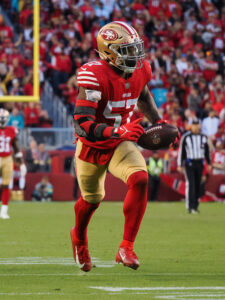 Hufanga and Greenlaw brought difficulty when compiling this year’s PFR Top 50; injury issues clouded both ex-San Francisco stalwarts’ markets. Hufanga (No. 30 in our annual value-based rankings) received more interest; Greenlaw (No. 40) still commanded plenty despite missing almost all of last season with the Achilles tear that may or may not have swung Super Bowl LVIII.
Hufanga and Greenlaw brought difficulty when compiling this year’s PFR Top 50; injury issues clouded both ex-San Francisco stalwarts’ markets. Hufanga (No. 30 in our annual value-based rankings) received more interest; Greenlaw (No. 40) still commanded plenty despite missing almost all of last season with the Achilles tear that may or may not have swung Super Bowl LVIII.
The 49ers did well to lock down Greenlaw on a team-friendly deal in 2022, giving the longtime Fred Warner sidekick a two-year extension worth just $16.4MM. Greenlaw outplayed that contract, but his seminal Achilles tear sustained trotting onto the field in Super Bowl LVIII re-routed his career. The all-around LB talent played just 34 snaps last season, running into Achilles soreness shortly after being activated from the reserve/PUP list in Week 15. The Broncos are betting on upside, but Greenlaw’s injury-plagued 2024 — which came three years after groin surgery sidelined him for 13 2021 games — influenced a lighter commitment.
Although the 49ers made an 11th-hour push to flip Greenlaw’s Broncos commitment during the legal tampering period, the seventh-year LB did not waver even after San Francisco upped its offer beyond where Denver went. It is not clear if that means a bigger overall package or a higher guarantee. It is safe to assume the Broncos’ $11.5MM at signing compared closely to the 49ers’ last-ditch pitch. The Greenlaw contract contains a $2MM salary guarantee on Day 5 of the 2026 league year; nothing else is locked in beyond 2025, giving the Broncos an early out.
 Not featuring much in the way of reliable linebacking play since the Super Bowl 50 Danny Trevathan–Brandon Marshall combo, the Broncos will hope they do not have to consider escaping that 2026 Greenlaw guarantee next March. Greenlaw, 28, would fill the key need on Denver’s defense; he graded as Pro Football Focus’ No. 9 overall off-ball LB in 2022 and 23rd in 2023 (247 combined tackles, eight TFLs).
Not featuring much in the way of reliable linebacking play since the Super Bowl 50 Danny Trevathan–Brandon Marshall combo, the Broncos will hope they do not have to consider escaping that 2026 Greenlaw guarantee next March. Greenlaw, 28, would fill the key need on Denver’s defense; he graded as Pro Football Focus’ No. 9 overall off-ball LB in 2022 and 23rd in 2023 (247 combined tackles, eight TFLs).
A plus coverage ‘backer, Greenlaw has already missed offseason and training camp time. Considering Alex Singleton is 31 and coming off an ACL tear, the Broncos’ ILB situation brings risk. That is about the only worrying area on a strengthened defense, however.
The Broncos fended off a late Jets push for Hufanga, who will replace P.J. Locke alongside 2024 FA addition Brandon Jones. Had Hufanga stayed healthy in 2023 and ’24, his market probably would have topped Tre’von Moehrig‘s $17MM-per-year deal in March. But Hufanga, 26, suffered a November 2023 ACL tear — the Broncos cornered the market on 49ers defenders absent during Patrick Mahomes‘ late-game surge in Super Bowl LVIII — and missed much of last season due to a concussion and a wrist injury. Before he missed 20 games from 2023-24 (counting playoffs), the former fifth-round find delivered one of the decade’s top safety seasons.
Hufanga’s 2022 brought six turnovers (four INTs, two forced fumbles) to go with two sacks, five TFLs and nine pass breakups. That first-team All-Pro season — Hufanga’s first as an NFL starter — produced the $20MM guarantee necessary to sign him. PFF also graded Hufanga as a top-30 safety in 2023 but was much lower on him last year, slotting him 74th at the position. As they have with Greenlaw, the Broncos are rolling the dice. Hufanga’s age presents greater upside. If the Broncos are right, having Hufanga on the NFL’s 12th-most lucrative safety contract will be a bargain.
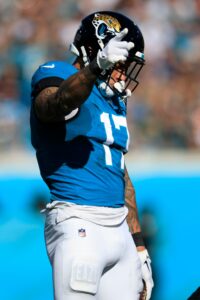 Tight end probably loomed as Denver’s biggest need; fortunately, Jacksonville sent a proven option to the market during Liam Coen‘s first weeks on the job. The Broncos have been unable to replace Noah Fant since his inclusion in the Wilson trade. Greg Dulcich did not pan out, and over the past two years, no Bronco tight end has eclipsed 205 receiving yards in a season. Last year, top TE Adam Trautman accumulated just 188. Engram is set to turn 31 in September, but he will be a massive upgrade on what the Broncos had been deploying post-Fant.
Tight end probably loomed as Denver’s biggest need; fortunately, Jacksonville sent a proven option to the market during Liam Coen‘s first weeks on the job. The Broncos have been unable to replace Noah Fant since his inclusion in the Wilson trade. Greg Dulcich did not pan out, and over the past two years, no Bronco tight end has eclipsed 205 receiving yards in a season. Last year, top TE Adam Trautman accumulated just 188. Engram is set to turn 31 in September, but he will be a massive upgrade on what the Broncos had been deploying post-Fant.
Engram set the Jaguars’ single-season tight end receiving yardage record in 2022 and broke it in ’23. After a 766-yard showing in 2022, the ex-Giants first-rounder tallied 963 in ’23. Engram’s 2023 season included 114 catches, which trailed only Jimmy Smith‘s 1999 in Jags history, and it had proved the team right for extending a player who had been inconsistent in New York.
A two-time Pro Bowler as a Giant, Engram fell back to earth in 2024. The agile chain-mover missed eight games due to two separate injuries, with a labrum tear the lead culprit. The Jags’ new regime bailed on Year 3 of Engram’s $13.75MM-AAV extension.
Nearly matching that per-year number on this Broncos deal, Engram received a comparable offer from the Chargers. Although Justin Herbert (and a Los Angeles landing) would certainly seem an enticing combo, Engram said Nix proved a driver for his Denver commitment. Landing in Payton’s offense will likely help as well. Denver naturally pursued ex-Payton Saints charge Juwan Johnson, driving up his market ahead of a New Orleans re-signing, but Engram is a more accomplished player. Not a proven red zone threat (nine total TDs in three Jacksonville seasons), the ninth-year vet could still profile as Denver’s de facto WR2 this season.
Read more
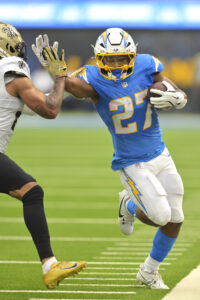 Dobbins, 26, quietly set a career high with 905 rushing yards last season. Quickly usurping two-time teammate Gus Edwards, Dobbins played a central role in the Chargers’ reemergence. Of course, the ex-Raven’s checkered injury history depressed his market.
Dobbins, 26, quietly set a career high with 905 rushing yards last season. Quickly usurping two-time teammate Gus Edwards, Dobbins played a central role in the Chargers’ reemergence. Of course, the ex-Raven’s checkered injury history depressed his market.
Having missed a whopping 47 regular-season games from 2020-24, Dobbins did not generate much free agency interest. Although the Chargers offered him a deal to stay, the Broncos had him on their radar since March. After a June visit, Dobbins joined a team that had already drafted a running back high.
ACL and Achilles tears derailed three Dobbins seasons, and he missed four games due to an MCL sprain last year. Dobbins’ rookie-year breakthrough brought a 6.0-yard average per carry, and his eight-game 2022 — after the ACL tear — produced a 5.7-yard mark. That came in a Lamar Jackson-piloted offense, but Dobbins’ Bolts season included a 4.6-yard average and a 12th-place finish in Next Gen Stats’ rush yards over expected metric (115). Injury absences should be expected, but Dobbins will see regular work alongside second-rounder RJ Harvey.
Re-signings:
- D.J. Jones, DT. Three years, $39MM ($26MM guaranteed)
- Jarrett Stidham, QB. Two years, $12MM ($6.99MM guaranteed)
- Matt Peart, T. Two years, $7MM ($3.25MM guaranteed)
- Justin Strnad, LB. One year, $2.88MM ($2.88MM guaranteed)
- Mitchell Fraboni, LS. Three years, $4.18MM ($1.7MM guaranteed)
- Michael Burton, FB. One year, $1.42MM ($125K guaranteed)
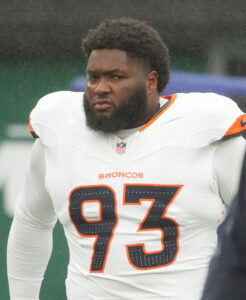 While not technically among the Broncos’ above-referenced extension contingent, Jones joined Allen and Sutton in receiving a lucrative third contract. The former 49ers starter played out a three-year, $30MM deal — one agreed to before Sean Payton‘s arrival — but collected a nice raise ahead of his age-30 season. Jones has been a durable player in Denver, missing only three combined games in three seasons. His interior presence has helped the likes of Allen, Nik Bonitto and Jonathon Cooper.
While not technically among the Broncos’ above-referenced extension contingent, Jones joined Allen and Sutton in receiving a lucrative third contract. The former 49ers starter played out a three-year, $30MM deal — one agreed to before Sean Payton‘s arrival — but collected a nice raise ahead of his age-30 season. Jones has been a durable player in Denver, missing only three combined games in three seasons. His interior presence has helped the likes of Allen, Nik Bonitto and Jonathon Cooper.
Not many Broncos regulars exited last season out of contract; Jones led the way and expressed interest in staying. Denver locked its nose tackle down the night before the legal tampering period, presenting him with an offer viable enough to preempt a second free agency foray.
Jones ranked second among interior D-linemen in run stop win rate last season, helping the Broncos morph from a defense that had given up 70 points to the Dolphins in 2023 to a No. 3-ranked unit last year. The Broncos will place a bet on Jones’ early 30s bringing more of the same.
Stidham has been one of the NFL’s most productive players during the preseason, and although he does not have a path to unseating Nix, the Broncos have liked what they have seen from their backup. Stidham has been with the team since Payton’s 2023 arrival, backing up (and then awkwardly replacing) Russell Wilson 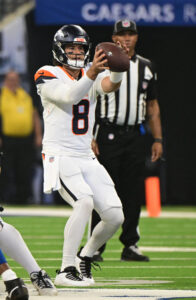 before serving as Nix’s QB2 throughout last season. Zach Wilson showed more arm talent during training camp last year, but Stidham held the backup job during the regular season.
before serving as Nix’s QB2 throughout last season. Zach Wilson showed more arm talent during training camp last year, but Stidham held the backup job during the regular season.
A former Patriots fourth-rounder who briefly received consideration to succeed Tom Brady, Stidham is best known for replacing contract-related bubble-wrapped starters (Wilson, Derek Carr) in back-to-back seasons. The 29-year-old passer has generated internal praise and should again be a capable backup.
Strnad became Alex Singleton‘s fill-in last season, logging 676 defensive snaps after seeing zero from 2022-23. The special-teamer fared reasonably well, considering his lack of seasoning, and made 73 tackles (eight for loss) to go with three sacks. A fifth-rounder in John Elway‘s final draft as GM (2020), Strnad gaining experience last year may prove pivotal due to the health questions Greenlaw and Singleton bring.
Notable losses:
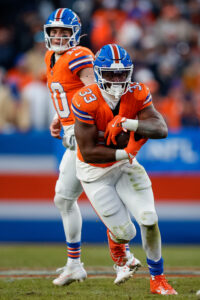 Williams’ October 2022 knee setback — ACL and LCL tears — represents an unfortunate line of demarcation in the former second-rounder’s career. After delivering an impressive rookie season (1,219 scrimmage yards, seven TDs despite primarily being Melvin Gordon‘s backup), Williams has not been able to recapture that form since that knee injury in Las Vegas.
Williams’ October 2022 knee setback — ACL and LCL tears — represents an unfortunate line of demarcation in the former second-rounder’s career. After delivering an impressive rookie season (1,219 scrimmage yards, seven TDs despite primarily being Melvin Gordon‘s backup), Williams has not been able to recapture that form since that knee injury in Las Vegas.
Although Williams spent the past two seasons as Denver’s nominal starter, he has not reminded of his rookie-year form. Yards-per-carry numbers south of 3.8 followed Williams’ rehab effort, and the Broncos were viewed as likely to move on after he led last year’s team with just 513 rushing yards. While the Broncos ranked first in run block win rate last season, Williams and Co. were unable to take advantage. After expressing interest in staying, Williams joined the Cowboys on a one-year, $3MM deal.
Barton competed with Jonas Griffith for a starting job last year but saw his run as the team’s three-down ‘backer, post-Singleton, lead to a significant raise. The Titans are Barton’s fourth team in four years; he has gone from Seattle to Washington to Denver to Nashville. Barton played for just $2.5MM last year. He became a more valuable piece as a three-down player, tallying 106 tackles and two interceptions. Barton earned a  three-year, $21MM deal ($13.3MM guaranteed) off that season.
three-year, $21MM deal ($13.3MM guaranteed) off that season.
Zach Wilson fell out of Denver’s QB competition fairly early last summer, though his practice work did show arm talent neither Nix nor Stidham possess. Almost nothing else from Wilson since his NFL entrance as the 2021 No. 2 overall pick has indicated starter-level capabilities, and he spent the season as Denver’s third-stringer.
The ex-Jets starter still commanded an interesting contract, fetching a $6MM guarantee to be Tua Tagovailoa‘s backup. That is a positive development for Wilson, whom the Jets had to keep paying last year — as part of a salary split — to induce the Broncos to send them a sixth-round pick in a trade.
Draft:
- Round 1, No. 20: Jahdae Barron (CB, Texas) (signed)
- Round 2, No. 60 (from Lions): R.J. Harvey (RB, Central Florida) (signed)
- Round 3, No. 74 (from Panthers): Pat Bryant (WR, Illinois) (signed)
- Round 3, No. 101 (from Rams through Falcons and Eagles)*: Sai’vion Jones (DE, LSU) (signed)
- Round 4, No. 134 (from Eagles through Lions and Eagles): Que Robinson (OLB, Alabama) (signed)
- Round 6, No. 216 (from Browns through Texans)*: Jeremy Crawshaw (P, Florida) (signed)
- Round 7, No. 241 (from Texans): Caleb Lohner (TE, Utah) (signed)
 Going as far as to guarantee they would draft a running back, the Broncos did not end up making that their centerpiece pick. The team was interested in Ashton Jeanty, but a climb that far north from No. 20 would have presented a difficult cost for a team that had already traded three first-round picks (for Russell Wilson and Sean Payton) since 2022. Denver had not made a first-round pick since Patrick Surtain, and although steady rumblings of interest in moving up emerged close to the draft, the team stuck and addressed a position most viewed as a previous strength.
Going as far as to guarantee they would draft a running back, the Broncos did not end up making that their centerpiece pick. The team was interested in Ashton Jeanty, but a climb that far north from No. 20 would have presented a difficult cost for a team that had already traded three first-round picks (for Russell Wilson and Sean Payton) since 2022. Denver had not made a first-round pick since Patrick Surtain, and although steady rumblings of interest in moving up emerged close to the draft, the team stuck and addressed a position most viewed as a previous strength.
The team did show interest in potentially moving down. Payton’s HC career has never included a first-round trade-down, but the Broncos eyed TreVeyon Henderson — a player who would have been available late in the first round (the Patriots landed the multipurpose Ohio State product at No. 38). The Broncos were also connected to Ohio State slot Emeka Egbuka, but after Tampa Bay came away with the high-floor prospect at 19, Denver bolstered its secondary.
Employing the 2010s’ All-Decade slot cornerback (Chris Harris), the Broncos have observed the impact a dynamic corner can provide. Barron roved across the secondary at Texas, primarily playing in the slot from 2022-23 before a shift outside last season. Also seeing safety work with the ascending Longhorns, Barron (five 2024 INTs) won the Thorpe award given to Division I-FBS’ top DB. Ranking 10th on Daniel Jeremiah’s NFL.com big board, Barron brought a profile the Broncos viewed as too unique to overlook at 20.
 Barron gives the Broncos options, as he could replace two-year contributor Ja’Quan McMillian in the slot or rotate between that position and the boundary. Riley Moss impressed before a late-season knee injury last year, pointing Barron to the slot in Year 1. Barron already being 24 — just one year younger than Surtain — is an underdiscussed catch here. How his age affects a path toward a second contract will be interesting, but for the foreseeable future, the Broncos will have two first-rounder corners rostered.
Barron gives the Broncos options, as he could replace two-year contributor Ja’Quan McMillian in the slot or rotate between that position and the boundary. Riley Moss impressed before a late-season knee injury last year, pointing Barron to the slot in Year 1. Barron already being 24 — just one year younger than Surtain — is an underdiscussed catch here. How his age affects a path toward a second contract will be interesting, but for the foreseeable future, the Broncos will have two first-rounder corners rostered.
Regularly mocked Omarion Hampton at 20, the Broncos — as their reported Henderson interest conveyed — were interested in a more versatile option. Although Harvey was not viewed as a consensus Day 2 value, the Broncos made the Central Florida prospect their centerpiece RB move this offseason. Following Javonte Williams as a second-round RB drafted by George Paton, Harvey has a disparate skillset from the rugged four-year contributor. Harvey profiles as an Alvin Kamara-type prospect, and Payton — from Kamara to Darren Sproles to Reggie Bush — has frequently coaxed game-altering form from this genre of running back.
Ranked 99th on Jeremiah’s big board and 93rd on Dane Brugler’s The Athletic board, Harvey dominated mid-major competition with the Knights. He combined for 2,993 rushing yards from 2023-24, adding 38 rushing TDs in that span. Harvey will be asked to do more as a pass catcher — after not exceeding 270 yards in any college season — but he did average more than 12 yards per catch in each of his two dominant college slates.
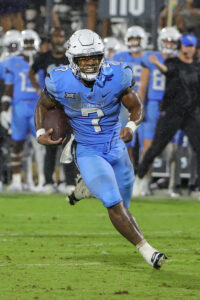 Harvey will start his career as the Kamara to J.K. Dobbins‘ Mark Ingram, in the absolute best-case scenario, but his age is also notable. Like Barron, Harvey will play an age-24 season as a rookie. With RBs regularly entering drafts after their third college seasons, Harvey spending five years in college is atypical — especially for a second-round pick.
Harvey will start his career as the Kamara to J.K. Dobbins‘ Mark Ingram, in the absolute best-case scenario, but his age is also notable. Like Barron, Harvey will play an age-24 season as a rookie. With RBs regularly entering drafts after their third college seasons, Harvey spending five years in college is atypical — especially for a second-round pick.
After hosting higher-profile receiver prospects, the Broncos added Bryant. The Illinois alum’s stock dropped after a 4.61-second 40-yard time at the Combine, but the rookie has impressed — to the point it influenced a trade at the position — during camp and in preseason games. Bryant caught 54 passes for 984 yards and 10 touchdowns last season and will have a bigger role post-Devaughn Vele. Possessing size Payton prefers at receiver (6-foot-2, 204 pounds), Bryant is the fourth wideout the Broncos have drafted under their current HC.
Two trade-down moves — swaps that allowed a third-round move-up (via the Panthers) and supplied an extra fourth (via the Lions) — preceded Denver trading up (via Philadelphia) for Jones, who is set to work as a backup D-end in Vance Joseph‘s 3-4 scheme. Jones arrives as a potential replacement for John Franklin-Myers come 2026; the 2024 trade acquisition has not engaged in extension talks yet. Backup D-lineman Malcolm Roach is also on track for 2026 free agency. Jeremiah ranked Jones 80th on his big board; the 280-pound defender tallied 4.5 sacks and eight TFLs at LSU last season.
Trades:
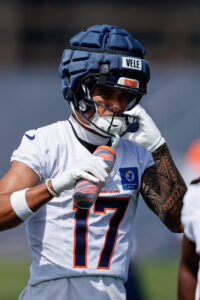 Vele became a surprising rookie-year contributor in Denver, going from seventh-round pick to the team’s second-leading receiver (475 yards). The 6-foot-5 prospect played far more than Marvin Mims and logged more 2024 snaps than Troy Franklin despite going off the board three rounds later. An anticipated Mims usage increase to go with the Bryant draft choice and Franklin’s impressive camp showing led to the Broncos dealing Vele — even as three years remain on his rookie contract.
Vele became a surprising rookie-year contributor in Denver, going from seventh-round pick to the team’s second-leading receiver (475 yards). The 6-foot-5 prospect played far more than Marvin Mims and logged more 2024 snaps than Troy Franklin despite going off the board three rounds later. An anticipated Mims usage increase to go with the Bryant draft choice and Franklin’s impressive camp showing led to the Broncos dealing Vele — even as three years remain on his rookie contract.
For a team that saw just one pass catcher eclipse 505 yards last season, this is somewhat risky. It highlights a belief Bryant’s arrival and Franklin’s improvement would marginalize Vele, whose skillset differs from Mims’ considerably.
The 6-5 target is also older than most players on rookie contracts. Vele, who served a Mormon mission while at Utah, will turn 28 before season’s end. As Vele will be 30 before his rookie contract expires, his NFL career stands to be shortened. Fetching a fourth-round pick for a player chosen 235th last year represents good value, and Vele will head to a Saints team with significant QB questions.
Other:
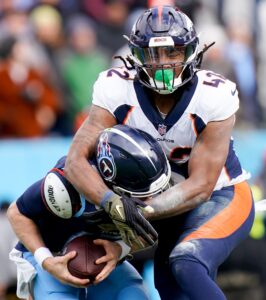 Chosen with one of the picks obtained in the 2021 Von Miller trade, Bonitto has become Denver’s best pass rusher since parting with the Super Bowl 50 MVP. After a 13.5-sack season produced a second-team All-Pro honor, Bonitto became a clear extension candidate. It has been a few weeks since the Broncos paid Courtland Sutton and Zach Allen, but Bonitto buzz persists as the season nears.
Chosen with one of the picks obtained in the 2021 Von Miller trade, Bonitto has become Denver’s best pass rusher since parting with the Super Bowl 50 MVP. After a 13.5-sack season produced a second-team All-Pro honor, Bonitto became a clear extension candidate. It has been a few weeks since the Broncos paid Courtland Sutton and Zach Allen, but Bonitto buzz persists as the season nears.
If unpaid by Week 1, the former second-rounder would be tied to a $5.35MM base salary. While Bonitto may be OK waiting until Micah Parsons and Trey Hendrickson (and perhaps Aidan Hutchinson) make final alterations to the top of the market, seeing a guarantee influx — rather than Year 4 of a rookie contract — will be alluring. Bonitto, 26 next month, will not be a candidate to compete with Parsons or Hutchinson on a second contract, but the deals given to Myles Garrett and T.J. Watt raised the ceiling already. This market’s rise will boost Bonitto, who can command at least a high-second-tier extension.
The George Paton years have also not set Week 1 as a deadline for extension talks. The team paid Sutton and Tim Patrick during the 2021 season and extended Garett Bolles and Bonitto OLB wingman Jonathon Cooper last fall. Optimistic about an extension, Bonitto could be on that track as well. If the sides cannot agree on terms before season’s end, Bonitto will be one of the NFL’s best bets for a 2026 franchise tag.
 It seemed for a while the Broncos would benefit from a veteran presence, particularly in the slot, as the team does not have a proven target there. However, it will likely be Evan Engram working regularly in this capacity in Nix’s second season. The team showed interest in Samuel but did not make an offer. The Broncos also did not see Kupp’s eventual $15MM-per-year price align with their valuation. Barring a pre-deadline trade, it will again be on rookie-contract WRs to complement Sutton this year.
It seemed for a while the Broncos would benefit from a veteran presence, particularly in the slot, as the team does not have a proven target there. However, it will likely be Evan Engram working regularly in this capacity in Nix’s second season. The team showed interest in Samuel but did not make an offer. The Broncos also did not see Kupp’s eventual $15MM-per-year price align with their valuation. Barring a pre-deadline trade, it will again be on rookie-contract WRs to complement Sutton this year.
Considering where the Broncos were in 2022, the team losing this much front office talent in one offseason highlights the climb the franchise has made in the years since. Mougey joined the Broncos early in John Elway‘s GM tenure (2012) and climbed the ladder during Paton’s two years atop the personnel pyramid, later staying in place as assistant GM once Payton arrived. The Jets have paired the 13-year Broncos with Aaron Glenn. Burckhardt, who has been with the team four years, will replace Mougey as Paton’s top front office lieutenant.
Denver lost two staffers to NFC North OC positions. This comes after the 2024 team jumped to 10th in scoring offense despite modest skill-position talent around last year’s sixth QB drafted. Doyle becomes an OC before 30, though the short-lived Denver tight ends coach will not call plays in Chicago. Both Doyle and Morton spent two years in their respective positions.
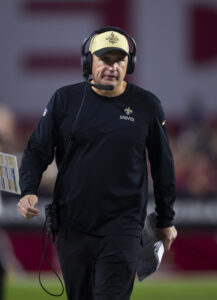 Morton, 55, will be tasked with replacing Ben Johnson in Detroit. Morton has one season — with the 2017 Jets — of OC experience. Davis Webb‘s quick coaching ascent now includes a pass-game coordinator title. Nix building on his rookie-year success will probably garner the third-year Broncos QBs coach OC interviews come 2026.
Morton, 55, will be tasked with replacing Ben Johnson in Detroit. Morton has one season — with the 2017 Jets — of OC experience. Davis Webb‘s quick coaching ascent now includes a pass-game coordinator title. Nix building on his rookie-year success will probably garner the third-year Broncos QBs coach OC interviews come 2026.
Rizzi, 55, coached the Saints’ ST units under Payton from 2019-21. He joins OC Joe Lombardi, senior offensive assistant Pete Carmichael and O-line coach Zach Strief as ex-Saints staffers in prominent Broncos roles. Rizzi held an outside shot at the Saints’ full-time HC position, especially as candidates (Kliff Kingsbury, Joe Brady, Mike McCarthy) dropped out of the running. Kellen Moore taking the job, however, led Rizzi to Denver.
Top 10 cap charges for 2025:
- Mike McGlinchey, RT: $23.78MM
- Ben Powers, G: $17.43MM
- Zach Allen, DL: $14.35MM
- Courtland Sutton, WR: $13.9MM
- John Franklin-Myers, DL: $10MM
- Brandon Jones, S: $9.05MM
- Patrick Surtain, CB: $8.37MM
- Jonathon Cooper, OLB: $8.15MM
- Alex Singleton, ILB: $6.91MM
- D.J. Jones, DT: $6.6MM
Even as the Broncos have set themselves up as a playoff contender again, the AFC’s Chiefs-Bills-Ravens fortress remains imposing for outside challengers. A host of second-tier threats — the Texans, Chargers, Bengals and Steelers among them — also present challenges in a loaded conference, but the Broncos added talent in key areas and did not lose much this offseason.
Payton’s Super Bowl mentions notwithstanding, the Broncos winning a playoff game for the first time in 10 seasons would probably bring a successful season. Denver still has some time to build with Nix on a rookie contract, expanding options, but this roster features a host of veterans well into their careers. Sutton will join Bolles, McGlinchey and Engram as 30-something offensive starters this season. Part of a high-end O-line returning all five starters, Powers will play an age-29 season. While young standouts also appear on Denver’s roster, some of the age on the offensive side does create urgency for 2025.
If Payton and a better weaponry cadre boost Nix’s growth, the Broncos should have a more talented offense — on a defense-oriented roster. The Greenlaw, Hufanga and Barron additions on defense probably make it — should the ex-49ers shake off recent injury issues — the most talented Broncos unit since their Super Bowl-winning 2015 defense. Will this enhanced formula be enough to threaten the Chiefs in the AFC West and perhaps infiltrate the conference’s top tier come January?
By Sam Robinson |
at August 20, 2025 10:08 pm
Pushing the eventual Super Bowl champion Eagles to the limit in the divisional round, the Rams entered the offseason in the same place they usually do — as a clear championship contender. The team needed to solve a quarterback dilemma before reloading its arsenal for a potential Super Bowl LX run, and considerable fallout emerged from the latest Matthew Stafford contract-driven saga.
While the Rams swapped out star wide receivers and made their biggest running back commitment since Todd Gurley, Stafford’s status overshadowed everything else about Los Angeles’ offseason. The team’s draft strategy opens a door to a potential succession plan, but for now, it is still Stafford-or-bust in L.A.
Extensions and restructures:
After the Rams solved their lingering 2024 Stafford issue with an incentive package and a minor guarantee bump for 2025, they received word the Super Bowl-winning passer would play a 17th NFL season. By late January, however, Stafford trade rumors began to emerge. As the Combine neared, the Rams gave Stafford — whom they acquired in a January 2021 blockbuster trade — permission to explore another relocation. That set off one of the stranger storylines involving a high-profile QB in recent memory. A host of rumors emerged about Stafford’s future, all while the Rams would have been staring at a significant downgrade at the game’s premier position if they went through with a swap.
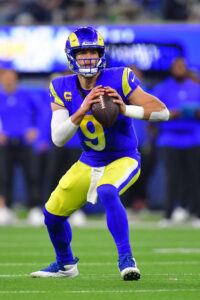 Playing on a Lions-designed deal ($27MM per year) during the Rams’ Super Bowl-winning season, Stafford signed a four-year, $160MM extension. At the time, Stafford left money on the table to help the Rams remain a contender. The team then rewarded Super Bowl heroes Aaron Donald and Cooper Kupp later in 2022. Stafford, however, regretted this decision and pushed for better terms in 2024 and ’25.
Playing on a Lions-designed deal ($27MM per year) during the Rams’ Super Bowl-winning season, Stafford signed a four-year, $160MM extension. At the time, Stafford left money on the table to help the Rams remain a contender. The team then rewarded Super Bowl heroes Aaron Donald and Cooper Kupp later in 2022. Stafford, however, regretted this decision and pushed for better terms in 2024 and ’25.
The Rams gave him a $5MM 2024 raise by moving money up from future years and then added a $4MM 2025 roster bonus. Stafford submitted a second straight strong season — after 2023 trade rumors swirled following an injury-plagued 2022 — and found teams willing to pay up, increasing urgency on the Rams’ end.
Several teams, including the Steelers, contacted the Rams on Stafford. While Pittsburgh preferred Stafford to Aaron Rodgers, two teams emerged as the true Stafford suitors. The Giants and Raiders worked out contract parameters, with each team ready to authorize guarantee packages in the $90-$100MM range. As he did in the Raiders’ Ben Johnson pursuit, Tom Brady played a lead role and spoke with Stafford at a Montana ski resort. The Giants were linked to a potential $55MM-per-year offer, after a Stafford request of at least $50MM AAV had emerged.
The Rams sought a first-round pick, but neither of the primary suitors was willing to deal a top-six selection — as both held such draft real estate. L.A. was not willing to meet Stafford’s $50MM-AAV ask, but the team had infrastructure advantages on both suitors. Coming off last-place divisional finishes, neither the Giants nor Raiders profile as a 2025 contender. With Stafford now 37, it would have been more of a pure financial play to bail on the Rams for one of those situations.
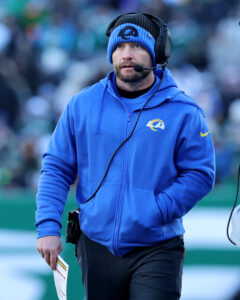 With Stafford lacking a no-trade clause, the Rams also held the hammer here. Sean McVay represented a draw as well, and the ninth-year Rams HC remained in contact with Stafford throughout the process. In the end, a predictable conclusion emerged. Stafford did not take a late-career risk of joining teams much farther away from the Super Bowl-contending level, and the Rams fully guaranteed his 2025 salary while dangling a guarantee carrot for 2026. Though, Stafford remaining on the roster by that March 2026 vesting date suddenly looks hazier.
With Stafford lacking a no-trade clause, the Rams also held the hammer here. Sean McVay represented a draw as well, and the ninth-year Rams HC remained in contact with Stafford throughout the process. In the end, a predictable conclusion emerged. Stafford did not take a late-career risk of joining teams much farther away from the Super Bowl-contending level, and the Rams fully guaranteed his 2025 salary while dangling a guarantee carrot for 2026. Though, Stafford remaining on the roster by that March 2026 vesting date suddenly looks hazier.
If Stafford remains a Ram by Day 5 of the 2026 league year, $40MM of his 2026 compensation fully guarantees. That effectively becomes a sell-by date for the Rams, whose first-round trade may change their long-term outlook at the position. Even though Stafford has secured $26MM more from the Rams than this contract initially called for, turning down better security — even though the full guarantee numbers from the Giants and Raiders never surfaced — injects some risk due to the QB’s ongoing injury trouble. But Stafford is running it back with a team he has piloted to three playoff appearances.
It would cost the Rams $41.87MM to drop Stafford before that guarantee vests, and while the latest rework did increase the punishment on the franchise were it to move on before that mid-March date, the dead money could be split over two years via a post-June 1 cut. It remains to be seen if Stafford would have realistic trade value next year, when he intends to keep playing. His latest injury battle has created short- and long-term questions.
 A back injury cropped up early in training camp, keeping Stafford off the field for multiple weeks. This included missing two joint practices. A report of a disk issue soon surfaced, as Stafford received an epidural injection, and the Rams continued to push back their fifth-year QB’s return date.
A back injury cropped up early in training camp, keeping Stafford off the field for multiple weeks. This included missing two joint practices. A report of a disk issue soon surfaced, as Stafford received an epidural injection, and the Rams continued to push back their fifth-year QB’s return date.
As of Monday, Stafford has returned to work. But he has played through countless injuries over his career. Now in his late 30s, the one-time (non-alternate) Pro Bowler will need to be constantly monitored on the health front. The Rams’ fortunes ride on their star passer staying healthy, but without an alternative they were overly interested in (more on that below), a decision to regroup with Stafford won the day. Was it the right play?
A less complicated negotiation unfolded with Williams, who came up as an extension candidate in the spring. It took a few months, but the sides reached an agreement. The former fifth-round pick, who had pushed Cam Akers to the periphery in L.A.’s vision, became the first running back the team has committed to contractually since Todd Gurley‘s 2018 payday. The team came to regret the Gurley contract — which reset the market seven years ago — and even as the cap has exploded since, the Williams deal comes in well south of Gurley’s.
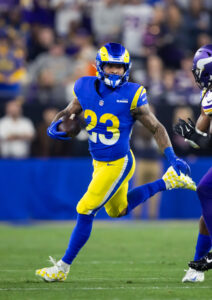 With the cap at $177.2MM in 2018 (compared to $279.2MM today), the Rams gave Gurley a four-year, $57.5MM extension that came with $21.95MM at signing. Williams has not proven to be in that class, but the Notre Dame alum has been a quality starter. Williams, 25 next week, led the NFL with 95.3 rushing yards per game in 2023 and delivered a career-high 1,299 on the ground last season. The Rams had not seen enough from Akers or Darrell Henderson to pay them between their 2020 Gurley cut and Williams’ extension eligibility, but they have reinvested in the position on a more careful contract. The team was unwilling to go toward a top-market deal here.
With the cap at $177.2MM in 2018 (compared to $279.2MM today), the Rams gave Gurley a four-year, $57.5MM extension that came with $21.95MM at signing. Williams has not proven to be in that class, but the Notre Dame alum has been a quality starter. Williams, 25 next week, led the NFL with 95.3 rushing yards per game in 2023 and delivered a career-high 1,299 on the ground last season. The Rams had not seen enough from Akers or Darrell Henderson to pay them between their 2020 Gurley cut and Williams’ extension eligibility, but they have reinvested in the position on a more careful contract. The team was unwilling to go toward a top-market deal here.
Les Snead approved a $15.15MM at-signing guarantee, but Williams’ camp secured additional guarantees by early 2026. Already guaranteeing $2.75MM of Williams’ $5MM 2026 base salary, the Rams will guarantee the rest on Day 3 of the 2026 league year. On Day 5, $4.61MM of Williams’ $8.95MM 2027 base salary will lock in. Barring an injury that would impede a passed physical come March, the Rams could move on for $12.58MM in dead money next year.
This contract’s fine print reveals a bit more caution on the team’s part, but if it were to consider moving on, a move would need to be made soon after free agency starts. While Williams’ camp did well to secure a rolling guarantee structure, it does not fully protect the RB from a quick release — as a post-June 1 cut would minimize the damage for the Rams, who cut Gurley less than two years after his extension.
Free agency additions:
- Davante Adams, WR. Two years, $46MM ($26MM guaranteed)
- Poona Ford, DT. Three years, $27.6MM ($15.6MM guaranteed)
- Coleman Shelton, C. Two years, $12MM ($9MM guaranteed)
- D.J. Humphries, LT. One year, $2.5MM ($2.34MM guaranteed)
- David Quessenberry, T. One year, $1.33MM ($1.3MM guaranteed)
- Nathan Landman, LB. One year, $1.1MM ($75K guaranteed)
- Britain Covey, WR. One year, $1.1MM
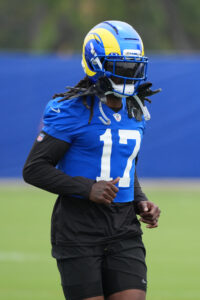 Adams grew to loathe his first post-high school experience of catching passes from quarterbacks not named Derek Carr or Aaron Rodgers, but the California native became intrigued by a move back west after his Jets stop. The Rams convinced the decorated wide receiver to replace Cooper Kupp alongside Puka Nacua. Adams is a year older than Kupp but has been far more durable, and the Rams will at least try him out — for a hefty sum — for a season.
Adams grew to loathe his first post-high school experience of catching passes from quarterbacks not named Derek Carr or Aaron Rodgers, but the California native became intrigued by a move back west after his Jets stop. The Rams convinced the decorated wide receiver to replace Cooper Kupp alongside Puka Nacua. Adams is a year older than Kupp but has been far more durable, and the Rams will at least try him out — for a hefty sum — for a season.
Although the Jets could not crawl out of their early hole upon acquiring Adams from the Raiders, the wide receiver put up impressive numbers during the 5-12 slate. Not missing any games as a Jet (after what looked like an injury exaggeration in his final Las Vegas days), Adams posted 854 yards and seven touchdowns in 11 New York games. His presence looked to have alienated Garrett Wilson, but it showed some positive Rodgers work. In 14 games last season, Adams cobbled together his sixth 1,000-yard season. Firmly on the Hall of Fame radar, Adams will attempt to contribute to a Super Bowl contender’s cause after his post-Green Bay years did not remotely involve playoff chances.
The Rams, who could not count on Kupp for the most part since a string of injuries that began midway through the 2022 season, added a receiver who has not missed more than two games in a season due to a legitimate injury since 2019. If Adams shows clear decline signs, the Rams have an early out. Adams, 32, is due a $6MM roster bonus on Day 5 of the 2026 league year. The Rams can move on via a $14MM dead money charge if they opt to cut bait before the bonus is due.
It is interesting Adams joined a team that could feature some Jimmy Garoppolo starts, seeing as the receiver criticized the then-Raiders starter — effectively getting Garoppolo benched midway through the 2023 season — as the wheels fell off for Josh McDaniels in Vegas. Garoppolo had not re-signed with the Rams when Adams committed, but the team re-upped its backup QB a day after it signed Adams.
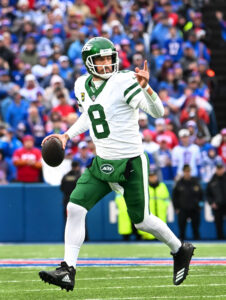 Naturally, the Rams were also connected to Rodgers. In what would have been a third Rodgers-Adams partnership, the Rams discussed the aging great as a contingency plan in case they followed through with a Stafford trade. Rodgers, who lives in California during the offseason, was open to taking a discount to play for McVay. Stafford staying forced the four-time MVP to look elsewhere, and he ended up in Pittsburgh (on a one-year, $14.15MM deal) just before minicamp.
Naturally, the Rams were also connected to Rodgers. In what would have been a third Rodgers-Adams partnership, the Rams discussed the aging great as a contingency plan in case they followed through with a Stafford trade. Rodgers, who lives in California during the offseason, was open to taking a discount to play for McVay. Stafford staying forced the four-time MVP to look elsewhere, and he ended up in Pittsburgh (on a one-year, $14.15MM deal) just before minicamp.
Shelton’s 2024 exit stung the Rams a bit more than expected. Even though the team’s two-year center starter commanded just $3MM from the Bears, the Rams cycled through a few centers last year. The sides regrouped in March, and Shelton received a significant raise. He will see half of his 2026 base salary guaranteed at signing, pointing to a true two-year commitment.
Between training camp and the divisional round, the Rams tried Steve Avila, Jonah Jackson and Beaux Limmer at center. Limmer will return to a backup role, while Avila is at his more natural guard spot — where he resettled last year after the Rams regretted their Jackson signing. Shelton, 30, is back with the team he spent five seasons with from 2019-23.
Read more
Ford revived his career in L.A., starting for a No. 1-ranked Chargers defense after languishing as a seldom-used Bills backup in 2023. The Bolts gave Ford 17 starts, restoring his value after he had been a four-year Seahawks starter. On the strength of his run defense, Ford drew a fifth-place grade (among interior D-linemen) from Pro Football Focus last season. He also batted down five passes as a Charger. The former UDFA will replace Bobby Brown. Ford, 29, commanded more than Brown on the market despite being more than four years older.
Re-signings:
- Alaric Jackson, LT. Three years, $57.75MM ($30MM guaranteed)
- Tutu Atwell, WR. One year, $10MM ($10MM guaranteed)
- Jimmy Garoppolo, QB. One year, $3.01MM ($3.01MM guaranteed)
- Ahkello Witherspoon, CB. One year, $1.26MM ($1.26MM guaranteed)
- Larrell Murchison, DL. One year, $1.17MM ($160K guaranteed)
- Dresser Winn, QB. Two years, $1.85MM
- Troy Reeder, LB. One year, $1.1MM
- Ronnie Rivers, RB. One year, $1.1MM
 Jackson gave the Rams a vital answer after they misevaluated Joe Noteboom. A former UDFA, Jackson beat out the would-be Andrew Whitworth successor and kept the left tackle job for the past two seasons. Given a second-round RFA tender last year, the Iowa alum had been on track to become one of this free agency class’ top players. But the Rams put a strong offer — as they did with Kevin Dotson last year — to keep him off the market.
Jackson gave the Rams a vital answer after they misevaluated Joe Noteboom. A former UDFA, Jackson beat out the would-be Andrew Whitworth successor and kept the left tackle job for the past two seasons. Given a second-round RFA tender last year, the Iowa alum had been on track to become one of this free agency class’ top players. But the Rams put a strong offer — as they did with Kevin Dotson last year — to keep him off the market.
At nearly $20MM per year, Jackson is the Rams’ highest-paid O-lineman. Managing to move Jonah Jackson‘s salary off the books helped free up room to squeeze both Alaric Jackson and Davante Adams into their free agency budget. PFF viewed 2024 as Alaric Jackson’s best season, giving him a top-20 grade. The Rams and Ravens diluted the tackle market, much to Dan Moore Jr.‘s delight, by paying Jackson and Ronnie Stanley early.
The Rams, however, have run into a notable obstacle early in Jackson’s second contract. Additionally, if the LT is on the Rams’ roster by Day 5 of the 2026 league year, he will see a $5.43MM injury guarantee shift to a full guarantee.
A blood clot issue has sidelined Jackson since June. Although the would-be starting left tackle has been partially participating in Rams workouts, he has not recovered yet. This opens the door to a major issue up front. The Rams have a rather injury-prone quarterback — who has battled another issue for weeks now — set to play an age-37 season, and they have Jackson on an uncertain timetable and 11th-year right tackle Rob Havenstein coming off shoulder surgery. Havenstein, the Rams’ longest-tenured player, missed six games last season. While Havenstein is back at work, the Rams could see a major drop-off in LT quality.
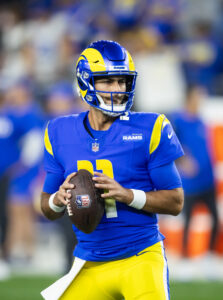 As it stands, D.J. Humphries is tracking toward being the team’s Week 1 fill-in there. While Humphries was a Cardinals mainstay there for the better part of a decade, he dealt with steady injury problems and did not look good during his most recent game action.
As it stands, D.J. Humphries is tracking toward being the team’s Week 1 fill-in there. While Humphries was a Cardinals mainstay there for the better part of a decade, he dealt with steady injury problems and did not look good during his most recent game action.
Humphries, 31, signed with the Chiefs after not being cleared (from a December 2023 ACL tear) until midseason. Thrown into the fire immediately, the former first-round pick suffered a hamstring injury in his first Kansas City appearance and never earned a starting spot back. The Chiefs kept Humphries on the bench after he recovered, but the Rams may be forced to use him while Jackson recovers.
A competition between Humphries and third-year blocker Warren McClendon looks to have gone the veteran’s way. Humphries has 100 career starts, but he also missed 33 games from 2016-23 due to injury. But both the Rams and 49ers pursued him; the 11th-year veteran’s San Francisco agreement not coming to pass led him to L.A., where a starting job may well await.
Stafford has played through most of the injuries sustained during his career, but a back ailment did sideline him for eight contests in 2019. The prospect of Humphries blocking for Garoppolo should certainly be on the radar for Rams fans/various fantasy GMs. Garoppolo, 33, has missed 32 games with the 49ers from 2018-22 and two more during his half-season stint as the Raiders’ starter. While the Rams have placed him on the reformed starter track they slotted Baker Mayfield and Carson Wentz on, Garoppolo carries tremendous risk. The prospect of Stetson Bennett seeing time is not beyond the realm of possibility.
 That said, Garoppolo excelled in Kyle Shanahan‘s system — one in the same family as McVay’s — and piloted the 49ers to two NFC championship games and one Super Bowl. The Raiders did not remind of the cozy setup Garoppolo enjoyed in San Francisco; this Rams setup — assuming Jackson is healthy — would. But a Stafford-Garoppolo depth chart in 2025 represents a dicey proposition.
That said, Garoppolo excelled in Kyle Shanahan‘s system — one in the same family as McVay’s — and piloted the 49ers to two NFC championship games and one Super Bowl. The Raiders did not remind of the cozy setup Garoppolo enjoyed in San Francisco; this Rams setup — assuming Jackson is healthy — would. But a Stafford-Garoppolo depth chart in 2025 represents a dicey proposition.
Letting Demarcus Robinson walk (to the 49ers), the Rams will elevate Atwell — at long last. Not justifying the second-round pick spent on him, the diminutive wideout has delivered moments. But his usage rate slowed after Kupp and Nacua returned to action midway through last season. Atwell totaled 1,045 receiving yards over the past two years. With Robinson gone and a $10MM guarantee, the Rams will expect the 165-pound (perhaps a generous listing) cog to be a more consistent producer this season.
Cornerback remains a position to monitor regarding a Rams addition. As it stands, two 30-somethings — Witherspoon and Darious Williams, who is 32 — are set to be regulars. Witherspoon started five of the 13 games he played last season, logging a 58% snap rate — down from 94% in 2023. The Rams have given ex-Commanders first-rounder Emmanuel Forbes a full offseason, and Cobie Durant (14 2024 starts) is a roster lock. Williams could represent veteran insurance here, as Forbes fell out of favor quickly in Washington. Considering the Jalen Ramsey connections that emerged, a late-summer trade for another corner would not be out of character.
Notable losses:
- Bobby Brown, DT
- Michael Hoecht, OLB
- Neville Gallimore, DL
- Jake Hummel, LB
- John Johnson, S
- Tyler Johnson, WR
- Hunter Long, TE
- Cooper Kupp, WR (released)
- Conor McDermott, T
- Joe Noteboom, OL
- Demarcus Robinson, WR
- Christian Rozeboom, ILB
- Tre’Vius Tomlinson, CB (waived)
 The list of greatest wide receiver seasons includes Kupp’s 2021 near the top. Kupp’s fifth NFL campaign sits second in single-season yardage (behind Calvin Johnson‘s 2012) and second in playoff yardage (behind Larry Fitzgerald‘s 2008). The Rams rewarded the Super Bowl LVI MVP with a three-year, $80MM extension, despite two seasons remaining on his 2020 re-up (three years, $47.25MM), but never saw the slot staple approach his otherworldly 2021 again. Injuries forced Kupp, who also has a 2018 ACL tear in his medical history, to miss 16 games since his Super Bowl showing.
The list of greatest wide receiver seasons includes Kupp’s 2021 near the top. Kupp’s fifth NFL campaign sits second in single-season yardage (behind Calvin Johnson‘s 2012) and second in playoff yardage (behind Larry Fitzgerald‘s 2008). The Rams rewarded the Super Bowl LVI MVP with a three-year, $80MM extension, despite two seasons remaining on his 2020 re-up (three years, $47.25MM), but never saw the slot staple approach his otherworldly 2021 again. Injuries forced Kupp, who also has a 2018 ACL tear in his medical history, to miss 16 games since his Super Bowl showing.
Los Angeles attempted to trade Kupp for weeks, with the eight-year veteran announcing in early February he was no longer in the team’s plans, but is not believed to have asked him to stay via a pay cut. The Rams were willing to eat some money in a trade, but they ended up cutting bait.
Kupp, 32, was due a $7.5MM roster bonus; that influenced the Rams, who have reloaded around Davante Adams. By not designating Kupp as a post-June 1 cut, the Rams will take on $22.26MM in dead money this year. Kupp drew extensive interest and will face the Rams, health-permitting, twice this season as a Seahawk.
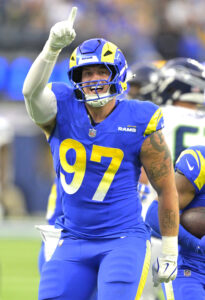 Brown stepped into the Rams’ starting lineup following the free agency exits of Greg Gaines and A’Shawn Robinson. Sneaking into PFR’s top 50 (at No. 48), Brown will bring his run-defending skills to Charlotte. Despite Brown only commanding a three-year, $21MM deal that came with only $6.8MM at signing, the Rams moved on via Poona Ford. Brown started 29 games over the past two seasons, grading as a top-30 run defender among interior D-linemen (per PFF). The Rams clearly believe Ford has a higher ceiling based on what he showed in 2024.
Brown stepped into the Rams’ starting lineup following the free agency exits of Greg Gaines and A’Shawn Robinson. Sneaking into PFR’s top 50 (at No. 48), Brown will bring his run-defending skills to Charlotte. Despite Brown only commanding a three-year, $21MM deal that came with only $6.8MM at signing, the Rams moved on via Poona Ford. Brown started 29 games over the past two seasons, grading as a top-30 run defender among interior D-linemen (per PFF). The Rams clearly believe Ford has a higher ceiling based on what he showed in 2024.
The Rams scaled back Hoecht’s workload last season, dropping him from an 85% snap rate in 2023 to 57% in ’24. Hoecht landed the same terms as Brown (3/21) but scored a $12.43MM Bills guarantee at signing. Hitting on edge rushers in back-to-back drafts (Byron Young, Jared Verse), the Rams are well situated here.
Rozeboom joins Brown, as Ejiro Evero continues to add ex-Ram charges to his Panthers defense. Rozeboom made 11 starts last season and logged a career-high 828 snaps. The Rams have Nathan Landman in position to join ex-UDFA Omar Speights as ILB regulars, as the team continues bottom-barrel investments at this position.
Draft:
- Round 2, No. 46 (from Falcons): Terrance Ferguson (TE, Oregon) (signed)
- Round 3, No. 90: Josaiah Stewart (OLB, Michigan) (signed)
- Round 4, No. 117 (from Colts): Jarquez Hunter (RB, Arizona) (signed)
- Round 5, No. 148 (from Bears): Ty Hamilton (DT, Ohio State) (signed)
- Round 5, No. 172 (from Seahawks through Vikings): Chris Paul Jr. (LB, Ole Miss) (signed)
- Round 7, No. 242 (reacquired from Falcons): Konata Mumpfield (WR, Pitt) (signed)
While teams were leery of the Rams drafting a quarterback, the NFC West club again opted to table its need for a Matthew Stafford heir apparent. The Rams were reported to be in on Jaxson Dart, but post-draft reporting disputed that interest. (Then again, Dart said he spent considerable time with Rams brass during the draft runup.) This was not viewed as a good quarterback class, beyond Cam Ward, but the Rams added an asset that would help them invest in what is viewed as a much better crop come 2026.
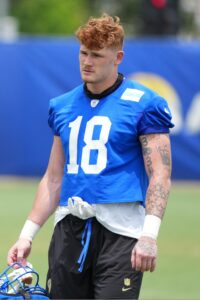 Discussing terms with the Giants, the Rams ended up watching the Texans trade down (from No. 25) to allow Big Blue to draft Dart. A Falcons edge-rushing issue that dates back pretty much to John Abraham‘s 2013 free agency departure then allowed the Rams to pick up a prime future asset. Atlanta sent Los Angeles a 2026 first-rounder to move up 20 spots for James Pearce Jr. Although the Rams showed interest in moving up for a skill-position player, the Falcons’ offer presented an interesting opportunity.
Discussing terms with the Giants, the Rams ended up watching the Texans trade down (from No. 25) to allow Big Blue to draft Dart. A Falcons edge-rushing issue that dates back pretty much to John Abraham‘s 2013 free agency departure then allowed the Rams to pick up a prime future asset. Atlanta sent Los Angeles a 2026 first-rounder to move up 20 spots for James Pearce Jr. Although the Rams showed interest in moving up for a skill-position player, the Falcons’ offer presented an interesting opportunity.
Even if Arch Manning does not declare for next year’s draft, the prospect pool is viewed as far deeper than 2025’s. The Rams have used two first-round picks on QBs this century (Sam Bradford, Jared Goff) and traded both of them, building around Stafford with the latter move. That proved wise, but with the rocket-armed passer 37 and potentially breaking down, pressure will be high for the Rams to come up with a young solution next year. This Atlanta pick will provide a considerable boost to such a path forming.
Before trading out of No. 26, the Rams — who aggressively pursued Brock Bowers last year — were connected to Tetairoa McMillan, Emeka Egbuka and this draft’s top two tight ends (Colston Loveland, Tyler Warren). L.A. sent Carolina an offer for No. 8, and the Panthers viewed the proposal as a McMillan-based play. No deal commenced, and the Panthers chose McMillan. The Rams circled back to the skill positions in Round 2, choosing Ferguson ahead of soon-to-be Seahawk Elijah Arroyo.
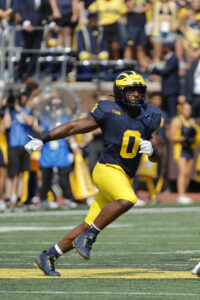 Playing with Bo Nix and Dillon Gabriel at Oregon, Ferguson split time between in-line and slot roles with the Ducks. He upped his per-catch average from 9.9 in 2023 to 13.7 last season, totaling a career-best 591 yards as a senior.
Playing with Bo Nix and Dillon Gabriel at Oregon, Ferguson split time between in-line and slot roles with the Ducks. He upped his per-catch average from 9.9 in 2023 to 13.7 last season, totaling a career-best 591 yards as a senior.
The 6-foot-5 weapon will be positioned to learn from 10th-year Ram Tyler Higbee and Colby Parkinson, but given the draft status, the team will expect an early role. While Higbee is healthier than he was at this time last year, he will be 33 before season’s end. Parkinson’s Rams debut also ended short of 300 yards. Although Ferguson is a big step down on the TE prospect totem pole compared to Bowers, Loveland and Warren, the Rams will attempt to mold him as a Higbee successor.
The Rams have done well to stock their front seven in recent years, hitting on Verse, Young, Kobie Turner and Braden Fiske. They went to that well again with Stewart. One of the most productive sack artists in recent draft history, Stewart posted 30 from 2021-24. A move up the ladder from Coastal Carolina to Michigan probably limited his production, after a 12.5-sack, 16-TFL freshman season. But he contributed 8.5 sacks and 13 TFLs for the Wolverines last season.
Stewart also has the luxury of serving as, at best, a third edge rusher behind Young and Verse during his first two seasons. The team has hit on many Day 2 and Day 3 defenders during Les Snead‘s GM run, making Stewart’s growth something to monitor.
Trades:
 One of the bigger free agency busts in recent years, Jackson spent much of his Rams season on the bench. The Rams gave Jackson a three-year, $51MM deal ($25.5MM guaranteed) to pry him from Detroit, plugging the four-year Lions starting guard into their left guard position. This relocated 2023 LG Steve Avila to center. Just before last season, however, Jackson moved to center to send Avila back to guard.
One of the bigger free agency busts in recent years, Jackson spent much of his Rams season on the bench. The Rams gave Jackson a three-year, $51MM deal ($25.5MM guaranteed) to pry him from Detroit, plugging the four-year Lions starting guard into their left guard position. This relocated 2023 LG Steve Avila to center. Just before last season, however, Jackson moved to center to send Avila back to guard.
Neither plan worked. The Rams lost Jackson early in the season and did not deem him good enough to redeploy him as a starter for long upon return. Jackson played behind Day 3 rookie Beaux Limmer for much of last season, preceding the team allowing Jackson’s camp to seek a trade.
Fortunately for the Rams, the Bears did not require the NFC West team to eat any of Jackson’s 2025 salary. Jackson reunited with ex-Lions OC Ben Johnson and has since agreed to an extension (three years, $44.5MM). Signing bonus proration covered the dead money here, leaving only an $8.5MM sum post-trade. Essentially, the Rams and Bears swapped starters up front (Jackson for Coleman Shelton).
Other:
Ramsey would have added a third 30-something corner on the Rams’ roster, though McVay spoke highly of his former charge to the point a reunion looked like a real possibility. A Ramsey West Coast preference emerged, giving a Rams return more steam.
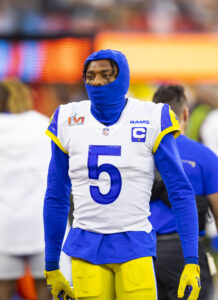 Ramsey, 30, spent three-plus seasons in L.A. and helped the team win a Super Bowl. The Dolphins, though, gave him a three-year, $72.3MM extension before last season. That complicated this year’s trade derby. Miami ended up doing well on a trade, convincing Pittsburgh (with Jonnu Smith thrown in as a sweetener) to take on $19MM of Ramsey’s 2025 compensation and give up Minkah Fitzpatrick. It seems unlikely the Rams made a comparable offer.
Ramsey, 30, spent three-plus seasons in L.A. and helped the team win a Super Bowl. The Dolphins, though, gave him a three-year, $72.3MM extension before last season. That complicated this year’s trade derby. Miami ended up doing well on a trade, convincing Pittsburgh (with Jonnu Smith thrown in as a sweetener) to take on $19MM of Ramsey’s 2025 compensation and give up Minkah Fitzpatrick. It seems unlikely the Rams made a comparable offer.
Part of the Rams’ front office when they acquired and then traded Ramsey, Gladstone spent much of his time with the team as its director of scouting strategy. After the finds the Rams made outside Round 1, Gladstone will follow Brad Holmes as a Rams scouting-side exec to a GM post. Gladstone joins ex-Rams OC Liam Coen in Jacksonville, though the latter is believed to be atop the Jaguars’ personnel pyramid. McVay’s coaching tree receives more attention, but Snead’s GM tree expanded this offseason.
Speaking of McVay’s tree, Caley is the latest Rams assistant to move into a coordinator role. Hired from the Patriots in 2023, Caley coached the Rams’ tight ends. He had turned down the Patriots’ OC job in 2024 and passed on Jets 2025 interest; the ex-McVay and Bill Belichick assistant will now work with C.J. Stroud in Houston. Caley, 42, had also been the Rams’ pass-game coordinator.
Scheelhaase is now in that role, having backed out of the Jaguars’ OC search. The staffer that ended up taking the Pats’ 2024 OC job, Van Pelt, joins Lake — a 2023 Rams staffer whom Raheem Morris fired after one season as Falcons DC — as notable names joining McVay’s staff.
Top 10 cap charges for 2025:
- Matthew Stafford, QB: $47.47MM
- Kevin Dotson, G: $17.92MM
- Davante Adams, WR: $12MM
- Rob Havenstein, RT: $11.37MM
- Tutu Atwell, WR: $10MM
- Colby Parkinson, TE: $9.83MM
- Darious Williams, CB: $9.17MM
- Tyler Higbee, TE: $8.78MM
- Alaric Jackson, LT: $7MM
- Poona Ford, DL: $5.08MM
McVay said in April he viewed Stafford as a candidate to play a few more seasons. It would seem unlikely the ninth-year Rams HC would say as much now. The team may need Garoppolo more than it did last season, but its Super Bowl hopes will certainly hinge on keeping Stafford available. Available may be the team’s best bet here; a healthy Stafford might not be a real option for the 2025 Rams.
If Stafford can stay in the lineup, the Rams have equipped him with an improved skill-position corps. With the Verse-Turner-Fiske-Young quartet a year more experienced, the Rams should roll out a formidable pass rush as well. With questions surrounding the 49ers’ roster and (again) skill-position health, the Rams have a clear playoff route in front of them. Can their aging QB make it to the finish line?
By Adam La Rose |
at August 19, 2025 10:20 pm
Year 2 of Jordan Love’s tenure atop the Packers’ quarterback depth chart produced another playoff berth amidst a strong showing against several middling and subpar opponents. On the other hand, Green Bay went a combined 0-6 between the regular and postseason against the Eagles, Lions and Vikings. Even a season of double-digit wins thus demonstrated the need for further improvement.
By and large, the past several months have been quiet for the Packers. Beyond some big-ticket free agency additions, few major roster changes have taken place in anticipation of the 2025 campaign — one when the NFC North should again be very strong. If the team is to emerge as one of the league’s true heavyweights, a number of familiar faces will be relied on this year.
Free agency additions:
- Aaron Banks, G. Four years, $77MM ($27MM guaranteed)
- Nate Hobbs, CB. Four years, $48MM ($16MM guaranteed)
- Isaiah Simmons, LB. One year, $1.38MM ($168K guaranteed)
- Mecole Hardman, WR. One year, $1.5MM ($150K guaranteed)
- Kristian Welch, LB. One year, $1.17MM
- Corey Ballentine, CB. One year, $1.17MM
- Lecitus Smith, OL. One year, $1.03MM
- Tyrion Davis-Price, RB. One year, $1.03MM
- Isaiah Neyor, WR. One year, $840K
- Jared Bartlett, LB. One year, $840K
- Garnett Hollis Jr., CB. One year, $840K
Last spring, the Packers made a pair of major splashes on the open market. The investments made in safety Xavier McKinney and running back Josh Jacobs proved worthwhile in Year 1, with both players receiving a Pro Bowl invitation and McKinney landing a first-team All-Pro nod. General manager Brian Gutekunst noted in February, however, that 2025 would not feature as many big swings in free agency. 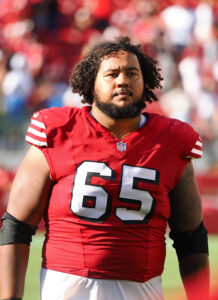
Indeed, only two notable new faces arrived as part of this year’s class. Banks was not a factor during his rookie campaign in San Francisco, but the following three seasons saw him operate as a full-time starter. The former second-rounder avoided major injury over that span, playing a key role in the 49ers’ offense and playing his way out of a second deal with the team. San Francisco had a number of other financial priorities, leaving Banks (PFR’s No. 21 free agent) as one of the best interior blockers available this spring.
As expected, Banks departed the Bay Area early in free agency. The Notre Dame product secured an AAV of $19.25MM, a figure which ranked fifth for guards at the time (Trey Smith has since replaced his franchise tag with a market-topping Chiefs extension). Expectations will certainly be high for Banks as a result; he will replace Elgton Jenkins at the left guard spot for the foreseeable future.
Set to turn 28 in September, Banks has not drawn standout evaluations from Pro Football Focus to date in his career. Pass protection in particular has been an issue, although 2024 marked his best campaign in terms of run blocking grade and overall evaluation. Still, Banks has finished no better than 33rd amongst guards so far. Banks’ free agent market would stand to disagree with PFF’s assessments, but the Packers are certainly banking on an uptick readies to debut for his second career team.
Keeping with organizational policy, Hobbs joined Banks in receiving his only fully guaranteed money in the form of a signing bonus. He can nevertheless be counted on to remain in the fold through at least 2026 based on the structure of his pact. A full-time starting gig awaits the former Raider for however long he is in place with Green Bay.
 Hobbs saw time on the perimeter while playing out his rookie contract, but the Raiders primarily deployed him in the slot. The former fifth-rounder is expected to be used in both capacities with his new team, one which enters the season with questions in the secondary. Hobbs, 26, missed a total of 17 games across his four Raiders campaigns. In addition to high-end play, availability will be a central goal over the coming years in his case as a result.
Hobbs saw time on the perimeter while playing out his rookie contract, but the Raiders primarily deployed him in the slot. The former fifth-rounder is expected to be used in both capacities with his new team, one which enters the season with questions in the secondary. Hobbs, 26, missed a total of 17 games across his four Raiders campaigns. In addition to high-end play, availability will be a central goal over the coming years in his case as a result.
A preventative knee surgery took place earlier this month, so while Hobbs could be back to full strength in time for the start of the season his Green Bay tenure has not gotten off to a worry-free start on the health front. Provided the Illinois product can stay on the field, though, continued improvement in terms of pass coverage – coming off personal bests in completion percentage and passer rating allowed in 2024 – would make him a worthwhile addition.
The Packers were among the teams which showed interest in former first-rounder Damon Arnette. After a one-year spell in the UFL, Arnette put himself back on the NFL radar and ultimately landed with the Texans. Green Bay did not take a flier in that instance, but the team did so in the case of Simmons.
The former Cardinals top-10 pick struggled in Arizona while failing to find a permanent role on defense. A trade to the Giants allowed Simmons to spend 2024 in New York; he appeared in every game while seeing sparse usage on defense and special teams. The 27-year-old will work full-time as a linebacker in Green Bay. Success in that capacity could result in a stronger market next spring.
Re-signings:
Prior to free agency, it became clear the Packers intended to retain McManus for 2025 and beyond. Such a stance was certainly understandable given the veteran’s showings in 11 Green Bay games last year. McManus missed only two of his 23 total field goal attempts during the regular season and playoffs. The 34-year-old was also perfect on extra points. 
McManus saw his nine-year Broncos run come to an end in 2023; that resulted in a 17-game period handling kicking duties with the Jaguars. A free agent signing with the Commanders followed, although the Super Bowl 50 winner was then named in a lawsuit alleging sexual assault during an international flight during his Jacksonville tenure. The Commanders cut McManus, but after the league’s decision not to suspend him another fresh start become available.
In the wake of the Anders Carlson selection not panning out as hoped, the Packers cycled through several options before finding stability in the form of McManus. The Temple product is now in position to serve as a (relatively) long-term Mason Crosby successor, provided he plays out at least most of his current pact. At an AAV of $5.1MM, McManus’ deal sits tied for ninth amongst kickers in annual compensation.
Over the course of his four Green Bay seasons, McDuffie has seen a year-over-year jump in playing time. The former sixth-rounder’s defensive snap share checked in at 64% in 2024 and he started every game. Coming off a career high in tackles (97), McDuffie is once again set to serve as an important contributor at the second level of Green Bay’s defense alongside Quay Walker and Edgerrin Cooper. No member of that trio is attached to a lucrative pact, and McDuffie’s modest second NFL accord could prove to be valuable if he manages to duplicate last year’s play.
Notable losses:
- Jaire Alexander, CB (released)
- Kahzir Brown, S (waived)
- Sam Brown Jr., WR (waived/injured)
- Andre Dillard, LT
- AJ Dillon, RB
- Tulu Griffin, WR (waived)
- Alex Hale, K (waived)
- Kaleb Hayes, CB (waived)
- Marquis Hayes, OL (released)
- Janson Jake, WR (waived)
- Gregory Junior, CB (waived)
- Jeremiah Martin, DL (waived/injured)
- Josh Myers, C
- Leonard Payne, DT (waived)
- Robert Rochell, CB
- Nesta Jade Silvera, DT (waived)
- T.J. Slaton, DT
- Eric Stokes, CB
- Eric Wilson, LB
- Cameron Young, DT (waived)
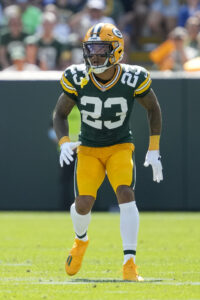 As soon as the Nate Hobbs signing took place, the chances of an Alexander departure increased. The latter spent his first seven years in Green Bay, landing what was at signing a market-topping cornerback extension based on his early play. Considerable missed time increasingly became a problem in Alexander’s case, however.
As soon as the Nate Hobbs signing took place, the chances of an Alexander departure increased. The latter spent his first seven years in Green Bay, landing what was at signing a market-topping cornerback extension based on his early play. Considerable missed time increasingly became a problem in Alexander’s case, however.
Having missed double-digit games three of the past four seasons, Alexander was not a feasible candidate to continue playing out the remaining two years of his $21MM-per-year pact absent an adjustment. Trade talks took place over an extended period, but to no surprise suitors were hesitant about taking on his contract. A pay cut was offered in May; in the absence of an agreement on that front, Alexander remained a strong candidate to play elsewhere in 2025.
The two-time Pro Bowler made it clear a release would be preferred to a trade (all the while maintaining the expectation a new Packers arrangement would eventually be worked out). Green Bay’s restructure offer would have set Alexander up for free agency in 2026, but the proposal did not include any up-front guarantees for this season. In the end, the Packers decided to proceed with a release — without a post-June 1 designation. As a result, a $17MM-plus dead cap charge will be applied to 2025 before Alexander’s contract comes off the books entirely next year. 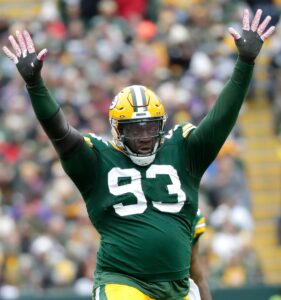
As expected, free agent interest emerged immedicably after the release took place. Turning aside more lucrative offers, Alexander chose to reunite with former Louisville teammate Lamar Jackson by taking a one-year Ravens deal. A healthy showing within Baltimore’s highly regarded secondary could result in a notable free agent market next spring. Failing that, the 28-year-old could very well struggle to move his earning power back to where it once was.
Slaton certainly outperformed expectations while playing out his rookie contract in Green Bay. The former fifth-rounder saw part-time work during his first two seasons and developed into a full-time starter after that. In 2023, Slaton handled a career-high snap share of 56% and set a new personal mark with 50 tackles.
While the 27-year-old’s playing time and output took a downturn last season, he played his way into a Bengals pact on the open market. Slaton will continue to serve as a run-stopping presence with his new team. Green Bay ranked seventh against the run in 2024, and remaining strong in that regard without their recent nose tackle starter will be key.
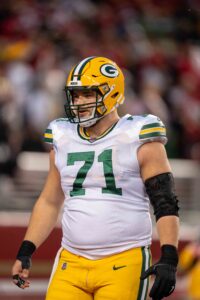 Myers represents the most notable loss on offense. A 56-game starter with Green Bay, his preference was to remain in place on his second contract. Instead, a departure took place by means of a Jets deal which may not result in the starting gig. Myers, 27, ranked between 26th and 38th in terms of center PFF grades during his Packers tenure. The team will aim for improvement with its new arrangement up front.
Myers represents the most notable loss on offense. A 56-game starter with Green Bay, his preference was to remain in place on his second contract. Instead, a departure took place by means of a Jets deal which may not result in the starting gig. Myers, 27, ranked between 26th and 38th in terms of center PFF grades during his Packers tenure. The team will aim for improvement with its new arrangement up front.
Like Alexander, Stokes struggled to remain healthy and thus to meet expectations in Green Bay. The former first-rounder managed to play 17 games last year, but he did so while logging the lowest snap share (54%) of his career. A starting spot should await Stokes with the Raiders, but his role could change in the event of a late-summer cornerback addition being made in Vegas.
Over the course of his three seasons in Green Bay, Wilson took on an increased workload both on defense and special teams. His 12 starts and 558 defensive snaps were the second most of his career, so the 30-year-old’s absence could be felt in 2025. The Packers will face Wilson at least twice this season since he returned to the Vikings on the open market.
Read more
Extensions and restructures:
In time for training camp, a major (but expected) raise came to fruition in Tom’s case. Following a rookie campaign which saw Tom handle part-time usage at multiple positions, the 26-year-old settled into an effective role as Green Bay’s right tackle. Tom ranked 15th amongst qualifying tackles in PFF grade for 2024, and he improved to sixth last season. With three of the blockers above him in that regard playing on the blind side, it comes as no surprise the Packers authorized one of the most lucrative right tackle pacts in this case. 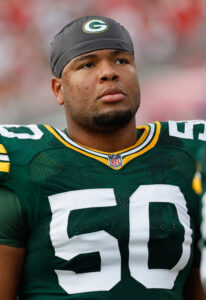
Tom’s $22MM average annual value ranks third in the NFL at the RT spot. That is also true with respect to all current Packers contracts (behind only quarterback Jordan Love and edge rusher Rashan Gary). As the highest-paid member of Green Bay’s offensive line, expectations will be elevated in Tom’s case; he will certainly have plenty of time to meet them since he is under contract through 2029 as a result of the new accord.
The starting left tackle position is up for grabs as the Packers look for their ideal five-man combination up front. That could see Rasheed Walker maintain his spot on the blind side, although 2024 first-rounder Jordan Morgan is an candidate to unseat him. In any case, Tom will be counted on as an anchor up front now and for years to come. Continued performances as one of the league’s top tackles – especially given his age – would prove the Wake Forest product to be a worthwhile commitment on the team’s part. Given Tom’s track record to date, this investment should be viewed as a safe one.
Draft:
- Round 1, No. 23: Matthew Golden (WR, Texas) (signed)
- Round 2, No. 54: Anthony Belton, T (NC State) (signed)
- Round 3, No. 87: Savion Williams (WR, TCU) (signed)
- Round 4, No. 124: Barryn Sorrell (DE, Texas) (signed)
- Round 5, No. 159: Collin Oliver (DE, Oklahoma State) (signed)
- Round 6, No. 198: Warren Brinson (DT, Georgia) (signed)
- Round 7, No. 237 (from Steelers): Micah Robinson (CB, Tulane) (signed)
- Round 7, No. 250*: John Williams (G, Cincinnati) (signed)
 Prior to the Golden selection, 2002 marked the Packers’ most recent first-round investment in a receiver. Several Day 2 picks have proven fruitful, but relying on them almost exclusively throughout the Aaron Rodgers era increasingly became a talking point regarding organizational practice. As hosts of the draft this April, Green Bay elected to take a different route.
Prior to the Golden selection, 2002 marked the Packers’ most recent first-round investment in a receiver. Several Day 2 picks have proven fruitful, but relying on them almost exclusively throughout the Aaron Rodgers era increasingly became a talking point regarding organizational practice. As hosts of the draft this April, Green Bay elected to take a different route.
Golden delivered a strong one-and-done campaign with the Longhorns. The former Houston product transferred within the state for 2024 and posted a 58-987-9 statline. Down the stretch in particular, he emerged as a major contributor and showcased his ability as a deep threat. At the Combine, a 4.29 40-yard dash time further cemented Golden’s status as one of the top receiver prospects in this year’s class.
The Packers showed interest in one of the other premier WR options, Tetairoa McMillan. A move up the board proved to be unfeasible, though, with the Panthers staying pat at No. 8. Trade calls came in for the 23rd pick from the Eagles, but Green Bay also elected to remain in place. As a result, Golden is positioned to operate as a key figure in the team’s oft-discussed (based on an unclear pecking order) receiving corps.
With Golden and Williams – who enjoyed a 60-catch campaign in 2024 and, at 6-foot-5, will bring a notable size element to the Packers’ offense – being added, further questions were raised about how things would shake out at the position. Indeed, the rookie wideouts will spend their initial NFL campaigns competing for targets with Christian Watson (when healthy), Jayden Reed, Romeo Doubs, Dontayvion Wicks and Malik Heath, with Mecole Hardman also a depth option if his role expands beyond return duties. 
Indeed, Reed expressed (through his agent) concerns about his role moving forward. Two years remain on Reed’s rookie contract, and the same is true of Wicks. Watson and Doubs are pending 2026 free agents, though, so expanded workloads for Golden in particular and potentially Williams next year could be in store. How the wideout pecking order gets sorted out will be interesting to monitor on an offense filled with returnees at the skill positions.
An older prospect due to his two years at Georgia Military College, Belton finished his college career with three straight seasons as a starting left tackle. The 336-pounder could offer depth on the blind side, but a more realistic projection would see him line up at guard in the NFL. In either case, a path to an immediate starting role does not appear to exist.
Aaron Banks and fourth-year Packer Sean Rhyan are positioned to handle first-team duties at each guard spot in 2025. The latter is entering the final year of his rookie pact, meaning a free agent departure could be on tap next spring. If that were to take place, Jordan Morgan would become a candidate for the starting right guard gig. The same would also, presumably, be true in Belton’s case Failing that, a multiyear run as a backup option could be in store.
Other:
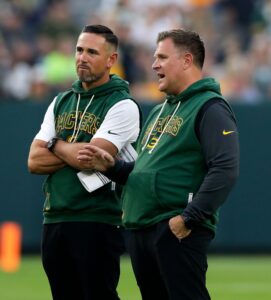 In March, the matter of a Tush Push ban proved to be divisive amongst NFL decision-makers. A vote on the matter was postponed before the language of Green Bay’s proposal was altered. The team’s attempt to return rules on pushing ball carriers to pre-2005 standards received support, with 22 teams voting in favor in May.
In March, the matter of a Tush Push ban proved to be divisive amongst NFL decision-makers. A vote on the matter was postponed before the language of Green Bay’s proposal was altered. The team’s attempt to return rules on pushing ball carriers to pre-2005 standards received support, with 22 teams voting in favor in May.
That fell just short of the required three-fourths majority for rule changes, however. Last-minute efforts on the part of the Eagles resulted in sufficient support for keeping the play alive in 2025, at least. Further attempts at a ban in the future would come as no surprise, and the Packers may again find themselves playing a leading role in that respect.
The planned succession from Murphy to Ed Policy — son of former 49ers GM Carmen Policy — took place as expected, setting up stability on the business side of the franchise for years to come. Continuity will also be witnessed on the sidelines and in the front office for 2025. The matter of new commitments for LaFleur and/or Gutekunst will become a talking point over the course of the campaign given the decision to avoid extensions this offseason.
Policy noted his disdain for head coaches or general managers operating under lame-duck status. As a result, new contracts in both cases should be expected, barring a major disappointment over the coming months. LaFleur ranks seventh in terms of the league’s longest-tenured head coaches. Gutekunst, meanwhile sits (for all intents and purposes) in 11th in that respect amongst general managers. The Packers sport a .670 regular season winning percentage since LaFleur’s first season (2019), and they have reached the postseason five times in seven years under Gutekunst. 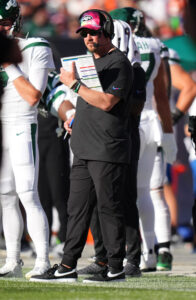
That pair will have a familiar face back in the fold with Hackett returning to Green Bay. The 45-year-old’s head coaching gig with the Broncos proved to be disastrous, and his reunion with Aaron Rodgers as the Jets’ offensive coordinator did not fare much better. Hackett’s background is on the offensive side of the ball, but his return will include duties as an analyst working with the Packers’ defense. That unit enjoyed a strong first year under Jeff Hafley in 2024, and maintaining its success could allow for Hackett to begin rebuilding his coaching stock.
Green Bay’s defensive staff will have another ex-coordinator in the form of Covington. After seven years on the Patriots’ staff, he took on defensive coordinator responsibilities under Jerod Mayo in 2024. With Mike Vrabel coming in following the one-and-done Mayo tenure, though, Covington was among the staffers who found themselves on the move during the coaching cycle. The ninth-year NFL staffer interviewed for Cincinnati’s DC position before taking his new role in Green Bay. The team’s defensive front will be a unit to watch closely given its expectations, and Covington, 36, figures to play a key role in its performance.
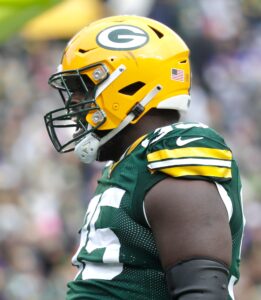 The statuses of both Wyatt and Walker became a talking point dating back to before the start of the 2024 season. Both former Georgia teammates remained regulars last season, although Wyatt saw his snap share drop compared to the previous year (down from 50% to 41%). A statistical fall-off did not ensue, however.
The statuses of both Wyatt and Walker became a talking point dating back to before the start of the 2024 season. Both former Georgia teammates remained regulars last season, although Wyatt saw his snap share drop compared to the previous year (down from 50% to 41%). A statistical fall-off did not ensue, however.
Wyatt managed five sacks and 12 quarterback pressures in 2024, further establishing his presence as a disruptive presence along the interior. The 27-year-old still faces questions about his run defense, though, and improvement in that regard will be needed as he takes on a full-time starting gig. T.J Slaton’s departure will allow Wyatt to assume a larger role in preparation for a notable raise in 2026. A step forward would make an extension decision easier for Green Bay, a team which has Kenny Clark on the books for another three seasons.
It came as little surprise when Walker’s option was declined. The merging of inside and outside linebackers for the purpose of option valuations has led to a growing trend of teams opting for early free agency in cases such as his. Still, Gutekunst made it clear in April he intended to keep both Wyatt and Walker in the fold beyond 2025. The latter has already been the subject of extension talks, so a long-term pact could be in store down the road.
Walker, 25, has filled the statsheet so far with 341 tackles and 6.5 sacks to his name. He has yet to miss considerable time through injury, and a regular partnership alongside highly touted 2024 second-rounder Edgerrin Cooper could prove to be effective. Walker will not collect a top-eight linebacker salary in 2026 (as he would have in the event of his option being picked up), but a considerable increase compared to his scheduled $4.4MM this year will be required if a long-term arrangement is to be worked out. 
Jenkins was initially hesitant about switching positions, and he sought a contract adjustment reflecting his new role. The two-time Pro Bowler is aware by now, however, that no such development will take place. The top of the guard market comfortably outpaces that of centers, a financial reality Jenkins and his camp is well aware of. The last holdover from the Rodgers MVP years, Jenkins has seen his four-year, $68MM contract drop from first among Packer O-linemen to third. No guaranteed money remains on the 29-year-old blocker’s deal for 2026; any extension worked out next spring will no doubt be influenced heavily by the differing financial landscape up front.
Given the young (and highly inexpensive nature) of Green Bay’s receiver room, a move like bringing back Adams or acquiring a less familiar high-profile wideout certainly would have altered the roster balance of that position. An Adams reunion in particular could have elevated the team’s expectations through the air. Instead, he returned to the West Coast on a Rams deal. Pickens and Kupp will reside in the NFC as well in 2025 as the Packers aim for further internal growth at the WR spot.
Melton will not play a role in that effort, with his cornerback experiment proceeding on a full-time basis. Retained on an ERFA tender this offseason, the 26-year-old’s earning power for next year (with Green Bay or another team, if he winds up being non-tendered) will be determined by the success of his play on defense.
Top 10 cap charges for 2025:
- Jordan Love, QB: $29.69MM
- Rashan Gary, OLB: $25.77MM
- Kenny Clark, DT: $20.37MM
- Xavier McKinney, S: 17.85MM
- Elgton Jenkins, C: $17.6MM
- Josh Jacobs, RB: $11.33MM
- Aaron Banks, LG: $9.03MM
- Zach Tom, RT: $7.37MM
- Keisean Nixon, CB: $6.84MM
- Nate Hobbs, CB: $5.99MM
Continuity amongst Green Bay’s core should be expected in the intermediate future with each of these 10 players listed on the books for 2026 as well. Among those projected to see a major spike in cap charge from one year to the next are Clark and Banks, so they will be candidates for contract adjustments next spring. The Packers will carry over $35MM in dead money charges in 2025.
Not unlike the Texans in the AFC, the Packers enter the coming season with a track record of being able to reach the postseason but questions about their ability — in the Love years, at least — to sustain a run to the Super Bowl. Love’s 2024 inconsistency fueled criticism of Green Bay’s $55MM-per-year commitment to him, and the third-year starter’s performance will of course receive considerable scrutiny throughout the season as he looks to truly establish himself among the game’s elite under center.
The division rival Lions and Vikings return strong rosters, and a new Bears staff is the source of optimism for development in Chicago. Meanwhile, 2024 contenders in the conference should once again present challenges this year. Whether or not Green Bay’s (largely intact) core can take a step forward will be one of the NFC’s most important storylines in 2025.
By Sam Robinson |
at August 18, 2025 10:14 pm
Last season further entrenched the Bills in an impressive but unfortunate contingent in NFL history. In booking a seventh playoff berth in eight seasons (six of those with Josh Allen at the helm), this Buffalo nucleus is firmly among the best — along with the Air Coryell Chargers, Marty Schottenheimer‘s Browns and Chiefs squads, and probably the Ravens’ Lamar Jackson-era crew (among others) — to not reach a Super Bowl. After 2024 brought a retooling offseason that lowered expectations, last year’s run to the Super Bowl LIX precipice restored them for 2025.
As the Bills continue their agonizing trend of controlling the regular-season Chiefs rivalry before losing each playoff rematch, they went to work augmenting key areas. But ensuring a batch of early-2020s draft choices remained in Buffalo long term defined this offseason. One extension towered among the others in value and importance, but a host of reasonably priced paydays set up this Bills core for the decade’s remainder.
Extensions and restructures:
The Allen contract came without rumored talks. That theme persisted, with one notable exception, as the Bills planned their paydays. Allen entered the offseason tied to what had become a wildly team-friendly deal, as the QB market exploded beyond the $50MM-per-year rate and as Allen had established himself as a megastar. The Bills did not technically need to do anything after the seven-year veteran’s MVP season; his six-year extension (agreed to in August 2021) ran through the 2028 slate. But as the market had moved the Buffalo icon out of the top 10 among QBs, the team acted.
 Allen’s new contract is more of a lucrative rework than a true extension. Only two new years are included; the QB is now tied to the Bills through the 2030 season. But the Bills rewarded their franchise cornerstone with a massive guarantee influx. Allen, 28, received what amounts to a $90MM raise on his previous deal. The fully guaranteed money represented the lead item here. Allen’s $147MM figure is well south of Deshaun Watson‘s $230MM, but this contract beats every other deal in terms of fully guaranteed money. Although Allen could not catch Dak Prescott‘s massive $60MM-AAV accord — one achieved with far more leverage than the Bills QB carried — he topped the Cowboys passer in upfront guarantees.
Allen’s new contract is more of a lucrative rework than a true extension. Only two new years are included; the QB is now tied to the Bills through the 2030 season. But the Bills rewarded their franchise cornerstone with a massive guarantee influx. Allen, 28, received what amounts to a $90MM raise on his previous deal. The fully guaranteed money represented the lead item here. Allen’s $147MM figure is well south of Deshaun Watson‘s $230MM, but this contract beats every other deal in terms of fully guaranteed money. Although Allen could not catch Dak Prescott‘s massive $60MM-AAV accord — one achieved with far more leverage than the Bills QB carried — he topped the Cowboys passer in upfront guarantees.
Some 14 months after Patrick Mahomes‘ outlier 10-year extension, Allen became the only quarterback to agree to a deal beyond five years. This helped the Bills, who have gone to the restructure well like the Chiefs have. Buffalo needed to make an adjustment, as Kansas City did with its megastar talent in September 2022, but the team still has Allen signed for six more seasons. That will help establish cost certainty — for a while, at least — at Allen’s apex.
Having Allen at the same AAV of Trevor Lawrence and Jordan Love — even after a $24MM offseason cap surge — should age quite well. Mahomes’ historic Chiefs impact notwithstanding, the three-time Super Bowl champion has Andy Reid calling the shots and the perennially underrated Steve Spagnuolo providing defensive fortification. Travis Kelce, for most of Mahomes’ career at least, being a dominant tight end helped raise the QB’s floor as well. Allen has lacked these amenities, for the most part, and an argument can be made — as it was last year — he is the NFL’s most indispensable player.
 The Bills have continued to receive full participation from their dual-threat dynamo, despite regular punishment on scrambles and designed runs. Allen has logged 759 regular-season carries and 112 more in the playoffs, signing up for hits Jackson deftly avoids in the process. Obviously important as a passer, Allen’s run-game prowess separates him as an all-time talent. Allen already ranks sixth in career QB carries; he will move into fourth early this season. While the Bills may need to rein in their do-it-all player on that front at some point to ensure he remains elite through the duration of this contract, the franchise is enjoying the spoils of its two-trade-up 2018 presently.
The Bills have continued to receive full participation from their dual-threat dynamo, despite regular punishment on scrambles and designed runs. Allen has logged 759 regular-season carries and 112 more in the playoffs, signing up for hits Jackson deftly avoids in the process. Obviously important as a passer, Allen’s run-game prowess separates him as an all-time talent. Allen already ranks sixth in career QB carries; he will move into fourth early this season. While the Bills may need to rein in their do-it-all player on that front at some point to ensure he remains elite through the duration of this contract, the franchise is enjoying the spoils of its two-trade-up 2018 presently.
Dion Dawkins‘ NFL arrival predates Allen’s, but the Bills went to work on fortifying their younger core this year. That meant deals for starters drafted in 2021 and ’22. Shakir’s extension began this mission in February, and the blueprint (barring a late-summer accord perhaps with an interior O-lineman) ended with Cook’s hold-in leading to an agreement last week.
After five smooth negotiations, the Bills reached choppy waters during Cook’s. The 2024 Pro Bowler threw a $15MM-per-year price point out there, and initial talks in the spring did not progress. Brandon Beane then pointed to the two-year running back starter needing to begin his contract year unsigned. Fortunately for all parties, that did not end up happening. Cook skipped OTAs but reported for minicamp. This off-and-on work schedule persisted into training camp, when the former second-round pick participated initially before shifting to a hold-in strategy before returning to practice. A day after Cook suited up, a deal unsurprisingly emerged.
 The 2024 running back resurgence did bring a market reset, thanks to Saquon Barkley‘s otherworldly season, and Derrick Henry receiving $25MM guaranteed at signing despite being 31. Beyond those Hall of Fame-caliber talents, no true shift occurred. Last fall established a second tier at the position, with James Conner, Chuba Hubbard and David Montgomery following Rhamondre Stevenson in landing extensions between $8.3MM and $9.5MM per year. Alvin Kamara‘s third Saints contract came in at $12.25MM AAV. This offseason brought two notable deals in between those goalposts.
The 2024 running back resurgence did bring a market reset, thanks to Saquon Barkley‘s otherworldly season, and Derrick Henry receiving $25MM guaranteed at signing despite being 31. Beyond those Hall of Fame-caliber talents, no true shift occurred. Last fall established a second tier at the position, with James Conner, Chuba Hubbard and David Montgomery following Rhamondre Stevenson in landing extensions between $8.3MM and $9.5MM per year. Alvin Kamara‘s third Saints contract came in at $12.25MM AAV. This offseason brought two notable deals in between those goalposts.
Days after the Rams gave Kyren Williams a three-year, $33MM extension, the Bills found common ground with Cook. Although both players received full guarantees totaling just more than $15MM, each deal features vesting dates in early 2026. The Bills guaranteed $5MM of Cook’s 2026 compensation at signing; another $4.41MM locks in February 9. Cook also secured a rolling guarantee structure, which will pay out $6.22MM of his $9.13MM 2027 base salary on Day 5 of the 2026 league year. Although Cook’s $15.28MM full guarantee is just 10th at the position, more than $10MM in additional guarantees are due by mid-March.
Cook offered a second straight 1,000-yard rushing season last year and led the NFL with 16 rushing TDs. Cook received the first notable RB extension during the Beane-Sean McDermott era. The Bills had removed LeSean McCoy‘s Doug Whaley-era contract from the payroll and made Devin Singletary and Zack Moss one-contract players. Cook, 26 in September, did not do as well on his second contract as older brother Dalvin. But most teams have been stingier on RB paydays since the 2017 class cashed in years ago.
 Cook and Shakir have been Allen’s steadiest weapons since Joe Brady replaced Ken Dorsey as OC midway through the 2023 season. While Stefon Diggs disappointed to close that campaign, Shakir emerged as a reliable target and developed further in 2024. The slot cog led a more egalitarian Bills pass-catching corps with 821 receiving yards. Seventy-six catches and four touchdowns to go with that yardage total did not provide Diggs-level numbers, but Shakir was not asked for such contributions. The extension reflects such a role.
Cook and Shakir have been Allen’s steadiest weapons since Joe Brady replaced Ken Dorsey as OC midway through the 2023 season. While Stefon Diggs disappointed to close that campaign, Shakir emerged as a reliable target and developed further in 2024. The slot cog led a more egalitarian Bills pass-catching corps with 821 receiving yards. Seventy-six catches and four touchdowns to go with that yardage total did not provide Diggs-level numbers, but Shakir was not asked for such contributions. The extension reflects such a role.
Shakir’s $13.25MM AAV number sits 27th among receivers. It is difficult to extend core performers this far outside the upper crust at their respective positions, but Shakir is a former fifth-round pick who played sparingly as a rookie. Considering how valuable he is in Buffalo’s post-Diggs setup, this seems like a team-friendly deal. Shakir, 25, opted to pass on testing free agency — or at least waiting to see how the market changed by training camp — to lock in money early. The Bills made a few similar moves in the weeks that followed.
Like Bobby Okereke years prior, Bernard entered the NFL perhaps better known for an enthusiastic (via Kyle Brandt) third-round draft announcement than on-field play. Last season changed that, as Bernard established himself as Buffalo’s new linebacker pillar. Bernard, 26, has played at least 87% of the Bills’ defensive snaps over the past two seasons. With Milano missing most of that stretch, the Baylor product became a vital player on a defense known to run into ill-timed injury trouble. Although Pro Football Focus rated Bernard as a bottom-five full-time LB last season, the Bills disagreed and rewarded the productive Day 2 draftee.
 Of the Shakir-Bernard-Rousseau-Benford quartet, Bernard did the best in terms of AAV at his position. His $10.5MM number still ranks only 12th among off-ball ‘backers, marking what looks like another solid compromise from the Bills. This deal reminds of Milano’s second contract (in 2021), but with the cap spiking by nearly $100MM since that offseason, Bernard’s is a much team-friendlier agreement. The Bills also did not guarantee any money beyond 2026, giving them an easy out — in the event this bet on an ascending player fails — by 2027.
Of the Shakir-Bernard-Rousseau-Benford quartet, Bernard did the best in terms of AAV at his position. His $10.5MM number still ranks only 12th among off-ball ‘backers, marking what looks like another solid compromise from the Bills. This deal reminds of Milano’s second contract (in 2021), but with the cap spiking by nearly $100MM since that offseason, Bernard’s is a much team-friendlier agreement. The Bills also did not guarantee any money beyond 2026, giving them an easy out — in the event this bet on an ascending player fails — by 2027.
The Bills did not receive what they hoped from Von Miller, leading Rousseau to go from an initial sidekick piece alongside the future Hall of Famer to the team’s lead pass rusher. Rousseau, 25, has not yet posted a nine-sack season; he reached eight in 2022 and ’24. But he has boosted his career-high in QB hits in each of the past three seasons, going from 14 to 18 to 24. Rousseau’s 35 pressures also ranked 11th last season, when he added career-high marks in TFLs (16) and forced fumbles (three). Barring injury, it is likely Rousseau’s best work is ahead of him.
The Bills did not exactly get in early here, as Rousseau had played four seasons on his rookie deal, but the 2021 first-rounder’s resume helped them close these negotiations with the No. 13 edge rusher AAV ($20MM). Continuing to equip Rousseau with veteran bookends (Miller, Leonard Floyd, Joey Bosa), the Bills have made the Miami alum their lead D-end with this extension. Rousseau would have been a franchise tag candidate in 2026 had he not signed early, but the Bills took care of this months before training camp. Rousseau’s AAV matches Miller’s 2022 number, but he is nearly eight years younger at the time of signing (at a lower percentage of the cap), pointing to better returns.
 Identifying Cook, Shakir, Bernard and Rousseau as core players to extend, the Bills included Benford in that group after he had taken the longest road to such status. Chosen in the same 2022 draft as first-rounder Kaiir Elam, Benford quickly showed he was the better player. Also coming from Division I-FCS (Villanova), Benford entered his rookie season with minimal fanfare. But Benford earned a starting gig early, giving Tre’Davious White more time to rehab his first major injury. When the Bills acquired Rasul Douglas at the 2023 deadline, it was to give them an answer opposite Benford, not Elam.
Identifying Cook, Shakir, Bernard and Rousseau as core players to extend, the Bills included Benford in that group after he had taken the longest road to such status. Chosen in the same 2022 draft as first-rounder Kaiir Elam, Benford quickly showed he was the better player. Also coming from Division I-FCS (Villanova), Benford entered his rookie season with minimal fanfare. But Benford earned a starting gig early, giving Tre’Davious White more time to rehab his first major injury. When the Bills acquired Rasul Douglas at the 2023 deadline, it was to give them an answer opposite Benford, not Elam.
PFF has ranked Benford as a top-10 corner in each of the past two seasons. The 6-foot-1 CB submitted his best work in terms of completion percentage (63.5) and yards per target (5.4) as the closest defender last season. Given the Chiefs’ narrow victory margins in both their past two playoff wins in this series, it can certainly be argued the series’ playoff record would be different had Benford finished either game. Benford missed the Bills’ 2023 divisional-round Chiefs loss and left with a concussion early in last season’s AFC championship game.
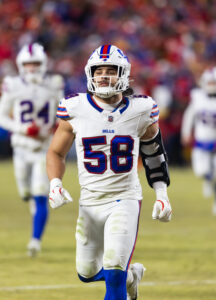 Despite his ill-timed absences, Benford secured what is now an upper-middle-class CB extension. Buffalo’s Benford deal came after both Jaycee Horn and Derek Stingley Jr. raised the market’s ceiling, but the team still has its top cover man tied to the 19th-most lucrative CB contract. Benford, 25 in September, likely would have done better by waiting until free agency (or a franchise tag). But the Bills, continuing their offseason theme, convinced him to re-up early.
Despite his ill-timed absences, Benford secured what is now an upper-middle-class CB extension. Buffalo’s Benford deal came after both Jaycee Horn and Derek Stingley Jr. raised the market’s ceiling, but the team still has its top cover man tied to the 19th-most lucrative CB contract. Benford, 25 in September, likely would have done better by waiting until free agency (or a franchise tag). But the Bills, continuing their offseason theme, convinced him to re-up early.
Part of McDermott’s first draft (one that took place shortly before Beane’s GM hire), Milano delivered strong work on his rookie deal and second contract. Since Buffalo redid the All-Pro’s contract in 2023, injuries have thrown his career off course. Milano, 31, missed 12 games due to injury in each of the past two seasons. That has limited Buffalo’s defense, and keyed a reduction.
Rather than taking his chances on the market coming off these injury-marred years ahead of his age-31 season, Milano will attempt to rebound with the team that drafted him. As Bernard, Benford, Cook, Rousseau and Shakir became the offseason focus around Allen, one of the initial McDermott-era investments is now paid as a moderately priced starting linebacker.
Free agency additions:
- Josh Palmer, WR. Three years, $30MM ($15MM guaranteed)
- Michael Hoecht, DE. Three years, $21MM ($12.43MM guaranteed)
- Joey Bosa, DE. One year, $12.61MM ($12MM guaranteed)
- Larry Ogunjobi, DT. One year, $6.7MM ($5.43MM guaranteed)
- Elijah Moore, WR. One year, $2.5MM ($2.5MM guaranteed)
- Tre’Davious White, CB. One year, $3MM ($2.2MM guaranteed)
- Dane Jackson, CB. One year, $ 1.34MM ($568K guaranteed)
- Darrick Forrest, S. One year, $1.34MM ($168K guaranteed)
- Darrynton Evans, RB. One year, $1.21MM ($15K guaranteed)
- Laviska Shenault, WR. One year, $1.21MM ($15K guaranteed)
- Shaq Thompson, LB. One year, $1.26MM
- Kendrick Green, OL. One year, $1.2MM
- Tre Herndon, DB. One year, $1.17MM
- Deon Cain, WR. One year, $960K
- Brad Robbins, P. One year, $960K
- Dan Feeney, G. Signed 8/4
 More undercard (to the extension cycle’s main event) in this Bills offseason, free agency still brought some important additions. The three most significant came from Los Angeles.
More undercard (to the extension cycle’s main event) in this Bills offseason, free agency still brought some important additions. The three most significant came from Los Angeles.
As they did with Von Miller in 2022, the Bills swooped in as a stealth contender to win an edge rusher sweepstakes. Joey Bosa was listed as close to reuniting with younger brother Nick in San Francisco, while the Miami native was also on the Dolphins’ radar. No Bills connections emerged until an agreement became known.
Bosa, 30, treks east as an injury-prone but productive pass rusher. The Bills will need to account for the health issues associated with this marquee free agent — a player the Chargers dropped after giving him a 2024 pay cut — and a calf issue already kept Bosa out for a stretch this offseason. When available, however, Bosa will be an upgrade.
It would seem Bosa will need to switch to a situational role earlier than most four-time Pro Bowlers do, because he has missed 40 regular-season games in nine years. He has already been on this track, having not eclipsed the 55% snap barrier on defense since 2021 — his most recent non-alternate Pro Bowl season. Bosa has four double-digit sack seasons on his resume — all from 2016-21. He missed much of the ’22 season after groin surgery and was down for eight 2023 games with foot trouble. Last season, Bosa posted modest numbers — five sacks, 13 QB hits, two forced fumbles — but generated a decent FA market.
Read more
 The Bills, who were among the teams mentioned in the brief Myles Garrett sweepstakes, may be fooling themselves hoping for extended Bosa work. But they struggled to pressure Mahomes in the AFC championship game and have seen their defense fold in previous playoff brackets. Bosa will join Hoecht, Rousseau and A.J. Epenesa on the edge, with some recent draftees also factoring in. Bosa in a closer-type role could make a difference, but it should be expected he will miss time at points.
The Bills, who were among the teams mentioned in the brief Myles Garrett sweepstakes, may be fooling themselves hoping for extended Bosa work. But they struggled to pressure Mahomes in the AFC championship game and have seen their defense fold in previous playoff brackets. Bosa will join Hoecht, Rousseau and A.J. Epenesa on the edge, with some recent draftees also factoring in. Bosa in a closer-type role could make a difference, but it should be expected he will miss time at points.
It would be helpful to the Bills if Bosa were available early, because Hoecht is set to serve a six-game PED suspension. Unlike Ogunjobi — whose six-game PED ban threatens his roster spot — Hoecht received a multiyear contract and a two-year guarantee. Buffalo had known about Hoecht’s upcoming ban (but not Ogunjobi’s), and the FA deal points to a belief the four-year Rams edge rusher can be a Rousseau wingman for at least two seasons.
Never missing a game with the Rams, Hoecht offers a decent production baseline as a supplementary rusher. He compiled six sacks and seven tackles for loss in 2023, and even after the Rams reduced his snap rate from 2023 to ’24 (85% to 57%) — leading to a mere three sacks and six QB hits — the Bills still shelled out decent cash. Hoecht, Bosa and Epenesa figure to rotate alongside Rousseau, who should lead the Bills in D-end snaps by a healthy margin. The team will hope this quartet can provide better pressure when it matters most.
 On a market full of 30-something wide receivers, Palmer stood out. Going into his age-26 season, the former Chargers third-rounder commanded a $15MM guarantee. Another $3MM will come Palmer’s way if he is on the Bills’ roster by Day 5 of the 2026 league year. That is a pretty good bet.
On a market full of 30-something wide receivers, Palmer stood out. Going into his age-26 season, the former Chargers third-rounder commanded a $15MM guarantee. Another $3MM will come Palmer’s way if he is on the Bills’ roster by Day 5 of the 2026 league year. That is a pretty good bet.
Essentially, Buffalo is hoping Palmer can provide what a 30-year-old Amari Cooper could not. Like most of the Bills’ extensions, this signing is a bet on Palmer outdoing his rookie-contract production. Marquise Brown was also likely on Buffalo’s radar, but he re-signed with Kansas City before free agency.
Nominally the Bolts’ No. 3 wideout for much of his L.A. tenure, the Toronto native filled in frequently during Mike Williams and Keenan Allen‘s injured stretches. Palmer played both outside and in the slot, spending more time near the boundary — which should continue on a team with Shakir, Elijah Moore and Curtis Samuel — and played well in spurts.
Sneaking into PFR’s top 50 free agent list (at No. 49), Palmer totaled a career-high 769 yards in 2022 and averaged a career-best 58.1 yards per game in 2023 (no Bills target bettered the latter number last season). Establishing an early rapport with Josh Allen, Palmer could be an X-factor as the Bills attempt to lean on Shakir and develop Keon Coleman on the other side.
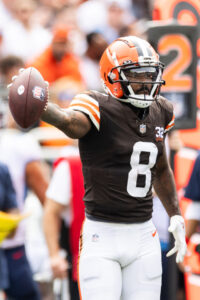 Beane took exception during a radio interview about his receiving corps, and Moore came over shortly after that exchange. The Bills’ draft board not aligning with their WR prospect values led Moore to Buffalo. While the group may not have a true No. 1 wideout, it oozes depth. Mostly a slot player, Moore averaged more than 12 yards per catch in both Jets seasons — mostly with Zach Wilson targeting him — and ran into more bad QB luck in Cleveland. Even as Deshaun Watson faceplanted, Moore combined for 1,178 yards last season.
Beane took exception during a radio interview about his receiving corps, and Moore came over shortly after that exchange. The Bills’ draft board not aligning with their WR prospect values led Moore to Buffalo. While the group may not have a true No. 1 wideout, it oozes depth. Mostly a slot player, Moore averaged more than 12 yards per catch in both Jets seasons — mostly with Zach Wilson targeting him — and ran into more bad QB luck in Cleveland. Even as Deshaun Watson faceplanted, Moore combined for 1,178 yards last season.
At 25, the former A.J. Brown/D.K. Metcalf Ole Miss teammate presents intriguing upside. It is worth wondering how much room the Bills have for his talents, though, given Shakir and Samuel’s presences. The latter remains rostered due to a fully guaranteed 2025 salary ($6.91MM) — and perhaps because Beane helped draft him in Carolina. Samuel totaled just 253 yards last season and, even with an $12.1MM dead money sum (which would be spread over two years), is not a roster lock following the Moore signing.
Somehow still flowing in Year 9 of the McDermott-Beane era, the Carolina-to-Buffalo pipeline brought Thompson as well. The former Super Bowl 50 starter will attempt to mix in behind Bills regulars Terrel Bernard and Matt Milano. Thompson, 31, joins Dorian Williams and Joe Andreessen as Buffalo backup LBs.
 White’s November 2021 ACL tear began the run of Bills corners not being at full strength in key playoff matchups, and White could not shake off injury issues until his March 2024 Buffalo release. After an unimpressive stint as a Rams starter, White wound up a Ravens backup. The former All-Pro is now nearly two years removed from his October 2023 Achilles tear, and the Bills have him readying to start while Maxwell Hairston‘s LCL injury heals.
White’s November 2021 ACL tear began the run of Bills corners not being at full strength in key playoff matchups, and White could not shake off injury issues until his March 2024 Buffalo release. After an unimpressive stint as a Rams starter, White wound up a Ravens backup. The former All-Pro is now nearly two years removed from his October 2023 Achilles tear, and the Bills have him readying to start while Maxwell Hairston‘s LCL injury heals.
CB2 could remain an issue for the Bills, given White’s recent form. The team also circled back to Jackson — a primary White 2022 fill-in who spent last season in Carolina — as a midlevel option in case White cannot recapture starter-level form. The Bills discussed a trade for Jaire Alexander before bringing back White but were not closely connected to the former All-Pro — who wound up a Raven — post-draft. Hairston’s arrival likely affected the Bills’ Alexander interest.
Re-signings:
- Ty Johnson, RB. Two years, $5MM ($2.49MM guaranteed)
- Reid Ferguson, LS. Four years, $6.5MM ($2.37MM guaranteed)
- Damar Hamlin, S. One year, $2MM ($2MM guaranteed)
- Reggie Gilliam, FB. One year, $2MM ($50K guaranteed)
- Ryan Van Demark, T. One year, $1.03MM ($9K guaranteed)
 Hamlin being a viable free agent at all represents a remarkable achievement considering the circumstances. The Bills retained the inspirational defender on a low-cost contract, pointing to a depth role after he spent 2024 as a starter. Hamlin, 27, started all 14 games he played last season. PFF did not grade the former fifth-rounder’s contract-year work well, slotting him 85th at safety. But Hamlin has experience as a backup, spending most of the 2023 season in that role after his miraculous recovery.
Hamlin being a viable free agent at all represents a remarkable achievement considering the circumstances. The Bills retained the inspirational defender on a low-cost contract, pointing to a depth role after he spent 2024 as a starter. Hamlin, 27, started all 14 games he played last season. PFF did not grade the former fifth-rounder’s contract-year work well, slotting him 85th at safety. But Hamlin has experience as a backup, spending most of the 2023 season in that role after his miraculous recovery.
Revealing on Hard Knocks a full Bo Jackson tweet is tattooed on his back, Hamlin also spent his rookie season and the early part of 2022 — before a Micah Hyde neck injury — as a reserve. Cole Bishop, who saw his workload increase due to starter injuries last season, is poised to supplant Hamlin as a starter. The Bills used a second-round pick on Bishop, pointing to an early-career starter role. Still, Hamlin — who said he wants to finish his career in Buffalo — could become one of the most popular players in franchise history.
Notable losses:
- Jake Camarda, P (waived)
- Amari Cooper, WR
- Rasul Douglas, CB
- Tommy Doyle, T (retired)
- Mack Hollins, WR
- Micah Hyde, S (retired)
- Quinton Jefferson, DT
- Austin Johnson, DT
- Sam Martin, P (released)
- Von Miller, DE (released)
- Quintin Morris, TE (nontendered)
- Jordan Phillips, DT
- Dawuane Smoot, DE
- Baylon Spector, LB (waived via injury settlement)
 For a few months in Miller’s first Bills season, he looked to be adding a significant chapter to one of this century’s best defender resumes. A Thanksgiving 2022 ACL tear — Miller’s second as a pro — changed the Bills’ pass-rushing outlook. Miller looked a shell of himself upon returning in 2023, registering no sacks, and had shifted into situational-rushing form last season. While the impending cap casualty bounced back with six sacks (on just eight QB hits) in 13 games, the Bills could not justify carrying his nonguaranteed salary.
For a few months in Miller’s first Bills season, he looked to be adding a significant chapter to one of this century’s best defender resumes. A Thanksgiving 2022 ACL tear — Miller’s second as a pro — changed the Bills’ pass-rushing outlook. Miller looked a shell of himself upon returning in 2023, registering no sacks, and had shifted into situational-rushing form last season. While the impending cap casualty bounced back with six sacks (on just eight QB hits) in 13 games, the Bills could not justify carrying his nonguaranteed salary.
Due $17.5MM on his six-year, $120MM deal, Miller became a predictable cut. Miller’s Buffalo tenure did boost him to 16th in career sacks, but the decorated pass rusher’s knee setback effectively ended his prime. The Commanders picked up Miller — on a one-year, $6.1MM accord — this summer. Not released with a post-June 1 designation, Miller counts $15.42MM in 2025 dead money on Buffalo’s payroll.
I wondered in March if Douglas would become the glut of third-contract-seeking cornerbacks’ line of demarcation in free agency. That has been proven true to a greater-than-anticipated degree, as the 1 1/2-year Bills starter remains unattached. This came after the other members of that late-20s CB contingent — D.J. Reed, Byron Murphy, Charvarius Ward, Carlton Davis — all found homes on Day 1 of free agency on deals averaging at least $16MM per year. It is clear Douglas, 30 this month, was dissatisfied with his market.
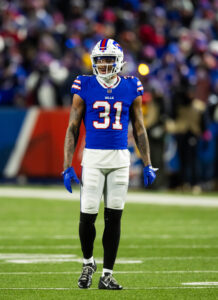 The early-career nomad-turned-starter gave the Bills excellent coverage work after a 2023 deadline deal, but his metrics regressed last season. Rather than reinvest in an eight-year veteran, the Bills drafted Hairston in Round 1 and re-signed Tre’Davious White as insurance. This is a riskier plan compared to the two-year Benford-Douglas partnership on the outside.
The early-career nomad-turned-starter gave the Bills excellent coverage work after a 2023 deadline deal, but his metrics regressed last season. Rather than reinvest in an eight-year veteran, the Bills drafted Hairston in Round 1 and re-signed Tre’Davious White as insurance. This is a riskier plan compared to the two-year Benford-Douglas partnership on the outside.
Cooper, 31, joins Douglas in being unsigned after a Buffalo post-trade stop. Acquired for a third-round pick weeks before last year’s deadline, Cooper never took off in the way the Bills hoped. He totaled just 297 receiving yards in nine Bills games. Even though Cooper collected $100MM on his second contract, the seven-time 1,000-yard receiver agreeing to a five-year Cowboys deal in 2020 proved a mistake value-wise.
Cooper hit free agency again at a bad time, given his uninspiring 2024 showing. Had he agreed to a three- or four-year free agency accord, he would have commanded a much better market as a 2023 or ’24 free agent.
Reuniting with Josh McDaniels (three years after their Raiders partnership), Hollins fetched a two-year, 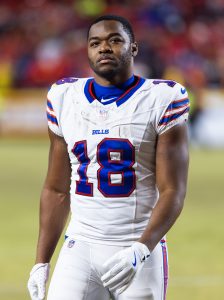 $8.4MM Patriots deal early in free agency. Coming through as Allen’s most reliable receiver in the latest Bills-Chiefs duel, Hollins’ role limited Cooper’s usage. Hollins logged a surprising 66% snap rate with the Bills, limiting Cooper to 46% — a sharp decline from his usage elsewhere.
$8.4MM Patriots deal early in free agency. Coming through as Allen’s most reliable receiver in the latest Bills-Chiefs duel, Hollins’ role limited Cooper’s usage. Hollins logged a surprising 66% snap rate with the Bills, limiting Cooper to 46% — a sharp decline from his usage elsewhere.
Hyde and Phillips made what look like final stopovers in Buffalo, with neither being asked to contribute much. Phillips logged 109 snaps upon rejoining the Bills, after short stops in New York and Dallas, while Hyde — who had re-signed with the Bills on a practice squad deal late in the season — did not make any appearances.
Hyde’s exit — unless the Bills call on Jordan Poyer, as the longtime starter would prefer — closes the book on one of the NFL’s best 21st-century safety tandems. The two played together for seven years, combining to make 202 starts as instrumental pieces during the Bills’ late-2010s turnaround.
Trades:
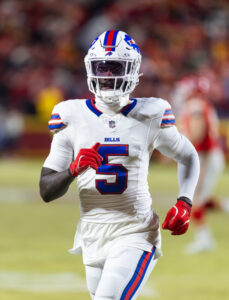 Adding spice to the Buffalo-Kansas City rivalry, the Bills were believed to be eyeing Trent McDuffie in the 2022 first round. After the Chiefs traded up (via the Patriots), the Bills chose Elam. A stark disparity emerged between the first-round corners chosen two picks apart. Elam could not hold off Benford despite the latter’s low-end prospect profile and, following a midseason rookie-year stretch, never earned an extended starter look.
Adding spice to the Buffalo-Kansas City rivalry, the Bills were believed to be eyeing Trent McDuffie in the 2022 first round. After the Chiefs traded up (via the Patriots), the Bills chose Elam. A stark disparity emerged between the first-round corners chosen two picks apart. Elam could not hold off Benford despite the latter’s low-end prospect profile and, following a midseason rookie-year stretch, never earned an extended starter look.
Benford’s early-game exit in Kansas City, as Tony Romo foreshadowed, provided a significant advantage for the Chiefs. Elam gave Mahomes a much less imposing matchup compared to the sixth-round success story, and the Bills cut bait barely a month later. The Cowboys predictably declined Elam’s fifth-year option, but with Trevon Diggs and rookie Shavon Revel uncertain for Week 1, Elam could be poised to handle a starting role in Dallas opposite DaRon Bland.
Draft:
- Round 1, No. 30: Maxwell Hairston (CB, Kentucky) (signed)
- Round 2, No. 41 (from Bears): T.J. Sanders (DT, South Carolina) (signed)
- Round 3, No. 72 (from Bears): Landon Jackson (DE, Arkansas) (signed)
- Round 4, No. 109 (from Bears through Bills and Bears): Deone Walker (DT, Kentucky) (signed)
- Round 5, No. 170 (from Cowboys)*: Jordan Hancock (CB, Ohio State) (signed)
- Round 5, No. 173*: Jackson Hawes (TE, Georgia Tech) (signed)
- Round 6, No. 177 (from Giants): Dorian Strong (CB, Virginia Tech) (signed)
- Round 6, No. 206: Chase Lundt (T, UConn) (signed)
- Round 7, 240 (from Vikings through Browns and Bears): Kaden Prather (WR, Maryland) (signed)
 Steady Bills cornerback connections preceded the team choosing Hairston as an Elam makeup call. Blazing to the fastest 40-yard dash at this year’s Combine (4.28 seconds), Hairston will be asked — once he recovers from his LCL injury and ramps up — to complement Christian Benford. Hairston’s rookie deal will overlap with Benford’s guarantee years, giving a Bills team carrying a eight-figure-per-year slot corner (Taron Johnson) on its books.
Steady Bills cornerback connections preceded the team choosing Hairston as an Elam makeup call. Blazing to the fastest 40-yard dash at this year’s Combine (4.28 seconds), Hairston will be asked — once he recovers from his LCL injury and ramps up — to complement Christian Benford. Hairston’s rookie deal will overlap with Benford’s guarantee years, giving a Bills team carrying a eight-figure-per-year slot corner (Taron Johnson) on its books.
The Bills were believed to be in on Ole Miss’ Trey Amos, but he fell into the late second round. Instead, our Ely Allen’s mock draft nailed the Hairston-Buffalo match. A Kentucky-record three pick-sixes placed Hairston on the map in 2023, but he followed up the five-INT campaign with only one pick and five passes defensed in an abbreviated 2024. (Though, that singular pick was also returned for a score.) After White and Elam, Hairston is Buffalo’s third first-round CB pick under McDermott.
A shoulder injury led to five 2024 absences, and the Bills have not ruled out a season-opening IR stint regarding the LCL sprain. While the team dodged a bullet with the speedster avoiding an ACL tear, it could be a while before he is ready for starter work. A future Hairston suspension — due to a civil suit alleging sexual assault — may also be on the radar. Hairston denied the allegation, and Beane insisted the Bills did extensive background work on the promising CB.
 The Bills traded up 15 spots for Sanders, illustrating the confidence in the South Carolina product. Sanders has impressed already, putting Larry Ogunjobi on the roster bubble. Packages featuring Sanders and Ed Oliver rushing together would stand to provide a boost on passing downs. Sanders combined to tally 8.5 sacks and 17 TFLs during his final two Gamecocks seasons.
The Bills traded up 15 spots for Sanders, illustrating the confidence in the South Carolina product. Sanders has impressed already, putting Larry Ogunjobi on the roster bubble. Packages featuring Sanders and Ed Oliver rushing together would stand to provide a boost on passing downs. Sanders combined to tally 8.5 sacks and 17 TFLs during his final two Gamecocks seasons.
If nothing else, the interior rusher gives the Bills important depth behind Oliver — after the team trotted out mostly older veterans alongside its DT centerpiece last season. Walker also became Buffalo-bound after a trade-up move, highlighting the team’s commitment to this position.
The Bills’ view of Sanders contrasted from both the Dane Brugler and Daniel Jeremiah big boards, which respectively had the SEC D-tackle ranked 70th and 98th in this year’s class. Conversely, NFL.com and The Athletic big boards ranked Jackson 43rd and 47th.
Jackson combined for 13 sacks and 24 TFLs during his final two Arkansas seasons. A big Senior Bowl showing did not end up vaulting Jackson into Round 2, but the power-based rusher profiles as an interesting value play to potentially serve as a long-term Rousseau complement — with Bosa on a one-year deal and Epenesa in a contract year.
Other:
The Bills will need to have a post-Brady plan in the near future; another strong offensive season — which seems likely — probably catapults the 36-year-old staffer into a top job. Brady and his Buffalo OC predecessors have not needed to have an Allen backup plan since the durable QB’s rookie season, but the Bills need to at least establish a depth chart.
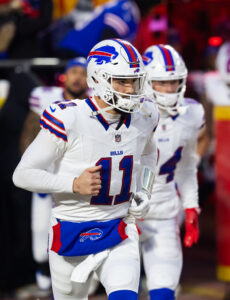 The loser of the Trubisky-White battle could either be retained on a practice squad deal and stashed as the emergency QB3 or kept as a third active-roster passer — a less likely proposition due to Allen’s health run. Trubisky held the job last year, but White now has a full offseason in Brady’s offense — after the ex-Jets starter and Dolphins backup joined the team just before last season. Entering his age-31 season, Trubisky still appears the favorite. It will be interesting to see if the Bills chance cutting White, as another gig could await over another year on Buffalo’s P-squad.
The loser of the Trubisky-White battle could either be retained on a practice squad deal and stashed as the emergency QB3 or kept as a third active-roster passer — a less likely proposition due to Allen’s health run. Trubisky held the job last year, but White now has a full offseason in Brady’s offense — after the ex-Jets starter and Dolphins backup joined the team just before last season. Entering his age-31 season, Trubisky still appears the favorite. It will be interesting to see if the Bills chance cutting White, as another gig could await over another year on Buffalo’s P-squad.
Considering all the extension work the Bills did this offseason, some performers were bound to be left out. While time remains for McGovern and/or Edwards to re-sign before hitting free agency, the Bills have another season to evaluate right guard O’Cyrus Torrence for a possible 2026 extension.
This becomes a pivotal year for Edwards, who has not been paid commensurate with his starting experience. The former Super Bowl LVI starter saw a 2022 concussion sidetrack his 2023 market. After playing out a $1.77MM Bills deal, Edwards received a raise (two years, $6MM) to move into the starting lineup after Mitch Morse‘s exit slid McGovern to center. Edwards, 28, will probably be the more affordable option compared to McGovern as far as an extension goes.
Top 10 cap charges for 2025:
- Josh Allen, QB: $36.34MM
- Dion Dawkins, LT: $19.98MM
- Dawson Knox, TE: $14.57MM
- Matt Milano, LB: $12.19MM
- Ed Oliver, DT: $11.24MM
- DaQuan Jones, DT: $9.41MM
- Connor McGovern, C: $9.39MM
- Curtis Samuel, WR: $9.07MM
- Spencer Brown, RT: $8.18MM
- Taron Johnson, S: $8.01MM
While bad injury luck (and a controversial ball spot that helped usher long-overdue technology into measurement proceedings) has undoubtedly played a key role in the Bills’ playoff struggles, they continue to come up short in the biggest spots. The Bills have not done well to capitalize — in a loaded AFC, that is — on their Hall of Fame-level QB talent in the way a sturdy Chiefs infrastructure has with theirs.
After last year’s retooling project nearly brought a Super Bowl berth, the Bills join the Ravens in being unable to supplant a Chiefs dynasty atop the conference. Will the recently extended players finally change the guard in the AFC and produce the Bills’ first Super Bowl berth in 32 years? Anything less — barring major injury trouble — will probably be deemed another letdown, representing how much the measuring stick has changed in Buffalo as the McDermott-Beane duo nears a second decade in charge.
By Sam Robinson |
at August 15, 2025 10:45 pm
For a team that has made two playoff appearances over the past three years and has not lost 10 games since 2019, vibes sure don’t seem great in Miami. Mike McDaniel has moved closer to the hot seat, despite coaxing dramatic Tua Tagovailoa improvement and leading the Dolphins to back-to-back playoff berths for the first time since Dave Wannstedt‘s tenure more than 20 years ago. GM Chris Grier also has not enjoyed a banner year, having seen his Tyreek Hill rework and Jalen Ramsey extension not prove fruitful.
The Dolphins have battled cap trouble in multiple offseasons, and this one brought a historic dead money charge thanks to the Ramsey trade. McDaniel may need a third playoff berth in four seasons to keep his job — as odd as that sounds for a franchise that booked two playoff appearances from 2002-21 — pointing to Tagovailoa’s health potentially determining the HC’s long-term fate. Regardless of Tua’s status, the Dolphins have some questions to answer after some notable offseason roster subtractions and storylines.
Trades:
Reminding of the 2019 Odell Beckham Jr. trade that belatedly included an Olivier Vernon–Kevin Zeitler swap, the Dolphins and Steelers folded the Smith transaction into the Ramsey-Fitzpatrick blockbuster. Almost six years after he forced his way out of Jacksonville, Ramsey burned more bridges in Florida. After it was over, the former All-Pro cornerback set a non-quarterback dead money record, tagging the Dolphins with $35.86MM — spread between 2025 and ’26.
 The latest Ramsey chapter of discontent emerged in April, when the Dolphins and the aging defender agreed to pursue a trade. This came months after Grier had signed off on a market-topping extension, representing the second time Ramsey had become the top CB earner.
The latest Ramsey chapter of discontent emerged in April, when the Dolphins and the aging defender agreed to pursue a trade. This came months after Grier had signed off on a market-topping extension, representing the second time Ramsey had become the top CB earner.
Extended soon after Patrick Surtain reset the market in September, Ramsey played reasonably well in 2024. Pro Football Focus ranked him 11th among corners, but considering he missed nearly half the 2023 season, the nine-year veteran did not justify Grier’s decision to both rework his Rams deal upon arrival and then sign off on a new one 18 months later.
Grier has become the rare GM to cave repeatedly to disgruntled players. It was not even known if Ramsey was even disgruntled last year, but after Grier reworked the Xavien Howard and Tyreek Hill deals to throw significant guarantees their way, he paid Ramsey ahead of an age-30 season. Ramsey is tied to a three-year, $72.3MM extension that runs through 2028. This reminded of the Howard and Hill adjustments since Ramsey also had multiple seasons (two) left on a contract. The Dolphins doing that extension and then trading him less than a year later proved quite costly.
Teams balked at taking on all of Ramsey’s guaranteed money for 2025, depressing the value of a player probably headed to the Hall of Fame. More significantly, Ramsey was believed to be at odds with McDaniel’s leadership style, potentially calling into question the atypical HC personality’s fit in the locker room. The draft-day report called the Ramsey-McDaniel relationship “irreparably broken,” and the former Super Bowl winner had harbored issues with the Dolphins’ (in his view) “willingness to accept mediocrity.” but the team needed — rather than see the Ramsey dead money hit the 2025 payroll exclusively — to drag this out until after June 1.
 While the buildup did not look great for the Dolphins, Grier crafted an interesting solution. The Dolphins agreed to pay $7MM of Ramsey’s 2025 compensation, sweetening the deal for the Steelers, who are paying nearly $20MM to the soon-to-be 31-year-old CB. This was a somewhat surprising salary split, but the Dolphins took on more money by reacquiring Fitzpatrick. That became the most fascinating component of that two-trade day, seeing as the Dolphins — in Grier’s first months as a GM with roster control — traded Fitzpatrick early in his second season.
While the buildup did not look great for the Dolphins, Grier crafted an interesting solution. The Dolphins agreed to pay $7MM of Ramsey’s 2025 compensation, sweetening the deal for the Steelers, who are paying nearly $20MM to the soon-to-be 31-year-old CB. This was a somewhat surprising salary split, but the Dolphins took on more money by reacquiring Fitzpatrick. That became the most fascinating component of that two-trade day, seeing as the Dolphins — in Grier’s first months as a GM with roster control — traded Fitzpatrick early in his second season.
A dispute between Fitzpatrick and the Dolphins led to his exit after just 18 games. The 2018 first-round pick (and his mother) objected to the Flores-led coaching staff using Fitzpatrick as a box player during the team’s 2019 training camp. This came after Miami primarily used Fitzpatrick at corner as a rookie.
While 2019 featured Grier at the controls, previous front office boss Mike Tannenbaum drafted Fitzpatrick. Grier traded him — days after giving the player’s camp permission to seek a trade — as the Dolphins continued a teardown that included swaps involving Ryan Tannehill and Laremy Tunsil. Six years later, Fitzpatrick joins a team that made strides in this rebuild but has not approached the ultimate goal.
Fitzpatrick, 28, should have more good football left than Ramsey. The three-time first-team All-Pro combined for 15 interceptions from 2019-22, excelling as a deep safety while helping to elevate the Steelers’ defense into a perennial top-10 unit. Over the past two years, the Steelers became underwhelmed by Fitzpatrick’s lack of splash plays; he has one INT since the start of the 2023 season. The 2023 slate, however, brought an increase in box snaps compared to his usual free safety role. Last season did not reverse Fitzpatrick’s downward playmaking trend, but he suited up for 17 games and will have a chance to play a lead role in a Dolphins team that lost Jevon Holland and Brandon Jones over the past two offseasons.
 As a Dolphins rookie in 2018, Fitzpatrick primarily played corner. He rotated between the boundary and the slot, playing more inside. That will not be his role this time around. Set to deploy Fitzpatrick at safety, the Dolphins also reworked his contract.
As a Dolphins rookie in 2018, Fitzpatrick primarily played corner. He rotated between the boundary and the slot, playing more inside. That will not be his role this time around. Set to deploy Fitzpatrick at safety, the Dolphins also reworked his contract.
Previously attached to a four-year, $72.98MM deal, the eighth-year vet is now on a two-year, $33.1MM accord that provided a new signing bonus and dropped his 2025 cap hit to $4.5MM. That provided a cash influx for a player who had played out the guarantees on his Steelers deal. Despite Grier trading him so early in his career, Fitzpatrick is now interested in a long-term Miami future.
The Dolphins showed interesting hesitation about paying Smith, whose Miami debut doubled as his best season. Smith smashed career-high marks with 88 receptions, 884 yards and eight TDs last year, helping a Dolphins team that saw Hill’s production nosedive and Jaylen Waddle regress as Tagovailoa missed time.
The Steelers came up as a Smith suitor in May, and while the veteran tight end expressed a desire to stay in Miami while the sides discussed an extension, the parties could not hammer out one. Roughly a month after the initial rumor, Jonnu and Arthur Smith — the former Titans OC and Falcons HC — reunited yet again.
This marks the second time an Arthur Smith team traded for Jonnu Smith, but this trade preceded an extension. Jonnu Smith had been tied to a two-year, $8.4MM deal — one agreed to after the Falcons made him a cap casualty soon after firing Arthur Smith. The Steelers gave Jonnu a one-year, $12MM extension, pushing his deal through 2026. The trade brought less than $3MM in Dolphins dead cap, but it leaves a significant question at tight end. With limited options in terms of proven receiving TEs by early July, the Dolphins threw a Hail Mary of sorts.
 Waller, 33 next month, retired last summer after rumors pointed to an exit for weeks. The former Raiders Pro Bowler burned the Giants, having sustained another hamstring injury (leading to a five-game absence) and retired after the 2024 draft. No word about a Waller comeback had surfaced, but after the Dolphins acquired his rights via the pick-swap trade, Waller let it be known he wanted to play in Miami or stay retired.
Waller, 33 next month, retired last summer after rumors pointed to an exit for weeks. The former Raiders Pro Bowler burned the Giants, having sustained another hamstring injury (leading to a five-game absence) and retired after the 2024 draft. No word about a Waller comeback had surfaced, but after the Dolphins acquired his rights via the pick-swap trade, Waller let it be known he wanted to play in Miami or stay retired.
The Dolphins stashed Waller on their active/PUP list for ramp-up purposes. Miami has him on a one-year, $2MM deal with no guarantees. While this profiles as a flier, the Dolphins’ TE depth chart is desperate for this Waller reemergence to commence in earnest. Miami did not draft a tight end and has none on the roster who have delivered a 210-yard season. Waller accumulated 552 in a disappointing Giants season and is among a select few with two 1,100-yard years on his resume.
The Dolphins will almost definitely not be getting prime Waller form, but something in the range of his Giants work would be a lifeline for a team desperate at this position. Waller missed eight Raiders games due to hamstring trouble in 2022, following a $17MM-per-year extension agreement, and some Las Vegas staffers expressed frustration about his slow recovery. Waller also missed six games in 2021. This is a buyer-beware situation, making the Dolphins’ visit with Noah Fant — who signed with the Bengals soon after — rather interesting.
Extensions and restructures:
Add Sieler to the list of Dolphins Grier has extended with more than one year left on a previous deal. Sieler did not hold in but let it be known he wanted a new deal after back-to-back 10-sack seasons. Because this extension is tacked onto a through-2026 pact, the veteran D-tackle is now signed through 2029.
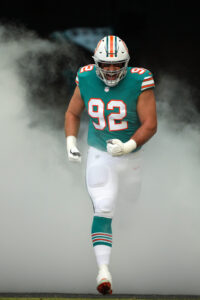 Originally a waiver claim (from the Ravens) in December 2019, Sieler arrived to close out Grier’s first year as the team’s front office boss. Sieler operated as more of a Christian Wilkins sidekick from 2020-22, and the Dolphins did well to extend him at what turned out to be a below-market rate. Paying Sieler before being unable to come to terms with Wilkins, Miami observed its waiver-claim find combine for 24 TFLs over the past two seasons.
Originally a waiver claim (from the Ravens) in December 2019, Sieler arrived to close out Grier’s first year as the team’s front office boss. Sieler operated as more of a Christian Wilkins sidekick from 2020-22, and the Dolphins did well to extend him at what turned out to be a below-market rate. Paying Sieler before being unable to come to terms with Wilkins, Miami observed its waiver-claim find combine for 24 TFLs over the past two seasons.
Grier’s latest early raise bumps Sieler from barely $10MM per year (31st among interior D-linemen) to over $22MM AAV. Sieler, 30 next month, is now being paid more than Dexter Lawrence, Leonard Williams and Daron Payne. This is quite the level jump for a former seventh-round pick, and the Dolphins will count on him once again ahead of an age-30 season. Though, he should have more help thanks to some returning edge rushers.
Chubb was delivering on the November 2022 trade/extension sequence. He posted 11 sacks — his most since a rookie season (12) opposite Von Miller — and led the NFL with six forced fumbles in 2023. Chubb, though, suffered an ACL tear late in a blowout loss to the Ravens in Week 17 of that season. He then missed all of last season, joining OLB mate Jaelan Phillips in seeing injury issues reshape his Miami trajectory. As a result of the missed season, an accepted pay-cut request transpired.
 The Dolphins included incentives in Chubb’s rework, and since the former top-five pick missed all of last season, the escalators will be considered not likely to be earned — thus giving Miami 2025 cap relief. Chubb’s cap hit is down to $12.33MM. The two-time Pro Bowler is on track to return for the Dolphins, who have EDGE questions but more depth at the position compared to their Chubb- and (largely) Phillips-less 2024. Phillips, who suffered an ACL tear early last season, also avoided the active/PUP list ahead of training camp.
The Dolphins included incentives in Chubb’s rework, and since the former top-five pick missed all of last season, the escalators will be considered not likely to be earned — thus giving Miami 2025 cap relief. Chubb’s cap hit is down to $12.33MM. The two-time Pro Bowler is on track to return for the Dolphins, who have EDGE questions but more depth at the position compared to their Chubb- and (largely) Phillips-less 2024. Phillips, who suffered an ACL tear early last season, also avoided the active/PUP list ahead of training camp.
The veteran duo will accompany 2024 first-rounder Chop Robinson, giving Miami an intriguing pass-rushing boost — provided Chubb and Phillips stay on the field. Miami will be expected to either give Chubb another pay cut in 2026, when his cap hit balloons to $31.2MM, or release him. This will be a critical season for the 29-year-old pass rusher’s value. Phillips is tied to a $13.25MM fifth-year option, cashing in between his Achilles and ACL tears. This will be a pivotal year for him as well.
Free agency additions:
- James Daniels, G. Three years, $24MM ($7.26MM guaranteed)
- Zach Wilson, QB. One year, $6MM ($6MM guaranteed)
- Nick Westbrook-Ikhine, WR. Two years, $5.99MM ($3.2MM guaranteed)
- Larry Borom, T. One year, $2.5MM ($2.5MM guaranteed)
- Ifeatu Melifonwu, S. One year, $3MM ($2.45MM guaranteed)
- Ashtyn Davis, S. One year, $2.5MM ($1.23MM guaranteed)
- K.J. Britt, LB. One year, $1.34MM ($1.2MM guaranteed)
- Willie Gay, LB. One year, $1.34MM ($1.2MM guaranteed)
- Alexander Mattison, RB. One year, $1.34MM ($1.2MM guaranteed)
- Joe Cardona, LS. One year, $1.42MM ($484K guaranteed)
- Mike Hilton, CB. One year, $1.42MM ($168K guaranteed)
- Ryan Stonehouse, P. One year, $1.73MM ($75K guaranteed)
- Pharaoh Brown, TE. One year, $1.36MM ($20K guaranteed)
- Artie Burns, CB. One year, $1.36MM
- Germain Ifedi, T. One year, $1.26MM
- Daniel Brunskill, G. One year, $1.17MM
- Matt Dickerson, DL. One year, $1.17MM
- Kendall Sheffield, CB. One year, $1.17MM
- Jack Jones, CB. One year, $1.1MM
- Chris Myarick, TE. One year, $1.1MM
- Ben Stille, DL. One year, $1.1MM
 After Isaiah Wynn joined Bradley Chubb in seeing a 2023 injury cost him the full 2024 season, the Dolphins retooled with a player who missed most of that campaign. Daniels would have been a less affordable option had he not suffered an Achilles tear in Week 4. While this is technically a three-year deal, it is more of a “prove it” pact due to its structure.
After Isaiah Wynn joined Bradley Chubb in seeing a 2023 injury cost him the full 2024 season, the Dolphins retooled with a player who missed most of that campaign. Daniels would have been a less affordable option had he not suffered an Achilles tear in Week 4. While this is technically a three-year deal, it is more of a “prove it” pact due to its structure.
Even with three void years included in this accord, the Dolphins can cut Daniels (due a $3.48MM guarantee on Day 3 of the 2026 league year) for just a $4.8MM dead money charge in 2026. Despite being a seven-year veteran, Daniels had age on his side. The former second-round pick heads into an age-28 season. If he can recapture his pre-injury form, the Dolphins will gain considerable value.
Daniels finished ninth in pass block win rate in his 2022 Steelers debut and was second only to Quenton Nelson in run block win rate before going down last season. PFF ranked Daniels 33rd among guard regulars in 2023. He will be an upgrade from Robert Jones; the Dolphins hope the three-year Steelers starter can return to a form that saw him miss only two games from 2021-23.
Wilson nearly fetched as much guaranteed as Trey Lance and Mac Jones combined, representing a lingering belief in the former No. 2 overall pick’s arm talent. Even as Wilson did not threaten Jarrett Stidham for Denver’s backup job last season, he has made 33 career starts. Highlighting Wilson’s experience may not be the best way to go here, considering the Jets benched him three times — at one point demoting him to the third-string level — during an erratic tenure. Despite being supported by a top-five defense in 2022 and ’23, Wilson went 12-21 as a starter in his three-year New York run. The Jets needed to take on rookie-contract money in order to fetch a Day 3 draft pick from the Broncos last year.
 The Jets saw a failure to add a veteran behind Aaron Rodgers prove costly in 2023, as Wilson’s reset program returned to center stage. Tua Tagovailoa‘s unreliability makes this situation resemble the Jets’ 2023 blueprint, but Wilson having shown more evidence in incapability that year makes this Miami setup perhaps even shakier.
The Jets saw a failure to add a veteran behind Aaron Rodgers prove costly in 2023, as Wilson’s reset program returned to center stage. Tua Tagovailoa‘s unreliability makes this situation resemble the Jets’ 2023 blueprint, but Wilson having shown more evidence in incapability that year makes this Miami setup perhaps even shakier.
If Tua goes down again, the Zach Wilson Experience will hit South Beach. That is a frightening proposition. But the Dolphins pounced on Wilson on Day 1 of the legal tampering period, rather than waiting out the veteran QB2 market. This points to McDaniel belief he can coax better play from the one-time top prospect, though the Dolphins were believed to be interested in Andy Dalton before he re-signed with the Panthers. Wilson, 26, is definitely another way to go.
A touchdown machine in 2024, Westbrook-Ikhine will almost definitely be an upgrade on last year’s Odell Beckham Jr. version. The tertiary Titans target caught nine TD passes on just 32 receptions. While that will be difficult to sustain, Westbrook-Ikhine (10 combined TDs from 2021-23) played a regular Tennessee role (between 370-480 yards each year from 2021-24) and is qualified to operate as Miami’s WR3 alongside Hill and Waddle. This is a much more affordable option than Cedrick Wilson Jr., who flopped on a three-year, $24MM deal. NWI’s consistency should matter for a Dolphins team that may need more from this spot after trading Jonnu Smith.
Read more
 The Dolphins’ cornerback group looked thin before the Burns and Kader Kohou ACL tears in camp. Sheffield (zero starts since 2020) and former UDFA Storm Duck started the team’s preseason opener. Jones opened that game with Miami’s second-stringers. While the ex-Patriots and Raiders starter has impressed in spurts — most notably via his two-pick-six Raiders entrance during Antonio Pierce‘s interim HC period — but has been waived twice since 2023. The Dolphins have seen next to nothing from 2023 second-rounder Cam Smith (153 defensive snaps in two seasons).
The Dolphins’ cornerback group looked thin before the Burns and Kader Kohou ACL tears in camp. Sheffield (zero starts since 2020) and former UDFA Storm Duck started the team’s preseason opener. Jones opened that game with Miami’s second-stringers. While the ex-Patriots and Raiders starter has impressed in spurts — most notably via his two-pick-six Raiders entrance during Antonio Pierce‘s interim HC period — but has been waived twice since 2023. The Dolphins have seen next to nothing from 2023 second-rounder Cam Smith (153 defensive snaps in two seasons).
The Dolphins discussed deals with Asante Samuel Jr. and looked into James Bradberry this offseason. Neither has signed as a free agent. Ditto Rasul Douglas, who drew the most interest from Miami. (Though Samuel had not ruled out the Dolphins, his ex-CB father was rather critical of Grier and McDaniel.)
The Dolphins were in on Douglas at multiple offseason junctures, but their offer did not sway the two-year Bills starter. The sides were not too far apart, as of July, and Douglas remaining available this deep into camp points to the CB waiting for an injury or disappointing performances to create a need. Otherwise, the 29-year-old cover man will need to accept his market did not take off like the third-contract-seeking CBs PFR’s top 50 had rated higher.
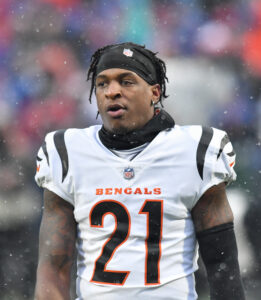 The Dolphins have looked into trades here, keeping such a move on the radar when the post-preseason trade window opens fully. A waiver claim should be considered likely at this rate. They also were connected to Jaire Alexander before his Ravens deal. As for Hilton, he had been on Miami’s radar for a bit. The former Steelers and Bengals slot corner is now 31 but has held a regular inside role in all eight of his NFL seasons. Despite the Bengals’ defensive decline, PFF graded Hilton as a top-20 corner in each of the past two seasons.
The Dolphins have looked into trades here, keeping such a move on the radar when the post-preseason trade window opens fully. A waiver claim should be considered likely at this rate. They also were connected to Jaire Alexander before his Ravens deal. As for Hilton, he had been on Miami’s radar for a bit. The former Steelers and Bengals slot corner is now 31 but has held a regular inside role in all eight of his NFL seasons. Despite the Bengals’ defensive decline, PFF graded Hilton as a top-20 corner in each of the past two seasons.
Stonehouse seems like a player that should have required more than $75K guaranteed. He broke Sammy Baugh‘s preposterously longstanding yards-per-punt record as a rookie, booming kicks at a 53.1-yard rate. He matched that figure in 2023, though he suffered ACL and MCL tears in his non-kicking leg during a blocked punt in 2023. Stonehouse still averaged an impressive 50.6 yards per boot in 2024, making it rather surprising the Titans nontendered him as an RFA.
Re-signings:
- Tyrel Dodson, LB. Two years, $6.25MM ($2.61MM guaranteed)
- Liam Eichenberg, OL. One year, $2.23MM ($2.23MM guaranteed)
- Benito Jones, DL. One year, $2MM ($1.9MM guaranteed)
- Elijah Campbell, DB. One year, $1.9MM ($500K guaranteed)
- Quinton Bell, OLB. One year, $1.51MM ($375K guaranteed)
- Kader Kohou, CB. One year, $3.26MM RFA tender
- D’Wayne Eskridge, WR. One year, $1.27MM
Added via waivers as the Seahawks overhauled their linebacking corps in-season, Dodson started three Dolphins games last season. The Dolphins saw promise and prioritized Dodson via negotiations and a slightly upped offer before the legal tampering period. The former Bills UDFA intercepted three passes in just eight Dolphins games, adding four pass breakups during a promising start with his third NFL team. He joins Willie Gay and K.J. Britt as options alongside Jordyn Brooks; even at barely $3MM per year, Dodson — who made a career-high 107 tackles last season — is the highest-paid Brooks sidekick option.
Notable losses:
- Terron Armstead, LT (retired)
- Braxton Berrios, WR
- Tyus Bowser, OLB
- Calais Campbell, DL
- River Cracraft, WR
- Blake Ferguson, LS (released)
- Kendall Fuller, CB (released)
- Da’Shawn Hand, DL
- Jevon Holland, S
- Tyler Huntley, QB
- Robert Jones, G
- Kendall Lamm, T
- Jake McQuaide, LS
- Raheem Mostert, RB (released)
- Siran Neal, DB
- Emmanuel Ogbah, OLB
- Jordan Poyer, S
- Duke Riley, LB
- Durham Smythe, TE (released)
- Jack Stoll, TE
- Anthony Walker Jr., LB
- Jeff Wilson, RB
- Isaiah Wynn, G
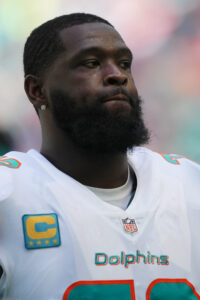 Injuries dogged Armstead throughout his Miami stay, following the decorated left tackle from New Orleans. But the $15MM-per-year blocker resided as Miami’s top O-lineman. Considering Tagovailoa’s health struggles, plenty of pressure will be on 2024 second-rounder Patrick Paul as he takes over. Considering RT Austin Jackson suffered a setback in his recovery from a knee injury, the Dolphins are in dire need of Paul developing swiftly on the other side.
Injuries dogged Armstead throughout his Miami stay, following the decorated left tackle from New Orleans. But the $15MM-per-year blocker resided as Miami’s top O-lineman. Considering Tagovailoa’s health struggles, plenty of pressure will be on 2024 second-rounder Patrick Paul as he takes over. Considering RT Austin Jackson suffered a setback in his recovery from a knee injury, the Dolphins are in dire need of Paul developing swiftly on the other side.
Armstead, 34, cited knee trouble in his retirement call. The 12-year veteran was under contract for two more seasons, and his retirement — processed after June 1 for cap purposes — will leave Miami with nearly $20MM in dead money from 2025-26. The post-June 1 move will at least keep the 2025 pain below $9MM. Still, Armstead played well when available and suited up in 15 games last season. PFF graded the five-time Pro Bowler as the NFL’s fourth-best tackle last season.
Chosen 55th overall out of Houston, Paul was a key 2024 backup but did not work as the Dolphins’ true swingman. Lamm filled in for Jackson, while Paul logged 248 LT snaps in place of Armstead at points. Paul has impressed at Dolphins camp, but a Jackson absence to open the season would leave the Dolphins threadbare at RT. Ex-Bears swingman Larry Borom resides as the next-best option, though Eichenberg has a tackle background. Tackle may be another place to watch for a late-summer Dolphins roster augmentation.
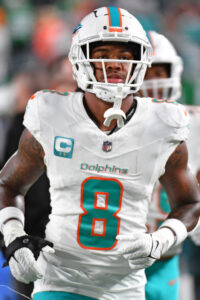 PFR’s No. 6 free agent, Holland landed with the Giants on a three-year, $45.3MM deal. The Dolphins used the 2021 second-round pick as a four-year starter. Like Wilkins last year, Miami passed on applying the franchise tag to its top free agent.
PFR’s No. 6 free agent, Holland landed with the Giants on a three-year, $45.3MM deal. The Dolphins used the 2021 second-round pick as a four-year starter. Like Wilkins last year, Miami passed on applying the franchise tag to its top free agent.
Pro Football Focus’ No. 3-ranked safety during Vic Fangio‘s 2023 DC one-off, Holland graded as the advanced metric’s site’s 56th-ranked player at the position under Anthony Weaver last season. The Dolphins have Elijah Campbell tentatively plugged in alongside Minkah Fitzpatrick, though Ifeatu Melifonwu‘s mid-camp debut would stand to give him a decent shot at winning this job. Campbell has made three starts in five seasons.
The Dolphins extended an offer for Calais Campbell to come back, but the suddenly nomadic stalwart rejoined the Cardinals. The 2010s All-Decade-teamer and former Hurricane back in the mid-aughts delivered five sacks and 12 TFLs, strengthening his Hall of Fame case. Miami used Calais Campbell as a full-time starter at age 38. The team turned to the draft to help replace him.
Miami has 2024 fourth-rounder Jaylen Wright readying for RB2 duty, though the team still drafted a back for a third straight year (Ollie Gordon, Round 6). A healthier De’Von Achane season relegated Mostert — the NFL’s 2023 TDs leader, 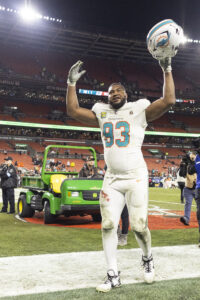 with 21 — to part-time duty; he logged only 278 snaps last season. The Dolphins had given Mostert a slight raise, but his eight-year partnership with Mike McDaniel ended via this release. Mostert, 33, caught on with the Raiders.
with 21 — to part-time duty; he logged only 278 snaps last season. The Dolphins had given Mostert a slight raise, but his eight-year partnership with Mike McDaniel ended via this release. Mostert, 33, caught on with the Raiders.
Fuller, 30, remains in free agency. The Dolphins had given the longtime Commanders cog a two-year, $15MM deal. Cutting bait one year in set the table for a full-on overhaul at corner. Poyer, 34, has not retired and, like Micah Hyde last year, is holding out hope for a Bills call. Catching on after a Bills release, Poyer gave the Dolphins 16 starts last season. PFF graded him 59th among safeties. In losing Holland, Ramsey, Poyer, Fuller and Kohou, the Dolphins’ secondary has an outlook that points to Storm Duck Fresh Prince finale memes.
Draft:
- Round 1, No. 13: Kenneth Grant (DT, Michigan) (signed)
- Round 2, No. 37 (from Raiders): Jonah Savaiinaea (G, Arizona) (signed)
- Round 5, No. 143 (from Raiders): Jordan Phillips (DT, Maryland) (signed)
- Round 5: No. 150: Jason Marshall (CB, Florida) (signed)
- Round 5, No. 155 (from Broncos): Dante Trader (S, Maryland) (signed)
- Round 6, No. 179 (from Browns through Texans): Ollie Gordon (RB, Oklahoma State) (signed)
- Round 7, No. 231: Quinn Ewers (QB, Texas) (signed)
- Round 7, No. 253*: Zeek Biggers (DT, Georgia Tech) (signed)
 A Dolphins-Grant connection surfaced during draft week, and the team indeed beefed up its defensive interior. Quietly ranking in the top 10 against the run and pass last season, the Dolphins could still have a much better front seven compared to their first post-Wilkins group. With Chubb and Phillips already accompanying Sieler and Chop Robinson, Grant will benefit.
A Dolphins-Grant connection surfaced during draft week, and the team indeed beefed up its defensive interior. Quietly ranking in the top 10 against the run and pass last season, the Dolphins could still have a much better front seven compared to their first post-Wilkins group. With Chubb and Phillips already accompanying Sieler and Chop Robinson, Grant will benefit.
Part of Michigan’s national championship-winning defense in 2023, Grant operates as a strong run deterrent at 330 pounds. The Wolverines aligned Grant as both a nose tackle and three-technique option. He did not tally a four-sack season but did add 12 TFLs during his two-year starter tenure. Grant’s presence boosted the Wolverines’ front seven under Jesse Minter and Wink Martindale. Grant could aid Sieler and the team’s first-round OLB troika soon.
Viewing the Patriots as a threat for Savaiinaea, the Dolphins traded up 11 spots. They sacrificed their third-round pick to do so. Arizona used Savaiinaea regularly at guard and tackle. He was a freshman All-American guard before being shifted to tackle during his final two years, splitting time between both edge spots last season. Though, the 324-pound blocker did not earn first- or second-team all-conference honors during his three-season Tucson run.
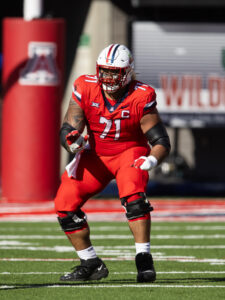 Turning 21 earlier this year, Savaiinaea is set to be a Day 1 guard starter in Miami. This did sacrifice a second-day draft choice for a team that has lost considerable talent during the past two free agency periods. Like they did with Wilkins (via Grant), the Dolphins circled back to replacing Robert Hunt a year later.
Turning 21 earlier this year, Savaiinaea is set to be a Day 1 guard starter in Miami. This did sacrifice a second-day draft choice for a team that has lost considerable talent during the past two free agency periods. Like they did with Wilkins (via Grant), the Dolphins circled back to replacing Robert Hunt a year later.
Mentioned as a potential Day 2 option, Ewers saw his stock crater on draft weekend. The Dolphins were mentioned as a possible Day 2 QB suitor, but even with Tagovailoa going down yet again last season, Miami has sunk too much into its southpaw passer to use a notable draft choice on one less than a year after the $53MM-per-year extension.
Ewers led Texas to back-to-back CFP semifinals, though he was not going to be asked back to start over Arch Manning this year. Rather than collect a lucrative transfer sum, Ewers left school early. He will settle for a mere $131K guarantee. Shedeur Sanders‘ fall, though, overshadowed Ewers’.
Other:
 Not quite on the Terrell Owens/Antonio Brown level in wide receiver distraction pantheon, Hill is moving up the ladder. Already coming to Miami with significant baggage stemming from off-field trouble, Hill was involved in a strange dustup at a marina in 2023. While Hill’s detainment on a traffic violation hours before the Dolphins’ Week 1 kickoff in 2024 did not qualify as anything close to his college- or Chiefs-years trouble, it provided a bookend to a season that concluded with a bizarre sequence — one that still has teams wondering if the Dolphins will trade him.
Not quite on the Terrell Owens/Antonio Brown level in wide receiver distraction pantheon, Hill is moving up the ladder. Already coming to Miami with significant baggage stemming from off-field trouble, Hill was involved in a strange dustup at a marina in 2023. While Hill’s detainment on a traffic violation hours before the Dolphins’ Week 1 kickoff in 2024 did not qualify as anything close to his college- or Chiefs-years trouble, it provided a bookend to a season that concluded with a bizarre sequence — one that still has teams wondering if the Dolphins will trade him.
Hill refusing to reenter the Dolphins’ Week 18 game and then wishing to move on from the team spotlighted a mercurial figure. Hill steadily walked back his trade stance, but his actions — and antics since — make this an unstable situation. Tagovailoa addressing Hill’s actions added to the weirdness here, and the QB’s comments came after an offseason report that suggested the Dolphins could listen to offers on their top weapon.
Hill avoided a one-sided loss to Noah Lyles with that one-v.-one race being nixed, but the suddenly slimmed down receiver still ran a separate 100-meter dash while rehabbing from wrist surgery. That race came before the 31-year-old playmaker resumed catching passes post-surgery; Hill is not exactly falling in line despite the headaches he caused exiting last season. Hill and Ramsey running amok has created skepticism about the Grier-McDaniel program, even after McDaniel attempted to make clear actions like Hill’s midgame exit would not be tolerated.
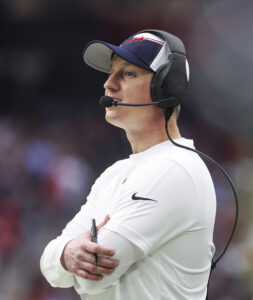 The Dolphins gave Hill a $54MM guarantee package after he angled for a redone deal in 2024. They then watched him regress, going from back-to-back 1,700-yard seasons to 959 in 17 games. Hill’s early Dolphins work locked up Hall of Fame entry, but it is fair to wonder if the Dolphins need to consider trading him while value remains.
The Dolphins gave Hill a $54MM guarantee package after he angled for a redone deal in 2024. They then watched him regress, going from back-to-back 1,700-yard seasons to 959 in 17 games. Hill’s early Dolphins work locked up Hall of Fame entry, but it is fair to wonder if the Dolphins need to consider trading him while value remains.
Miami owes Hill a $15.85MM option bonus by August 31. It would qualify as selling medium if the team bailed now, and dealing Hill would weaken McDaniel’s fourth Dolphins offense. But Hill’s name will be one to monitor before the November deadline, as there is plenty of time for more trouble between player and team.
Slowik, 38, went from the point man during C.J. Stroud‘s Offensive Rookie of the Year season to HC interviewee to Texans extension recipient within a year in Houston. After Stroud did not take a second-year leap — with a crumbling O-line in front of him — Slowik took the fall. He will attempt to rebuild his stock back with McDaniel. The two worked together in Washington and San Francisco.
Top 10 cap charges for 2025:
- Tua Tagovailoa, QB: $38.18MM
- Tyreek Hill, WR: $27.7MM
- Jaelan Phillips, OLB: $13.25MM
- Bradley Chubb, OLB: $12.33MM
- Jordyn Brooks, ILB: $11.05MM
- Aaron Brewer, C: $8.12MM
- Jaylen Waddle, WR: $8.02MM
- Alec Ingold, FB: $4.82MM
- Jason Sanders, K: $4.73MM
- Minkah Fitzpatrick, S: $4.5MM
The McDaniel-Grier regime will attempt to blunt the negative momentum with another playoff push. Miami will presumably have a healthy Hill available, and keeping Tagovailoa upright — a task that could certainly be tougher post-Armstead — has unleashed McDaniel’s offense in the past. A healthier front seven should mitigate cornerback concerns to a degree, but coverage issues could crop up early regardless.
Other than Tagovailoa injuries, late-season tumbles headlined by struggles winning in suboptimal weather have defined McDaniel’s otherwise successful tenure. The AFC also looks tougher compared to when the Dolphins last reached the playoffs. Can Miami resurface as a wild-card contender or will Stephen Ross pull the plug on this regime after a stalled ascent?
By Sam Robinson |
at August 12, 2025 10:55 pm
Reminding closely of the 49ers’ 2020 season, San Francisco’s latest NFC title defense skidded off track largely due to injuries. A difficult schedule, which came after two more late-summer contract sagas (Brandon Aiyuk and Trent Williams), ground up a depleted San Francisco roster, producing the same six wins the 2020 slate brought. This offseason brought significant changes, seeing a host of Super Bowl LVIII starters depart while also featuring a welcome change in the 49ers’ negotiation timing.
The team completed its top extension priorities before May’s end, reupping George Kittle, Brock Purdy and Fred Warner. This stood to minimize the distractions that have frequently impacted the 49ers during the Kyle Shanahan–John Lynch era. A far less imposing — as it appears in August — schedule awaits Shanahan’s ninth roster, and the team will attempt to replicate the 2021 squad’s rebound effort.
Extensions and restructures:
It is still difficult to overstate the oddity of Purdy’s career arc. Although Dak Prescott became the NFL’s highest-paid player out of the fourth round, Purdy was one pick from going undrafted. The NFL features 20 $20MM-per-year quarterbacks; Purdy is the only one chosen outside the fourth round. The Iowa State success story lost some steam from his 2023 breakthrough, as All-Pros kept dropping around him, but he did nothing to veer off the extension course he had traversed. The 49ers then managed an interesting compromise.
 Regularly labeled a modest talent in a great system, Purdy has operated on a higher level compared to Jimmy Garoppolo — a player the 49ers once re-signed at a top-market rate. That ignited what had been a slower-moving QB market in 2018, and passers continue to benefit. Because of the struggles the 2021 and ’22 QB draftees have faced, Purdy stood as the only contract-year passer to monitor regarding a blockbuster payday this offseason.
Regularly labeled a modest talent in a great system, Purdy has operated on a higher level compared to Jimmy Garoppolo — a player the 49ers once re-signed at a top-market rate. That ignited what had been a slower-moving QB market in 2018, and passers continue to benefit. Because of the struggles the 2021 and ’22 QB draftees have faced, Purdy stood as the only contract-year passer to monitor regarding a blockbuster payday this offseason.
Following up his first-place QBR finish in 2023 with a seventh-place conclusion despite the losses of Aiyuk, Williams and Christian McCaffrey — and more underwhelming Deebo Samuel play — Purdy solidified his extension status. He had already gone toe-to-toe with Patrick Mahomes in Super Bowl LVIII to punctuate one of the most unlikely ascents in quarterback history, and that 2023 produced only the second full-season yards-per-attempt number north of 9.5 since the 1950s (trivia answer: Chris Chandler‘s 1998 slate). Shanahan’s offense undoubtedly has boosted Purdy; team and player reached a compromise that undoubtedly stemmed from this unique arrangement.
Seeking an early-offseason deal in order to minimize distractions, Purdy is believed to have asked for $65MM per year. That was a nonstarter for the 49ers. Rather than the usual San Francisco stalemate dragging well into training camp, the sides resolved it with a $53MM-per-year deal that carries a player-friendly structure.
 Purdy secured a Mahomes-like rolling guarantee structure. A $55.1MM 2028 payout will become guaranteed April 1, 2027, per OverTheCap. The 49ers are due to pay out a $7.2MM guarantee for 2029 on April 1, 2028. These key dates follow a $100MM at-signing guarantee. Purdy’s $165.1MM cash flow through four years betters Jared Goff‘s number, even if the Lions QB has Purdy’s deal beat at the second- and third-year marks.
Purdy secured a Mahomes-like rolling guarantee structure. A $55.1MM 2028 payout will become guaranteed April 1, 2027, per OverTheCap. The 49ers are due to pay out a $7.2MM guarantee for 2029 on April 1, 2028. These key dates follow a $100MM at-signing guarantee. Purdy’s $165.1MM cash flow through four years betters Jared Goff‘s number, even if the Lions QB has Purdy’s deal beat at the second- and third-year marks.
The 49ers managed to still sign Purdy to an AAV tied for seventh at the position. Considering the Jaguars and Packers needed to match the top QB salary at the time to extend their passers (Trevor Lawrence, Jordan Love) without a Purdy-level season on their resumes, the 49ers did well not to approach Prescott’s $60MM-per-year topper. Purdy agreeing to the Goff AAV after the cap spiked by another $24MM is a team win, though this is still a substantial commitment to a player that drew no draft buzz three years ago.
Even if Purdy admitted to leaving money on the table to help the 49ers build around him, this is a seismic payout for him; the QB’s rookie deal was worth $3.74MM. This compromise also netted Purdy a no-trade clause, providing protection few players across the league enjoy. While this deal does not make it a lock Purdy finishes his career in San Francisco, it is a sizable commitment.
It was worth wondering — after the high-end deals given to non-top-tier passers like Lawrence, Love and Tua Tagovailoa last year — if the 49ers would consider letting Purdy play out his rookie contract while keeping the trade door open. But rumors steadily emerged about an extension. The team fully endorsed its former third-string QB, minimizing any talk of a potential 49ers zag while they added another rookie-deal QB to play for Shanahan.
 Purdy’s payday came after Kittle inked his third contract. Having built a Hall of Fame resume, Kittle was still unable to move the tight end position past $20MM per year. The 49ers handed their all-around TE dynamo an extension weeks after Ja’Marr Chase elevated the WR ceiling to $40.25MM, it is certainly interesting the NFL keeps valuing top TEs far lower than high-end WR2s.
Purdy’s payday came after Kittle inked his third contract. Having built a Hall of Fame resume, Kittle was still unable to move the tight end position past $20MM per year. The 49ers handed their all-around TE dynamo an extension weeks after Ja’Marr Chase elevated the WR ceiling to $40.25MM, it is certainly interesting the NFL keeps valuing top TEs far lower than high-end WR2s.
Kittle’s deal also came after the Cardinals kept Trey McBride under $20MM per year. While a sizable gap existed between team and player early, the deal was done before April ended. Regardless of how undervalued Kittle appears to be, the deal may ensure the ninth-year pass catcher finishes his career in San Francisco.
Purdy could well become the defining Shanahan/Lynch draft choice, but Kittle is right there. The former No. 146 overall pick moved into a tie for second place all time with a fourth 1,000-yard TE season. Kittle has not matched peak Travis Kelce in terms of receiving success, as the 49ers use him differently, but he has long been the game’s premier all-around tight end. Vital to the 49ers’ run game as well, Kittle has five All-Pros on an eight-season resume. He also stayed mostly healthy since his first extension (5/75) preceded an eight-game 2020. Kittle, 31, has played at least 15 games in each of the past three seasons.
Kelce and Rob Gronkowski being tied to team-friendly contracts hurt the tight end market on the whole, and Kittle heading into an age-32 season limited his earning power. This deal locks him in through at least 2026, and $2MM of the Iowa alum’s 2027 money is guaranteed at signing. The 49ers used an Eagles-like structure, filled with option bonuses and void years, to keep Kittle’s cap hits under $19MM until 2029. The 49ers did not submit to a rolling guarantee structure here, making 2027 a year to monitor regarding this contract. By 2028, the 49ers can escape it for less than $5MM in dead money.
 Purdy’s extension influenced the 49ers in free agency, which included far more notable losses than additions, but the team’s Dre Greenlaw‘s price point probably pertained to Warner’s future. Unlike Shaquille Leonard, Warner has stayed healthy after resetting the off-ball LB market in 2021. The 49ers rewarded him by ending Roquan Smith‘s two-year run atop the market.
Purdy’s extension influenced the 49ers in free agency, which included far more notable losses than additions, but the team’s Dre Greenlaw‘s price point probably pertained to Warner’s future. Unlike Shaquille Leonard, Warner has stayed healthy after resetting the off-ball LB market in 2021. The 49ers rewarded him by ending Roquan Smith‘s two-year run atop the market.
Like Kittle, Warner appears on his way to Canton. He is riding a three-season streak of first-team All-Pro honors and has four in his career. That matches NaVorro Bowman‘s count and is just one shy of 2024 Hall inductee Patrick Willis‘. Warner also played through an ankle fracture last season, still motoring to his usual All-Pro perch.
The 49ers have seen the former third-round pick miss one career game, giving them confidence in Warner staying power into his early 30s while also providing important durability for a frequently injury-plagued team. The dynamic cover LB’s 2027 money will become guaranteed by April 1, 2026.
Trades:
 While the 49ers continue to build around Super Bowl LIV starters Kittle and Warner, they separated from another by making Samuel part of this offseason’s first trade. The $30MM-per-year Aiyuk extension pointed to Samuel being trade bait this offseason, and while the 49ers expressed some hope they could keep their five-year receiving duo together, they quickly pivoted to letting his camp find a trade partner. As it turned out, only one truly emerged.
While the 49ers continue to build around Super Bowl LIV starters Kittle and Warner, they separated from another by making Samuel part of this offseason’s first trade. The $30MM-per-year Aiyuk extension pointed to Samuel being trade bait this offseason, and while the 49ers expressed some hope they could keep their five-year receiving duo together, they quickly pivoted to letting his camp find a trade partner. As it turned out, only one truly emerged.
The Broncos and Texans looked into Samuel, but neither made an offer. A year after Aiyuk expressed interest in joining college teammate Jayden Daniels via trade, the Commanders — led by ex-49ers assistant GM Adam Peters — acquired Samuel. Whereas the Steelers needed to send a second-round pick to the Seahawks for D.K. Metcalf and hand over a top-four extension, this trade involving a 2019 WR draftee amounted to a salary dump. It still stings the 49ers, who are taking on $34.12MM in dead money — breaking the Bills’ Stefon Diggs WR record from last year — following the swap.
The Commanders have not extended Samuel, who remains tied to his three-year, $71.55MM deal from summer 2022. The 49ers asked for Jonathan Allen in the trade, but the Pro Bowl DT was not included. San Francisco also passed on Allen in free agency after his Washington release.
Even as Samuel would occasionally make highlight-reel plays, he struggled with durability and put up generally unremarkable stats on his second 49ers contract. Samuel’s dominant 2021 — 1,405 receiving yards, 365 on the ground, 14 touchdowns — now looks like an outlier. While the “wide back” did impress in 2023 (892/225/12), he did not eclipse 700 receiving yards in 2022 or ’24. Having accumulated 202 rushing attempts also could shorten Samuel’s career, as he plays with a physical style.
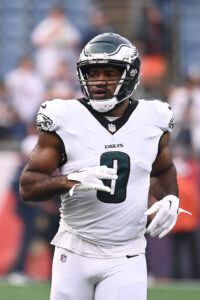 The 2019 second-round pick did make important contributions during the 49ers’ four NFC championship game journeys, but the team sold low and has Ricky Pearsall‘s rookie deal — and a low-cost Jauan Jennings contract, much to the ascendant WR’s chagrin — complementing Aiyuk’s top-10 WR terms. Though, the 49ers continue to have persistent trouble keeping their top wideouts healthy. That has continued during training camp.
The 2019 second-round pick did make important contributions during the 49ers’ four NFC championship game journeys, but the team sold low and has Ricky Pearsall‘s rookie deal — and a low-cost Jauan Jennings contract, much to the ascendant WR’s chagrin — complementing Aiyuk’s top-10 WR terms. Though, the 49ers continue to have persistent trouble keeping their top wideouts healthy. That has continued during training camp.
Huff received a lifeline because of this trade. One of the few Eagles to see his stock drop last year, Huff was a healthy scratch for Super Bowl LIX despite commanding $34MM guaranteed at signing in 2024. The former Jets passing-down specialist sensed early he would not fit in Vic Fangio‘s scheme; he will now be back under Robert Saleh, who oversaw his ascent to a 10-sack player in 2023.
After winning a bidding war, the Eagles realized Huff was not worth the three-year, $51MM contract. In Saleh’s Jets scheme, however, Huff finished his tenure with a dominant (albeit in short spurts) contract year. He was PFR’s No. 9 free agent in 2024, having led the NFL in pressure rate (21.8%). That came on just 480 snaps, which proved telling ahead of an injury-affected Eagles slate. But the Jets’ 2023 sack leader was struggling before his wrist injury. He tallied all of 2.5 sacks and four QB hits last season.
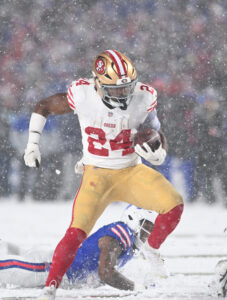 The 49ers have Huff on a $7.95MM guaranteed 2025 salary; beyond this year, he can be cut free of charge. The 49ers will likely adjust Huff’s contract if they intend to keep him in 2026, as his cap number balloons to $17.1MM next year. Huff, 27, joins the resilient Yetur Gross-Matos and first-rounder Mykel Williams as Nick Bosa complementary rushers. The 49ers continue to shuffle through Bosa wingmen, and Huff follows Chase Young, Randy Gregory and Charles Omenihu as a trade piece to staff part of this contingent.
The 49ers have Huff on a $7.95MM guaranteed 2025 salary; beyond this year, he can be cut free of charge. The 49ers will likely adjust Huff’s contract if they intend to keep him in 2026, as his cap number balloons to $17.1MM next year. Huff, 27, joins the resilient Yetur Gross-Matos and first-rounder Mykel Williams as Nick Bosa complementary rushers. The 49ers continue to shuffle through Bosa wingmen, and Huff follows Chase Young, Randy Gregory and Charles Omenihu as a trade piece to staff part of this contingent.
Mason outlasted third-rounders Trey Sermon and Tyrion Davis-Price and was a much more reliable option than pre-McCaffrey starter Elijah Mitchell. A former UDFA, Mason began last season as the 49ers’ starter due to McCaffrey’s injury. Averaging over 5.0 yards per carry on limited usage in 2022 and ’23, Mason impressively posted a 5.2-yard number on 153 carries last year. The 49ers sold high, but they will rely on 2024 third-rounder Isaac Guerendo — he of a sub-4.4-second 40-yard dash time in 2024 — behind CMC this year. One of the top fantasy handcuff options in recent memory, Guerendo averaged 5.3 yards per tote as a rookie.
Free agency additions:
- Luke Farrell, TE. Three years, $15.75MM ($6MM guaranteed)
- Demarcus Robinson, WR. Two years, $8MM ($6MM guaranteed)
- Mac Jones, QB. Two years, $7MM ($4.75MM guaranteed)
- Siran Neal, DB. Two years, $4MM ($2.26MM guaranteed)
- Jason Pinnock, S. One year, $2.2MM ($2.2MM guaranteed)
- Thomas Morstead, P. One year, $1.42MM ($1.2MM guaranteed)
- Luke Gifford, LB. One year, $1.8MM ($800K guaranteed)
- Tre Brown, CB. One year, $1.7MM ($500K guaranteed)
- Richie Grant, S. One year, $1.5MM ($345K guaranteed)
- Andre Dillard, T. One year, $1.17MM ($315K guaranteed)
- Patrick Taylor, RB. One year, $1.17MM ($300K guaranteed)
- Jon Weeks, LS. One year, $1.42MM ($200K guaranteed)
- Ross Dwelley, TE. One year, $1.42MM
- Ameer Abdullah, RB. One year, $1.26MM
- Robbie Chosen, WR. One year, $1.26MM
- Dallis Flowers, CB. One year, $1.1MM
- Jeff Wilson, RB. Signed 8/10
 Farrell’s Jacksonville-to-San Francisco migration headlining a team’s free agency payments illustrates a light acquisition effort on the 49ers’ part. The 49ers lost blocking tight end Charlie Woerner to the Falcons last year and saw the Lions match their Brock Wright RFA offer sheet. Farrell spent much of his on-field time last season as a run blocker.
Farrell’s Jacksonville-to-San Francisco migration headlining a team’s free agency payments illustrates a light acquisition effort on the 49ers’ part. The 49ers lost blocking tight end Charlie Woerner to the Falcons last year and saw the Lions match their Brock Wright RFA offer sheet. Farrell spent much of his on-field time last season as a run blocker.
Pro Football Focus raved about Farrell’s run-blocking work, grading him second-best among tight ends in that skill last season. The 49ers have long prioritized run blocking at tight end, as Kittle fantasy GMs can confirm, and Farrell (27) should give them a quality option in his prime.
Safety has been a wildly unstable position in San Francisco. From toggling Jimmie Ward between safety and the slot to Jaquiski Tartt‘s crushing INT drop to Talanoa Hufanga‘s All-Pro season preceding two injury-marred slates, the 49ers have struggled to staff this role. That will continue, as 2024 rookie starter Malik Mustapha is expected to miss regular-season time due to a Week 18 ACL tear. In Pinnock and Grant, the team grabbed two starters at cheap rates. One of the two will slide in as depth post-Tashaun Gipson.
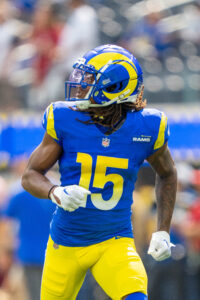 Not exactly beacons of safety stability, as Julian Love and Xavier McKinney left town, the Giants turned to Pinnock as a starter from 2023-24. A 2021 Jets fifth-round pick, Pinnock reunites with Saleh after the team waived him in 2022. Pinnock started 37 games on his rookie contract, making 85 tackles in each of the past two seasons. He intercepted two passes in 2023, taking one back for a touchdown, and combined to make 10 TFLs over the past two years. PFF graded Pinnock as a top-50 safety in 2023 but placed him 78th last season.
Not exactly beacons of safety stability, as Julian Love and Xavier McKinney left town, the Giants turned to Pinnock as a starter from 2023-24. A 2021 Jets fifth-round pick, Pinnock reunites with Saleh after the team waived him in 2022. Pinnock started 37 games on his rookie contract, making 85 tackles in each of the past two seasons. He intercepted two passes in 2023, taking one back for a touchdown, and combined to make 10 TFLs over the past two years. PFF graded Pinnock as a top-50 safety in 2023 but placed him 78th last season.
Pinnock is on track to start, impressing to the point two-year starter Ji’Ayir Brown is in competition with Grant and fifth-round rookie Marques Sigle for the other spot. Justin Simmons replaced Grant in 2024. Grant started 32 games for the Falcons from 2022-23.
With Samuel gone and Brandon Aiyuk unlikely to be ready for Week 1, the 49ers still stood down at receiver. The Jauan Jennings–Ricky Pearsall duo will be important until Aiyuk returns, but Robinson will be relied upon early in the season as well. The former Patrick Mahomes and Matthew Stafford tertiary target impressed as Los Angeles’ primary WR3 last season, hauling in 31 passes for 505 yards and seven touchdown grabs.
The nine-year veteran collected guarantees into Year 2 of his deal, pointing to an expectation for the four-time 400-yard performer to be a regular in the 49ers’ offense. Though, Aiyuk returning would stand to slide Robinson to the WR4 post. Robinson is suddenly not a safe bet, either, after pleading no contest to a DUI charge. A three-game suspension, which Robinson has preemptively appealed, could further limit the 49ers to open the season.
 Although a rumor connected the 49ers to Davante Adams, nothing came out of it. Adams signed a two-year, $46MM deal with the Rams. The 49ers allocated their money to extensions, having already committed to Aiyuk as their high-priced wideout.
Although a rumor connected the 49ers to Davante Adams, nothing came out of it. Adams signed a two-year, $46MM deal with the Rams. The 49ers allocated their money to extensions, having already committed to Aiyuk as their high-priced wideout.
As it turned out, the 49ers did not have a deal in place with D.J. Humphries, who joins Adams with the Rams. Dillard represents a shaky swing option, having been a Titans release — after being demoted — one season into a three-year, $29MM deal. Dillard, though, played as a Packers backup last year and cost the veteran minimum. Dillard joins Spencer Burford and as the 49ers’ top swing options at tackle.
Weeks wanted to stay with the Texans, but they moved on from the longest-tenured player in franchise history. The 39-year-old long snapper will play his 16th season in San Francisco, being part of a historically old snapper-punter duo. Morstead is also 39 but will reunite with Saleh, who had the ex-Saints Super Bowl winner installed as his punter during two separate stints while employed as Jets HC. Morstead averaged at least 47.2 yards per punt as a Jet; six-year option Mitch Wishnowsky — cut after suffering a back injury last November — only reached that number once in six seasons.
Read more
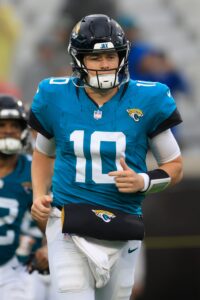 Although the 49ers discussed a deal with Jameis Winston, they circled back to Jones, who was closely linked to being the team’s preference when it traded up to No. 3 overall in 2021.
Although the 49ers discussed a deal with Jameis Winston, they circled back to Jones, who was closely linked to being the team’s preference when it traded up to No. 3 overall in 2021.
Shanahan was reported to have preferred Jones then, only to be talked out of the move by his front office due to the poor value the low-ceiling Alabama product carried compared to Trey Lance. Shanahan’s success with Garoppolo and Purdy probably makes him a better authority on quarterback play, and while it is worth wondering if Jones would be a better QB had he developed under Shanahan (almost definitely yes), he follows Sam Darnold as a midcareer Bay Area backup option.
Jones fell far from his Offensive Rookie of the Year runner-up perch, seeing Bill Belichick‘s wildly irresponsible Matt Patricia-as-OC gamble accelerate a freefall for his QB. After the disjointed 2022, Jones did not recapture his form under Bill O’Brien, being demoted before the 2023 season ended.
Jones finished last season as the Jaguars’ starter, after Trevor Lawrence‘s two-injury 2024. Jones averaged just 6.4 yards per attempt and posted an 8:8 TD-INT ratio. The former No. 15 overall pick was at 7.3 as a rookie under Josh McDaniels, guiding the Patriots to a playoff berth. Shanahan did well with another notable ex-McDaniels pupil (Garoppolo), but as Darnold not sniffing the starting job in 2023 showed, no QB controversy exists here.
Re-signings:
 Juszczyk was on a two-year, $9.1MM deal but ended up being released as the 49ers reshuffled their roster in free agency. The decorated fullback considered joining the Steelers after making a free agency visit, but he is now on his fourth 49ers contract.
Juszczyk was on a two-year, $9.1MM deal but ended up being released as the 49ers reshuffled their roster in free agency. The decorated fullback considered joining the Steelers after making a free agency visit, but he is now on his fourth 49ers contract.
In place as Shanahan’s fullback for eight seasons, Juszczyk has made the last nine Pro Bowls — albeit at a position long relegated to niche status — and has caught 184 passes (13 for TDs) as a 49er. Reminding of Fletcher Cox, who rejoined the Eagles after an offseason release in 2023, Juszczyk (34) will be back with his longtime team.
It looks like Bartch will be a low-cost Aaron Banks replacement opposite Dominick Puni. The 49ers have developed Bartch in their system over the past two years, adding him in 2023 — after the Jaguars’ deadline Ezra Cleveland trade prompted them to cut a guard. Bartch looks likely to beat out Nick Zakelj for the team’s left guard job. Despite being mostly a 49ers backup in his time with the team, Bartch has made 22 career starts (20 with the Jags).
Notable losses:
- Brandon Allen, QB
- Aaron Banks, G
- De’Vondre Campbell, LB
- Maliek Collins, DT (post-June 1 cut)
- Chris Conley, WR (retired)
- Josh Dobbs, QB
- Jon Feliciano, G (retired)
- Demetrius Flannigan-Fowles, LB (released)
- Leonard Floyd, DE (released)
- Tashaun Gipson, S
- Dre Greenlaw, LB
- Javon Hargrave, DT (post-June 1 cut)
- Charlie Heck, T
- Talanoa Hufanga, S
- Drake Jackson, DE (waived)
- Greg Joseph, K (released)
- Nick McCloud, CB
- Elijah Mitchell, RB
- Jaylon Moore, T
- George Odum, S (released)
- Taybor Pepper, LS (released)
- Nicholas Petit-Frere, RT (waived)
- Eric Saubert, TE
- Charvarius Ward, CB
- Mitch Wishnowsky, P (released)
- Rock Ya-Sin, CB
- Isaac Yiadom, CB
 Four Super Bowl LVIII starters joined Hufanga, who certainly would have lined up in that game had he not torn an ACL, in one of the most eventful free agency exoduses in recent NFL history. The 49ers, though, already locked up Aiyuk and Deommodore Lenoir last year. And they saved up for Kittle, Warner and Purdy paydays. Thus, a talent dispersion commenced.
Four Super Bowl LVIII starters joined Hufanga, who certainly would have lined up in that game had he not torn an ACL, in one of the most eventful free agency exoduses in recent NFL history. The 49ers, though, already locked up Aiyuk and Deommodore Lenoir last year. And they saved up for Kittle, Warner and Purdy paydays. Thus, a talent dispersion commenced.
Of the departing contingent, Greenlaw drew the most retention interest from the team. The 49ers took the step of flying their top power brokers to Texas to meet with Greenlaw after he had committed to the Broncos. The 11th-hour pitch during the legal tampering period brought an offer increase — a proposal that surpassed the Broncos’ three-year, $31.5MM invite — but could not convince Greenlaw to back out of his Denver agreement.
It is not known if the 49ers out-offered the Broncos in terms of total value or even full guarantees. With Denver only giving him essentially one fully guaranteed year ($11.5MM), it stands to reason the 49ers did not top that number by much.
 Based on the razor-thin margin separating the Chiefs from the 49ers in Super Bowl LVIII, a reasonable case can be made Greenlaw’s Achilles tear — suffered while trotting onto the field in the first half — cost the NFC champions a title. Travis Kelce reawakened following Greenlaw’s exit, as the Chiefs targeted Oren Burks in coverage.
Based on the razor-thin margin separating the Chiefs from the 49ers in Super Bowl LVIII, a reasonable case can be made Greenlaw’s Achilles tear — suffered while trotting onto the field in the first half — cost the NFC champions a title. Travis Kelce reawakened following Greenlaw’s exit, as the Chiefs targeted Oren Burks in coverage.
The 49ers did not see Greenlaw return until Week 15. He was limited to 34 snaps, affecting the Broncos’ guarantee number. The 49ers will move on from a fifth-round success story, and while they pursued ex-Colt E.J. Speed before his Texans deal, Dee Winters — the player the 49ers regularly used De’Vondre Campbell over in 2024 — in place as the team’s hopeful new Warner sidekick.
The 49ers did not offer Ward a deal to stay, extending the much younger Lenoir in-season. Ward wanted to return but was miffed no proposal came. Even if the 49ers wanted Ward back, their situation would not have made it realistic they could compete with the Colts’ three-year, $54MM offer ($27MM fully guaranteed). Ward struggled in 2024, dealing with the death of his 1-year-old daughter, but was a valuable 49ers contributor from 2022-23. The latter season brought a second-team All-Pro nod; desperate for better boundary CB play, the Colts paid up.
 Joining Greenlaw, Banks and Ward among PFR’s top 50 free agents, Hufanga found a team willing to bet on his ceiling rather than punish him for missing much of the past two seasons. The Broncos beefed up their defensive middle by adding he and Greenlaw, but Hufanga — a 2022 All-Pro safety who missed 17 games from 2023-24 — fetched a three-year, $39MM deal with $20MM at signing.
Joining Greenlaw, Banks and Ward among PFR’s top 50 free agents, Hufanga found a team willing to bet on his ceiling rather than punish him for missing much of the past two seasons. The Broncos beefed up their defensive middle by adding he and Greenlaw, but Hufanga — a 2022 All-Pro safety who missed 17 games from 2023-24 — fetched a three-year, $39MM deal with $20MM at signing.
It is likely Hufanga would have challenged Tre’von Moehrig as this year’s highest-paid safety (3/51) had he not suffered the ACL tear in 2023 and wrist malady last season. The Broncos were willing to bet on the high upside the 25-year-old talent showed in 2022 (97 tackles, four INTs, two sacks, two forced fumbles, five TFLs), and if Hufanga can stay healthy (a big ask), Sean Payton‘s team will have a bargain at $13MM AAV.
Banks parlayed his three starter seasons into a Packers windfall, collecting four-year, $77MM pact — as this offseason continued to reward free agent guards. The 49ers were not viewed as a serious contender for Banks due to their situation, but going from a former second-rounder to Bartch could bring a noticeable drop-off. Banks landed with one of the Shanahan system outposts (Matt LaFleur‘s offense), and the 49ers are continuing their Trent Williams-and-scraps O-line philosophy. None of the 49ers’ other starting O-linemen are tied to a deal north of $6MM AAV.
 This also meant letting Moore walk. John Lynch was surprised Moore commanded a $15MM-per-year Chiefs offer; advanced metrics did not view Moore as an above-average tackle in San Francisco, but he attracted interest based on a late-season stay filling in for Williams.
This also meant letting Moore walk. John Lynch was surprised Moore commanded a $15MM-per-year Chiefs offer; advanced metrics did not view Moore as an above-average tackle in San Francisco, but he attracted interest based on a late-season stay filling in for Williams.
Another D-tackle overhaul commenced in San Francisco as well. The team’s $21MM-per-year Hargrave deal to overlap with Purdy’s rookie contract lingers on the books as dead money.
The 49ers lead the NFL in dead cap, already at $95.15MM before training camp’s conclusion. The team will see only $6.7MM from the Hargrave cut hit the books this year; another $16.6MM awaits in 2026. The team still has $15.1MM in Arik Armstead money on its 2025 payroll, while Ward void years brings a $12.3MM penalty. Floyd’s one-and-done, despite an 8.5-sack season, brings an $8.63MM cap hit.
Draft:
- Round 1, No. 11: Mykel Williams (DE, Georgia) (signed)
- Round 2, No. 43: Alfred Collins (DT, Texas) (signed)
- Round 3, No. 75: Nick Martin (LB, Oklahoma State) (signed)
- Round 3, No. 100: Upton Stout (CB, Western Kentucky) (signed)
- Round 4, No. 113: CJ West (DT, Indiana) (signed)
- Round 4, No. 138: Jordan Watkins (WR, Ole Miss) (signed)
- Round 5: No. 147 (from Saints through Commanders): Jordan James (RB, Oregon) (signed)
- Round 5, No. 160 (from Vikings): Marques Sigle (S, Kansas State) (signed)
- Round 7, No. 227: Kurtis Rourke (QB, Indiana) (signed)
- Round 7, No. 249: Connor Colby (G, Iowa) (signed)
- Round 7, 252: Junior Bergen (WR, Montana) (signed)
Although the 49ers have authorized midlevel free agent deals and traded a third-round pick for Chase Young, Williams is the most significant investment in a Nick Bosa sidekick. The 49ers have cycled through these pieces throughout Bosa’s tenure. The Floyd release represented the latest such switch, and while the team moved close to a Joey Bosa deal, the Bills coming in with what was probably a much better offer broke up the Bosa reunion. San Francisco kept this position on the radar, however.
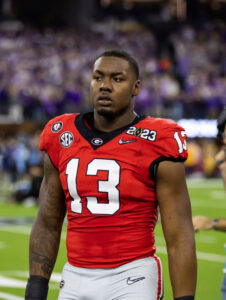 After hosting Williams on a “30” visit, the 49ers pulled the trigger. Joining Jalon Walker as the latest Georgia pass rushers to go in the first round, Williams ranked below Walker (per NFL.com’s Daniel Jeremiah and The Athletic’s Dane Brugler) but went ahead of his Bulldogs teammate. More of a power rusher, Williams has shown the ability to move inside, which could give the 49ers interesting options. This is the team’s top DE investment since taking Nick Bosa second overall in 2019.
After hosting Williams on a “30” visit, the 49ers pulled the trigger. Joining Jalon Walker as the latest Georgia pass rushers to go in the first round, Williams ranked below Walker (per NFL.com’s Daniel Jeremiah and The Athletic’s Dane Brugler) but went ahead of his Bulldogs teammate. More of a power rusher, Williams has shown the ability to move inside, which could give the 49ers interesting options. This is the team’s top DE investment since taking Nick Bosa second overall in 2019.
The former five-star recruit played through an early-season injury in 2024, but he was never a statistical standout in college (zero six-sack or 10-TFL seasons). A pair of second-team All-SEC seasons are on Williams’ resume, however, and the 49ers will expect a bigger early workload compared to their second-round Drake Jackson investment. The 49ers were believed to have shown interest in trading up for Tetairoa McMillan, a player the Rams coveted as well. But San Francisco will still carry two first-round wideouts on its roster.
The injury Kevin Givens suffered is expected to sideline him into the regular season, opening the door for Collins. At 332 pounds, Collins will be expected to be a difference-maker in the run game. He teamed with Byron Murphy and T’Vondre Sweat at Texas — during a six-year college stay — but did not land a first- or second-team all-conference honor as a Longhorn. The 49ers are suddenly thin at D-tackle, and Collins may be needed to make a quick jump to complement Jordan Elliott and elevate what was an 18th-place run defense last season.
 Stout is expected to win the slot cornerback competition. Considering Lenoir’s dual role in recent years, it will be interesting to see if the 49ers give their highest-paid corner more of a boundary-based role during his extension’s first season.
Stout is expected to win the slot cornerback competition. Considering Lenoir’s dual role in recent years, it will be interesting to see if the 49ers give their highest-paid corner more of a boundary-based role during his extension’s first season.
Stout filling the slot role Renardo Green was rumored to hold at this time last year is interesting, and the 49ers have flexibility due to Green and Lenoir’s skillsets. Green, though, barely played in the slot (33 snaps) last season. He will be expected to man one perimeter, Lenoir the other. At 5-foot-8, Stout led all DBs in bench press reps (21) and in the gauntlet drill at the Combine; he also played in the slot at North Texas and Western Kentucky.
Greenlaw’s departure could clear a path for Martin, rounding out a defense-heavy top of the draft. After a first-team All-Big 12 season (with Texas and Oklahoma still in the conference), Martin suffered a season-ending knee injury last year. He was ready for training camp, but it does appear Dee Winters (PFF’s No. 38 off-ball ‘backer last year) will enter the season as Warner’s wingman.
Other:
 The 49ers could not replace DeMeco Ryans following his 2023 Houston move, with the defense nosediving under Sorensen. While the team wanted to retain the special teams staffer-turned-DC in an ST role again, the sides separated (Sorensen is now the Cowboys’ ST coordinator). Enter Saleh, an ideal candidate due to the energetic coordinator/exasperated HC’s experience under Shanahan. Saleh held the DC role twice as long as Ryans, and the 49ers’ 2019 surge on this side of the ball came under Saleh.
The 49ers could not replace DeMeco Ryans following his 2023 Houston move, with the defense nosediving under Sorensen. While the team wanted to retain the special teams staffer-turned-DC in an ST role again, the sides separated (Sorensen is now the Cowboys’ ST coordinator). Enter Saleh, an ideal candidate due to the energetic coordinator/exasperated HC’s experience under Shanahan. Saleh held the DC role twice as long as Ryans, and the 49ers’ 2019 surge on this side of the ball came under Saleh.
Saleh interviewed for the Cowboys, Jaguars and Raiders’ HC jobs. Being more Rooney Rule filler in Dallas, Saleh looked to be the Jaguars’ second choice — had the Liam Coen caper failed. Anthony Campanile, whom the Jags hired as DC, was viewed as the 49ers’ contingency plan in case Saleh landed the Jacksonville HC gig. Saleh went 20-36 as Jets HC, being saddled with overseeing the Aaron Rodgers circus while navigating Woody Johnson‘s overreach. The owner’s impulsive firing did not key a turnaround, and Saleh was mostly stuck with Zach Wilson during his Jets stint.
Saleh, 46, still rebuilt New York’s defense; the unit went from last place in 2021 to fourth in ’22. Gang Green ranked third in total defense in 2023; this came as it looked like the 49ers lost their identity post-Ryans. Saleh could be back on the HC radar next year; going 7-10 twice with Wilson as the primary QB1 is aging rather well. But the 49ers also could benefit from Saleh’s Big Apple struggles, giving them the chance to ensure vital continuity on the side of the ball Shanahan does not oversee.
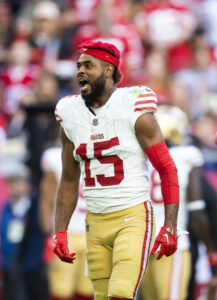 Klay Kubiak‘s move to OC could trigger HC interest; Mike McDaniel did as a non-play-calling 49ers OC, while Matt LaFleur was also a Shanahan disciple. But that might be a stretch for now. Lombardi, fired 1 1/2 years into his Raiders OC stay, may be the more notable move on offense. Purdy’s QBs coach during his dominant 2023 season, Griese turned down a Jets HC interview and has left the profession.
Klay Kubiak‘s move to OC could trigger HC interest; Mike McDaniel did as a non-play-calling 49ers OC, while Matt LaFleur was also a Shanahan disciple. But that might be a stretch for now. Lombardi, fired 1 1/2 years into his Raiders OC stay, may be the more notable move on offense. Purdy’s QBs coach during his dominant 2023 season, Griese turned down a Jets HC interview and has left the profession.
After the 49ers appeared to solve their contract procrastination problem, Jennings has attempted to make his an issue. Jennings signed a two-year, $11.89MM deal as an RFA last year but then excelled as an Aiyuk fill-in. The veteran WR clearly views his 975-yard season — a career-high mark by over 500 — as worthy of a new salary bracket.
Jennings, 28, is also battling a calf injury; Shanahan disputed this is a hold-in tactic. The former seventh-round pick would draw extensive UFA interest come March, but he is attempting to market his age-28 season in this current effort. No official trade request has emerged, but seeing as this is a 49ers wide receiver, that would not exactly surprise.
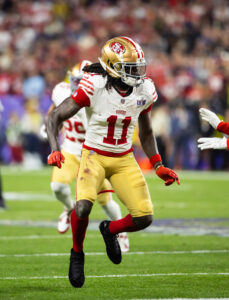 Aiyuk landed back in trade rumors, somehow contributing even more such content to the PFR pages, but coming off the ACL tear, such a move was unrealistic. The 49ers did not shut down the idea of an Aiyuk trade, which would have been bizarre given the seemingly resolved 2024 trade saga, but they paid him a $22.85MM roster bonus. Aiyuk, 27, a reserve/PUP list candidate. Seeing as he went down Oct. 20, 2024, a return by Week 1 would be well within the usual recovery timeline. Each injury, of course, is different, and this was not a clean tear.
Aiyuk landed back in trade rumors, somehow contributing even more such content to the PFR pages, but coming off the ACL tear, such a move was unrealistic. The 49ers did not shut down the idea of an Aiyuk trade, which would have been bizarre given the seemingly resolved 2024 trade saga, but they paid him a $22.85MM roster bonus. Aiyuk, 27, a reserve/PUP list candidate. Seeing as he went down Oct. 20, 2024, a return by Week 1 would be well within the usual recovery timeline. Each injury, of course, is different, and this was not a clean tear.
Lynch said this summer the 49ers, despite hosting Gabe Davis on a visit, were no longer pursuing WR help. If this Jennings absence drags on much longer, especially with a potential Robinson suspension in play to overlap with an Aiyuk early-season absence, the team may need to reconsider that stance.
Top 10 cap charges for 2025:
- Trent Williams, LT: $21.14MM
- Nick Bosa, DE: $20.43MM
- Fred Warner, LB: $16.06MM
- George Kittle, TE: $14.21MM
- Brandon Aiyuk, WR: $9.92MM
- Yetur Gross-Matos, DE: $9.47MM
- Brock Purdy, QB: $9.12MM
- Christian McCaffrey, RB: $8.37MM
- Bryce Huff, DE: $7.95MM
- Deommodore Lenoir, CB: $5.83MM
Based on 2024 records (.415 win percentage), the 49ers’ schedule is the NFL’s easiest. With McCaffrey, Warner and Williams back at full strength, the 49ers only play four 2024 playoff teams. That can deceive, as the 49ers should not be viewed as a favorable opponent despite their 6-11 2024, but a path back to the territory San Francisco inhabited from 2021-23 should be considered viable.
The 49ers’ injury history brings pause, but Shanahan’s four NFC championship game appearances since 2019 offers what looks like a high 2025 floor. A rejuvenated Rams team awaits, albeit with Matthew Stafford injury questions back in the equation, but a worst-to-first NFC West route presents itself for one of the NFL’s most accomplished nuclei.
By Adam La Rose |
at August 9, 2025 10:22 pm
Having allowed Kirk Cousins to depart in free agency to take on a multiyear tenure atop the Falcons’ quarterback depth chart – or so he thought – the Vikings began a new era under center in 2024. First-round rookie J.J. McCarthy did not wind up seeing any regular-season action due to meniscus surgery, however, so his acclimation period in the NFL was delayed for one year.
As McCarthy rehabbed his knee, one-year rental Sam Darnold enjoyed what was (at least up to the final two weeks of the campaign) a stellar season for the Vikings. A 14-3 record preceded a highly underwhelming playoff exit, but the Kevin O’Connell-Kwesi Adofo-Mensah regime earned a new commitment from the organization in the process. With Minnesota’s HC and GM in place for the long term, McCarthy’s stint in the QB1 role is set to begin.
Trades:
Mason played sparingly during his first two 49ers campaigns, but 2024 saw Christian McCaffrey limited to just four games. In his place, Mason took on a starting role prior to suffering his own season-ending ailment. When on the field, the former UDFA averaged an intriguing 5.2 yards per carry. 
San Francisco’s decision to apply the second-round RFA tender on Mason appeared to ensure he would remain in place for at least the 2025 campaign. However, the trade brought about a change of scenery in this case. Upon arrival in Minnesota, the 26-year-old agreed to a two-year, $10.5MM extension. Roughly three-quarters of that figure is guaranteed, and incentives could increase his earnings with rush totals of 800 yards or more. Mason racked up 793 last year despite missing five games, so upping his compensation could certainly be attainable.
A full-time starting gig will not be available unless Aaron Jones misses time while playing out his new Vikings pact. Nevertheless, Mason should manage to find success at least as a short-yardage and goal line option with Minnesota. Of course, a heavy emphasis on the passing game will always be expected with O’Connell and as talented a receiver tandem at his disposal. The ground game will nevertheless be worth watching with Mason now in the fold.
Howell’s time in Seattle proved to be short-lived. The former Commanders draftee spent a single campaign in the Emerald City, making two brief appearances while backing up Geno Smith. The Seahawks’ quarterback renovations included trading away Smith but also reuniting with Drew Lock. That move helped make Howell a trade candidate, and a parting of ways became even more likely once Jalen Milroe was selected during the third round of the draft.
 One day after Milroe arrived in Round 3, the Howell swap took place. One season remains on the 24-year-old’s rookie contract, so his addition could prove to simply be a rental. With only one year as a starter at the NFL level, Howell is far from an experienced passer for McCarthy to rely on as he begins his tenure atop the depth chart. That was not for lack of interest in veteran signalers, however.
One day after Milroe arrived in Round 3, the Howell swap took place. One season remains on the 24-year-old’s rookie contract, so his addition could prove to simply be a rental. With only one year as a starter at the NFL level, Howell is far from an experienced passer for McCarthy to rely on as he begins his tenure atop the depth chart. That was not for lack of interest in veteran signalers, however.
The Vikings were named as a Joe Flacco landing spot shortly after the start of free agency. The former Super Bowl MVP has bounced around the league following the end of his Ravens tenure taking on a number of (primarily) QB2 gigs, although he has totaled 15 starts across the past three years. That figure could increase in 2025 during his second Browns stint. Ryan Tannehill – who last played in 2023 – also received consideration from Minnesota. In lieu of adding one of those veterans, Howell will be counted on to occupy the backup gig while McCarthy acclimates to the starting role.
The Texans’ primary objective this offseason was a major retooling along the offensive line. That effort included the release of Shaq Mason and trades which sent out fellow guard Kenyon Green as well as left tackle Laremy Tunsil. Ingram was not considered likely to be retained for 2025 after losing his starting spot last season. In Houston, the pending free agent will look to rebuild his value for next spring. If the Vikings see a depth addition as being necessary late in the offseason, a familiar face in the form of Dalton Risner remains available.
Free agency additions:
- Will Fries, G. Five years, $87.72MM ($34MM guaranteed)
- Jonathan Allen, DT. Three years, $51MM ($23.26MM guaranteed)
- Javon Hargrave, DT. Two years, $30MM ($19MM guaranteed)
- Ryan Kelly, C. Two years, $18MM ($9.25MM guaranteed)
- Isaiah Rodgers, CB. Two years, $11MM ($8MM guaranteed)
- Jeff Okudah, CB. One year, $2.35MM ($2.35MM guaranteed)
- Eric Wilson, LB. One year, $2.6MM ($2MM guaranteed)
- Tavierre Thomas, DB. One year, $2MM ($1MM guaranteed)
- Justin Skule, T. One year, $2MM ($750K guaranteed)
- Tim Jones, WR. One year, $1.87MM ($500K guaranteed)
- Rondale Moore, WR. One year, $2MM ($250K guaranteed)
- Matt Nelson, OL. One year, $1.17MM
- Giovanni Ricci, TE. One year, $1.1MM
- Gervarrius Owens, S. One year, $960K
- Nick Vannett, TE. Signed 8/4
An inexpensive quarterback room — a Vikings first since before Sam Bradford‘s 2016 arrival — headlined by McCarthy’s remaining term on his rookie deal allowed for the Vikings to spend aggressively at other positions. Indeed, the team has committed nearly $350MM in total cash to this year’s roster. Several new faces will be expected to contribute early and often in 2025. 
As was also the case with the Bears this spring, upgrading on both sides of the line of scrimmage emerged as a clear priority for the Vikings. Fries received the longest free agent deal around the NFL this offseason, a noteworthy feat considering the tibia fracture which limited his 2024 season to just five games. The 27-year-old had a solid 2023 campaign and drew strong PFF evaluations when healthy last season, so he still found himself amongst the top guards on the market. Interest from teams such as the Giants and Seahawks came in, but Fries will play out his second NFL contract with the Vikings.
The former seventh-round pick can up his earnings by as much as $6MM via incentives. Even if Fries is unable to collect on those, though, his ranking ninth in terms of average annual value amongst guards certainly represents a successful first trip to free agency. Age will be a concern with any future deals if/when he hits the market again, but for the time being a lengthy Minnesota stay should be in store.
Fries has the potential to offer the Vikings stability at the right guard spot for several years. He is certainly being counted on to do so, given the terms of his deal, and a strong debut campaign would go a long way in ensuring McCarthy transitions to the QB1 role effectively. Of course, Fries is not the only newcomer up front for whom that can be said.
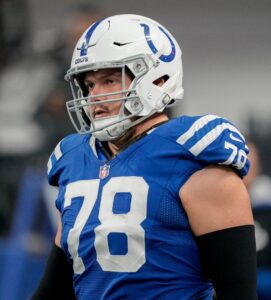 Hitting free agency as the most accomplished center available (by a wide margin), Kelly expectedly joined a contender when selecting his second career team. The four-time Pro Bowler did not see any of his 2026 salary guaranteed at signing, however, meaning the Vikings could move on after a signing season. If things go according to plan, Kelly should manage to avoid such a situation.
Hitting free agency as the most accomplished center available (by a wide margin), Kelly expectedly joined a contender when selecting his second career team. The four-time Pro Bowler did not see any of his 2026 salary guaranteed at signing, however, meaning the Vikings could move on after a signing season. If things go according to plan, Kelly should manage to avoid such a situation.
Colts general manager Chris Ballard publicly stated his intention to deviate from the team’s philosophy of largely retaining in-house players in lieu of high-priced outside additions. That helped open the door to a Kelly departure, although the 32-year-old did discuss re-signing with Indianapolis. Instead of continuing on what would have been a third Colts contract, the 121-game starter will look to upgrade – at least on a short-term basis – the center spot with Minnesota.
The possibility of Allen being released emerged this offseason, and Washington elected to part ways with the veteran D-tackle after eight years in the nation’s capital. That cost-shedding move made the two-time Pro Bowler an attractive option in free agency given his durability (up until the 2024 season) and relatively consistent production. The 49ers explored including him in the Deebo Samuel trade, but that did not come to pass. Instead of signing with San Francisco (a team which remained interested) on the open market, Allen headed to Minnesota. 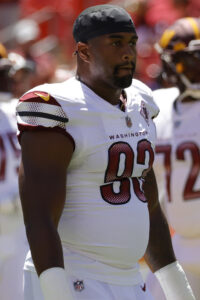
At the age of 30, concerns about a drop-off in production will be present in Allen’s case. The former first-rounder has notched at least 7.5 sacks three times in a season, but he posted 5.5 in his last full campaign and three when healthy in 2024. Allen returning to his previous form would be critical for a Vikings defensive front which has undergone a slew of changes over the past two offseasons. That would also generate financial benefits given the incentives based on playing time and sack totals present in his deal.
The 49ers’ interest in adding Allen through trade or free agency was based in part on their decision to release Hargrave. At the end of the 2024 campaign, GM John Lynch made it clear the former Steeler and Eagle would be cut with a post-June 1 designation. Hargrave earned one of his two Pro Bowl nods during his two-year stint in the Bay Area, maintaining his status as one of the league’s most disruptive interior defenders on his third team. A pectoral tear resulted in only three games played last season, however, causing the 49ers to restructure his pact before cutting ties.
The first major injury in Hargrave’s nine-year career limited his latest pact to two years, but a healthy guarantee illustrates Minnesota’s investment in his continued production for at least the immediate future. The 32-year-old has started 115 games and been on the field for no fewer than 58% of his team’s defensive snaps each season since 2019. Serving as a mainstay with the Vikings would help a defense which has ranked top-eight against the run during both of Brian Flores’ DC seasons. It could also shift how Flores operates moving forward.
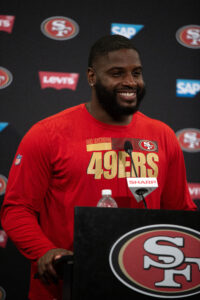 In 2023 and again in ’24, the Vikings led the NFL in blitz percentage. With an experienced tandem of Allen and Hargrave at the DT spots along with a returning top trio of edge rushers, though, Flores could rely more on four-man rushes this season in an attempt to aid Minnesota’s secondary. In any case, the team’s defense will remain a major factor in deciding whether or not the coming campaign is a success. It will still be interesting to see if a slightly different approach is explored along the way.
In 2023 and again in ’24, the Vikings led the NFL in blitz percentage. With an experienced tandem of Allen and Hargrave at the DT spots along with a returning top trio of edge rushers, though, Flores could rely more on four-man rushes this season in an attempt to aid Minnesota’s secondary. In any case, the team’s defense will remain a major factor in deciding whether or not the coming campaign is a success. It will still be interesting to see if a slightly different approach is explored along the way.
A gambling suspension sidelined Rodgers for the entire 2023 season and ended his tenure with the Colts. A one-year flier offered by the Eagles proved to be beneficial for both parties; the former sixth-rounder played a rotational role on defense while also chipping in on special teams for the Super Bowl winners. Philadelphia was interested in keeping Rodgers – especially considering Darius Slay’s release and subsequent intra-Pennsylvania move to the Steelers – but ended up losing both cover men during the spring.
A starting spot is available for Rodgers, 27, who could enjoy a notable career turnaround compared to where things stood two years ago. He and Okudah (a former No. 3 pick who has played double-digit games in a season just twice so far) could find themselves making key contributions in Minnesota’s secondary in 2025. One or both could thus prove to be effective buy-low additions from the team’s perspective.
Read more
Re-signings:
 Keeping Murphy in the fold long loomed as one of Minnesota’s top offseason priorities. An effort to work out a pact before the 2024 campaign proved unsuccessful. In such situations, free agent departures often ensue.
Keeping Murphy in the fold long loomed as one of Minnesota’s top offseason priorities. An effort to work out a pact before the 2024 campaign proved unsuccessful. In such situations, free agent departures often ensue.
However, team and player were able to continue their relationship after two seasons together. Murphy played on an average annual value of $8.75MM during his first Minnesota pact, but his decision to turn down an early extension proved worthwhile. Murphy was among a host of veteran corners who benefited from inking a short-term second contract earlier in his career; a lucrative third deal awaited.
The 27-year-old’s new AAV of $18MM is lower than originally reported, but it places Murphy in a tie for 14th among cornerbacks. Meeting the expectations associated with it will be key in determining the success of Minnesota’s secondary, a unit which did not see any headline-grabbing additions this spring.
Incentives could push this pact to $22MM annually, the inflated figure which initially emerged in Murphy’s case. Even if the former second-rounder is unable to reach that level of compensation, the fact his first two years are guaranteed at signing demonstrates the payout resulting from his strong Vikings tenure so far. A six-interception campaign in 2024 resulted in Murphy’s first career Pro Bowl nod, and a similar showing on his newest accord could yield further accolades. 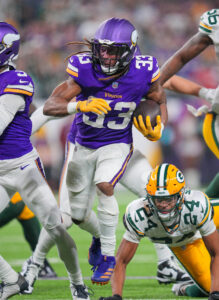
Last season also saw the Washington product set a new personal mark in passer rating allowed as the nearest defender (76.7) while splitting time between the perimeter and the slot. Flores’ unit ranked only 28th against the pass in 2024. Improving in that regard moving forward will be key, and Murphy will be counted on to serve as an anchor in the secondary on a team with which he has already enjoyed considerable success.
Jones’ free agent decision to remain in the NFC North led to a one-year Vikings pact in 2024. That accord included four void years and was originally structured to expire in mid-February, but the parties agreed to push the void date to the eve of free agency. That move hinted at a deal being worked out, and the former Packers Pro Bowler is indeed positioned to remain with one of Green Bay’s divisional rivals into his 30s. Set to turn 31 in December, Jones enters the season as the NFL’s second-oldest starting RB (behind Derrick Henry).
Handling the heaviest workload of his career (255 carries), Jones set a new highwater mark with 1,138 rushing yards in 2024. His seven total touchdowns fell well short of his best years, dating well back into his decorated Packers tenure, but the former fifth-rounder easily did enough to justify a new investment on Minnesota’s part. The trade acquisition of Jordan Mason could produce a reduction in his workload, but Jones should continue as an important member of a pass-heavy offense through this second phase of his career.
 A combined $15.25MM AAV for the Vikings’ top two backs is certainly an uptick compared to last year’s financial setup at the running back spot. If Jones can once again deliver consistent play – having averaged no less than 4.5 yards per carry in his eight-year career – though, that will likely prove to be a worthwhile investment for Minnesota as the team aims for a smooth transition with McCarthy under center.
A combined $15.25MM AAV for the Vikings’ top two backs is certainly an uptick compared to last year’s financial setup at the running back spot. If Jones can once again deliver consistent play – having averaged no less than 4.5 yards per carry in his eight-year career – though, that will likely prove to be a worthwhile investment for Minnesota as the team aims for a smooth transition with McCarthy under center.
Smith is nine games away from reaching third place in Vikings history for appearances by a defender. The six-time Pro Bowler joined cornerback Stephon Gilmore in contemplating retirement after the 2024 campaign, but his decorated career with continue for at least one more year. Smith has served as a full-time starter throughout his Minnesota tenure, which will extend to 14 years in 2025. He has missed considerable time only once during that stretch.
A number of incentives are tied to playing time and production on what will be Smith’s final contract. Void years included in the pact have allowed it to be structured in a way for the former All-Pro to retire with a post-June 1 designation for cap purposes. Before then, Smith will maintain his role as a key member of the secondary and a valued veteran relied on to help Minnesota engineer a deep playoff run.
Notable losses:
- Cam Akers, RB
- Bubba Bolden, S (waived)
- Garrett Bradbury, C (post-June 1 release)
- Jonathan Bullard, DL
- Camryn Bynum, S
- Sam Darnold, QB
- Shaquill Griffin, CB
- Matt Harmon, LB (waived)
- Marcellus Johnson, T (waived)
- Daniel Jones, QB
- Patrick Jones, OLB
- Nick Mullens, QB
- Johnny Mundt, TE
- Trevor Reid, OL (waived)
- Cam Robinson, LT
- Trent Sherfield, WR
- NaJee Thompson, CB (waived)
- Jerry Tillery, DL
- Max Tooley, LB (waived)
- David Quessenberry, T
- Jihad Ward, OLB
- Nahshon Wright, CB (released)
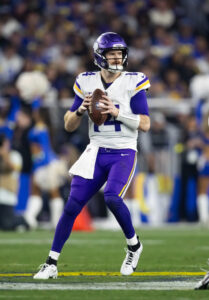 Kirk Cousins was atop PFR’s Top 50 Free Agent list in 2024, and the events of this offseason ensured a different Vikings quarterback held that same distinction for a second straight year. Darnold inked a one-year Minnesota pact coming off a 49ers tenure in which he flashed the potential to have a Baker Mayfield-like resurgence with another starting opportunity. The former Jets first-rounder was assured of the QB1 gig he entered camp with after McCarthy’s season-ending summer surgery.
Kirk Cousins was atop PFR’s Top 50 Free Agent list in 2024, and the events of this offseason ensured a different Vikings quarterback held that same distinction for a second straight year. Darnold inked a one-year Minnesota pact coming off a 49ers tenure in which he flashed the potential to have a Baker Mayfield-like resurgence with another starting opportunity. The former Jets first-rounder was assured of the QB1 gig he entered camp with after McCarthy’s season-ending summer surgery.
Kevin O’Connell has earned a reputation as a quarterback whisperer, but even with that mind, few (if any) around the league envisioned Darnold having the season he did in 2024. The 28-year-old comfortably set new career highs across the board and his 102.5 passer rating ranked sixth in the NFL. Darnold finished 10th in MVP voting to cap off a season which saw Minnesota win 14 games.
A poor performance on his part (among others) led to a Week 18 loss which cost the Vikings the NFC top seed, though, and that was followed up by a blowout wild-card loss to the Rams. Darnold took 11 total sacks between those two contests, culminating with the Rams dropping him nine times, throwing only one touchdown pass in the process.
 In the wake of that up-and-down campaign, the central question of Minnesota’s offseason arrived: what was the best course of action in Darnold’s case? A long-term contract would have (presumably) delayed McCarthy’s ascension to the starting gig while costing far more than the $10MM Darnold played for in 2024. The franchise tag loomed as a possibility given the value of another one-year commitment, but the Vikings passed on what would have been a $40.2MM investment.
In the wake of that up-and-down campaign, the central question of Minnesota’s offseason arrived: what was the best course of action in Darnold’s case? A long-term contract would have (presumably) delayed McCarthy’s ascension to the starting gig while costing far more than the $10MM Darnold played for in 2024. The franchise tag loomed as a possibility given the value of another one-year commitment, but the Vikings passed on what would have been a $40.2MM investment.
Considering that decision, it came as no surprise when a June report indicated the Vikings never submitted a multiyear offer to Darnold. The USC product understandably drew interest from numerous suitors before ultimately landing in Seattle. The Seahawks’ three-year, $105.5MM pact contains a potential out after Year 1, so his strong showing from last year did not yield a true long-term commitment. Nevertheless, Darnold did well to boost his stock during a Vikings stint which expectedly came and went in short order.
Following his midseason Giants release, Jones joined the Vikings to close out the campaign. No playing time came about as a result of the agreement, but a Minnesota re-signing remained a possibility leading up to free agency. With 69 starts to his name, the former No. 6 overall pick would have offered the team with an experienced option to back up McCarthy, but a departure represented a clearer path to a new starting opportunity.
 Indeed, Jones’ one-year Colts pact will see him spend the preseason competing with Anthony Richardson. With over $13MM guaranteed for 2025, even a backup gig will wind up being a lucrative one in his case. Winning the QB1 spot could, however, put Jones in a similar one to Darnold from last season – something which would have been nearly impossible had he stayed in Minnesota for the coming campaign.
Indeed, Jones’ one-year Colts pact will see him spend the preseason competing with Anthony Richardson. With over $13MM guaranteed for 2025, even a backup gig will wind up being a lucrative one in his case. Winning the QB1 spot could, however, put Jones in a similar one to Darnold from last season – something which would have been nearly impossible had he stayed in Minnesota for the coming campaign.
Bynum was the target of a Vikings extension push last spring, but his decision not to commit to a second contract with the team allowed him to test the open market. At 27, the deal signed this spring will be his most lucrative one, illustrating the success of the decision to wait. Bynum – just like Byron Murphy – was a target of the Raiders during the buildup to free agency. He did not sign with Vegas, but unlike in Murphy’s case a departure did take place on the open market.
A full-time starter since 2022, Bynum racked up eight interceptions and 28 pass deflections over the course of his Vikings tenure. That production will be missed (along with his choreography skills for touchdown celebrations, of course) in the team’s secondary, a unit which will face a number of questions entering the 2025 campaign. The Colts inked Bynum to a four-year, $60MM pact as part of their efforts to add high-profile outside free agents. Minnesota will look internally to replace him.
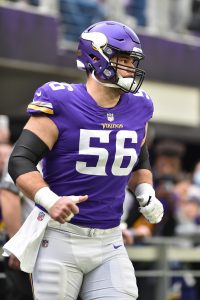 Bradbury operated as the Vikings’ center starter for each of his six years with the team. Over that span, the former first-rounder graded out as PFF’s No. 11 player at the position once (2022) and outside the top 24 every other season. Having failed to meet expectations, a parting of ways was sought out via trade. With no suitor showing much interest on that front (as expected,) the decision was made to proceed with a release.
Bradbury operated as the Vikings’ center starter for each of his six years with the team. Over that span, the former first-rounder graded out as PFF’s No. 11 player at the position once (2022) and outside the top 24 every other season. Having failed to meet expectations, a parting of ways was sought out via trade. With no suitor showing much interest on that front (as expected,) the decision was made to proceed with a release.
Bradbury, 30, represented a replacement option for David Andrews for the Patriots. A two-year pact was worked out with the NC State product, but no salary is guaranteed for 2026. Bradbury could thus prove to be a one-and-done New England starter as he looks to find a long-term NFL home during the second chapter of his career.
Robinson was acquired via trade to replace the injured Christian Darrisaw on the blind side. The move was a rental agreement given the longtime Jaguars’ LT’s status as a pending free agent. To no surprise, then, Robinson signed with the Texans in a deal which could allow him to replace Laremy Tunsil as their left tackle starter. Darrisaw, meanwhile, has been practicing since June but no timeline is in place for full clearance regarding his ACL rehab. It is thus uncertain if the recipient of a lucrative 2024 extension will be available for Week 1.
Extensions and restructures:
During his first two Vikings seasons, Metellus was strictly a special teams contributor. Over time, he took on a larger defensive workload based in large part on his versatility; the former sixth-rounder has seen notable time at both safety spots but also in the box as a dime linebacker and even on the edge in recent years. A full-time starter since 2023 despite the presence of two other established safeties, Metellus played his way into a considerable raise with his performances during Brian Flores’ tenure as defensive coordinator. 
The Michigan product’s first Minnesota extension was two years in length and carried an AAV of $4MM. That figure has tripled with this new pact, and incentives could allow Metellus to collect as much as $42MM over the coming years. As of June, it was clear a mutual desire existed in this case for a long-term arrangement to be worked out. Roughly one month later, the sides struck a deal.
Metellus’ ongoing presence will be key for the Vikings with Camryn Bynum no longer in the fold, and it will be interesting to see how his role changes moving forward. Jackson will likewise provide welcomed continuity in the secondary. The 26-year-old has yet to contribute much on defense to date, but with one safety starter out of picture that could certainly change beginning in 2025. A regular role outside of special teams duties would help Jackson’s value on a new pact in Minnesota or elsewhere down the road.
After drawing interest elsewhere in the NFC on the open market last spring, Van Ginkel elected to join the Vikings. That move reunited him with Flores (after they worked together in Miami) and paved the way for a full-time starting role. Operating with fellow free agent addition Jonathan Greenard, Van Ginkel enjoyed a career year. 11.5 sacks and a pair of pick-sixes resulted in a Pro Bowl nod, a spot on the second All-Pro team and a strong negotiating position for the 30-year-old. Halfway through his two-year pact, Van Ginkel emerged as a logical extension candidate this offseason.
 Prior to signing his new deal, the Wisconsin product was set to collect $4MM in guarantees for 2025. He has secured far more in locked-in compensation – including a $10MM signing bonus – without a long-term commitment being necessary on the part of the Vikings. Greenard has another two years with guaranteed money scheduled on his pact, so Minnesota’s post-Danielle Hunter setup along the edge will remain intact through at least the 2026 campaign.
Prior to signing his new deal, the Wisconsin product was set to collect $4MM in guarantees for 2025. He has secured far more in locked-in compensation – including a $10MM signing bonus – without a long-term commitment being necessary on the part of the Vikings. Greenard has another two years with guaranteed money scheduled on his pact, so Minnesota’s post-Danielle Hunter setup along the edge will remain intact through at least the 2026 campaign.
The tight end position is one where teams tend to only carry one notable contract at a time. Even with T.J. Hockenson already on the books at an AAV of $16.5MM, though, the Vikings authorized a raise in Oliver’s case. The former third-rounder has not developed into a notable pass-catching presence at any stop during his career. Still, a track record of being among the best run blockers at his position has been further established during Oliver’s two seasons in Minnesota; team and player will expect more of the same for years to come.
Draft:
- Round 1, No. 24: Donovan Jackson (G, Ohio State) (signed)
- Round 3, No. 102 (from Lions through Jaguars and Texans): Tai Felton (WR, Maryland) (signed)
- Round 5, No. 139 (from Browns): Tyrion Ingram-Dawkins (DT, Georgia) (signed)
- Round 6, No. 201 (from Rams): Kobe King (LB, Penn State) (signed)
- Round 6, No. 202 (from Texans through Steelers, Bears and Rams): Gavin Bartholomew (TE, Pittsburgh) (signed)
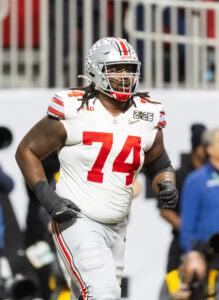 Thanks to a number of maneuvers involving future draft picks – including the move which allowed for the Dallas Turner selection last year – the Vikings found themselves short on capital in April. Much of this year’s class will depend on Jackson’s ability to develop into a long-term mainstay up front with the other rookies aiming to fill out depth roles.
Thanks to a number of maneuvers involving future draft picks – including the move which allowed for the Dallas Turner selection last year – the Vikings found themselves short on capital in April. Much of this year’s class will depend on Jackson’s ability to develop into a long-term mainstay up front with the other rookies aiming to fill out depth roles.
Each of Jackson’s first 31 starts during his college career came at left guard. Remaining on the inside would have still resulted in a relatively strong pedigree ahead of the draft, but a season-ending injury from Buckeyes left tackle Josh Simmons led to a shift up front. Jackson closed out his senior season operating on the blind side in Simmons’ place, and his success in doing so helped lead the team to a national championship.
That brief left tackle stint led some to view Jackson as a candidate to see time there at the NFL level. While the All-American could find himself doing so at some point, his focus is understandably focused on carving out a starting spot on the inside. Indeed, Jackson entered training camp as the top candidate for first-team action at the left guard position.
 Blake Brandel remains in place after he played every snap at left guard last year. With Will Fries set to handle the RG spot for the foreseeable future, however, Jackson and Brandel (on the books for two more years) will contend with one another for the other first-team guard position. If Jackson wins out, Minnesota’s renovations along the interior of the O-line will result in three new starters for 2025.
Blake Brandel remains in place after he played every snap at left guard last year. With Will Fries set to handle the RG spot for the foreseeable future, however, Jackson and Brandel (on the books for two more years) will contend with one another for the other first-team guard position. If Jackson wins out, Minnesota’s renovations along the interior of the O-line will result in three new starters for 2025.
Over the course of his four years with the Terrapins, Felton increased his production every year. That resulted in a 92-1,124-9 statline for 2024; he set a new school record in receptions as a senior and secured a third-team All-American nod along the way. A 4.37-second 40-yard dash time at the Combine helped Felton’s stock further.
The 6-1, 183-pounder will look to provide the Vikings with a deep threat as a complementary option in the passing game. The Justin Jefferson–Jordan Addison tandem will be in place once again in 2025, and tight end T.J. Hockenson figures to maintain a key role on offense as well. Felton spent much of college tenure on the outside, but he saw his workload include time in the slot as well. Versatility will be key in determining his ability to see the field as he plays out his rookie deal.
Other:
In the immediate aftermath of Minnesota’s playoff elimination, it became clear new deals for both O’Connell and Adofo-Mensah would be pursued. Hired in 2022 as rookies in their respective roles, immediate success commenced in the form of a 13-4 campaign. The Vikings went one-and-done in the postseason that year, and Cousins’ 2023 Achilles tear keyed a descent to 7-10. 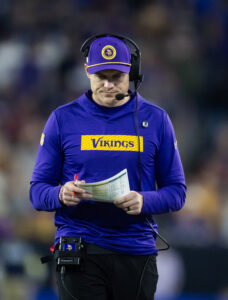
While cycling through different replacement quarterbacks following Cousins’ injury, O’Connell showcased an ability to run a functional offense with a handful of options under center. Acclaim in that respect increased further with Sam Darnold‘s impressive single-season run. Minnesota’s repeat of a quick playoff exit meant 2024 ended on a sour note, but O’Connell took home Coach of the Year honors for his regular-season success.
Already in the top half of the league in terms of the longest-tenured head coaches, the 40-year-old has delivered on the expectations of ownership to date. An effective long-term pairing with J.J. McCarthy would certainly help O’Connell’s chances of receiving another extension down the road. For now, his future is assured in advance of a critical campaign for the organization.
Likewise, Adofo-Mensah has earned the trust of ownership during his three years at the helm. The O’Connell extension also brought about news that an extension preventing lame-duck status for Adofo-Mensah, 43 was being worked on, and it was hammered out with plenty of time to spare. The former 49ers and Browns exec has overseen sweeping changes on both sides of the ball in relatively short order and constructed two rosters which have delivered double-digit wins.
 If playoff success remains elusive, criticism of Adofo-Mensah will no doubt intensify. In any event, his ability to string together successful draft classes will be critical over the coming years as Minnesota is currently projected to be well over the cap in 2026 and near the bottom of the league in space the following season. How Adofo-Mensah manages the window presented by McCarthy’s rookie contract will be key, and he will have familiar faces supporting him in the front office.
If playoff success remains elusive, criticism of Adofo-Mensah will no doubt intensify. In any event, his ability to string together successful draft classes will be critical over the coming years as Minnesota is currently projected to be well over the cap in 2026 and near the bottom of the league in space the following season. How Adofo-Mensah manages the window presented by McCarthy’s rookie contract will be key, and he will have familiar faces supporting him in the front office.
Phillips – an O’Connell colleague in Washington and with the Rams prior to their current partnership – was also approaching the final year of his deal before signing an extension. His non-play-calling role is set to continue for a fourth season and beyond. The loss of Udinski will be felt, although QBs coach Josh McCown is still in place for at least one more year. The former NFL passer drew head coaching interest from the Jets in this year’s cycle, while DC Brian Flores was among the leaders in interview requests as a sign he could depart next offseason.
Following his (expected but far-from-amicable) Jets release, Rodgers was a candidate to retire. The Vikings were on the shortlist of teams the 41-year-old considered, though, based in large part on his relationship with O’Connell. A one-year pact would have allowed for Rodgers to complete a strikingly similar career arc compared to Brett Favre and for at least two games against the division rival Packers in his final season. 
At a point when it remained unclear if he would play at all in 2025, Rodgers reportedly informed the Vikings they were his preferred destination. A signing received support from some in the organization, but in the end the Vikes joined the Giants in declining to pursue a deal. That left the Steelers as Rodgers’ last logical landing spot, and an agreement was eventually finalized. As such, Minnesota will take on the four-time MVP in Week 4 during the NFL’s first regular season game in Ireland.
Like every other decision made at the QB spot this offseason, the choice to turn aside Rodgers’ interest marked a sign of confidence in McCarthy. The 2024 national champion encountered a swelling issue in November and received a PRP injection as a result. Since then, however, McCarthy has progressed as hoped in his recovery. A full workload in spring practices along with training camp has allowed him to handle plenty of QB1 reps while attempting to make up for lost time last year.
At the age of 22, McCarthy could find himself occupying the starter’s gig for years to come if all goes well. Making it to Week 1 at full strength will of course be the top priority in his case, but the nature of his learning curve come the regular season and his ability to develop will make for an intriguing storyline all season. In the short term, at least, Minnesota’s aversion to retaining Darnold or making a notable outside addition will be tested by McCarthy’s performance.
Top 10 cap charges for 2025:
- Brian O’Neill, RT: $26.02MM
- Jonathan Greenard, DE: $22.3MM
- T.J. Hockenson, TE: $16.65MM
- Justin Jefferson, WR: $15.17MM
- Andrew Van Ginkel, OLB: $11.4MM
- Harrison Smith, S: $9.9MM
- Christian Darrisaw, LT: $9.68MM
- Harrison Phillips, DT: $9.68MM
- Aaron Jones, RB: $8.4MM
- Javon Hargrave, DT: $7.88MM
While Smith’s pact is set up for him to retire after this season, all other players listed above are on the books for 2026 as well. That should help ensure continuity at the top of the roster, although Jefferson, Darrisaw and Hargrave are each scheduled to see their cap charges spike by a margin of eight figures from one year to the next. It will be interesting to see if one or more of those deals receive attention next spring as a result.
Last season, the Vikings only lost four combined regular and postseason games to a total of two opponents. Along the way, they won eight of nine one-score contests, so regression in that regard should be expected. Provided that takes place, duplicating the success of 2024 – especially given the competitive strength of the NFC North – will be rather challenging.
Much will depend on McCarthy’s level of play, of course. Elsewhere on Minnesota’s roster, the success of this year’s investments in the trenches will be critical as well. Continuity on the sidelines and in the front office is in place, but will 2025 bring a postseason breakthrough?
 While a Deebo Samuel rumor circulated, the Steelers aimed higher. Samuel has an All-Pro season on his resume, but Metcalf has been the steadier option. The Steelers’ monthslong WR trade quest included checking in on Metcalf with the Seahawks before the 2024 deadline; Seattle balked then. Months later, Metcalf requested a trade. In the same week, Seattle unloaded 2020s pillars Metcalf and Geno Smith. The Chargers and Texans came up as preferred Metcalf destinations. The Steelers including a second-round pick in their offer sealed the deal.
While a Deebo Samuel rumor circulated, the Steelers aimed higher. Samuel has an All-Pro season on his resume, but Metcalf has been the steadier option. The Steelers’ monthslong WR trade quest included checking in on Metcalf with the Seahawks before the 2024 deadline; Seattle balked then. Months later, Metcalf requested a trade. In the same week, Seattle unloaded 2020s pillars Metcalf and Geno Smith. The Chargers and Texans came up as preferred Metcalf destinations. The Steelers including a second-round pick in their offer sealed the deal. Although short-term second contracts for Diontae Johnson and JuJu Smith-Schuster commenced, the Steelers have only awarded Antonio Brown and Hines Ward long-term deals at receiver this century. Metcalf breaks stride due to being a six-year Seahawk, but the Steelers spent most of 2024 trying to add an outside hire here. They paid up to do so a year later.
Although short-term second contracts for Diontae Johnson and JuJu Smith-Schuster commenced, the Steelers have only awarded Antonio Brown and Hines Ward long-term deals at receiver this century. Metcalf breaks stride due to being a six-year Seahawk, but the Steelers spent most of 2024 trying to add an outside hire here. They paid up to do so a year later. Omar Khan said the Cowboys reached out post-draft, and the team will pair Pickens with CeeDee Lamb. The Cowboys trading for Pickens and then unloading Micah Parsons is a rather interesting transaction log. Only going into his age-24 season, Pickens has a significant opportunity to impress after being the Steelers’ No. 1 target for much of his rookie deal. It is now quite possible he will be on a third team in three years after the 2026 free agency period, though a franchise tag — particularly with Parsons in Wisconsin — will be in play.
Omar Khan said the Cowboys reached out post-draft, and the team will pair Pickens with CeeDee Lamb. The Cowboys trading for Pickens and then unloading Micah Parsons is a rather interesting transaction log. Only going into his age-24 season, Pickens has a significant opportunity to impress after being the Steelers’ No. 1 target for much of his rookie deal. It is now quite possible he will be on a third team in three years after the 2026 free agency period, though a franchise tag — particularly with Parsons in Wisconsin — will be in play. A clash with Mike McDaniel and general discontent with the state of the Dolphins was believed to have irked Ramsey, though his reasoning for seeking an exit after two seasons is still not fully known. Despite a rumor pointing to Ramsey eyeing another West Coast move, the Steelers became a suitor.
A clash with Mike McDaniel and general discontent with the state of the Dolphins was believed to have irked Ramsey, though his reasoning for seeking an exit after two seasons is still not fully known. Despite a rumor pointing to Ramsey eyeing another West Coast move, the Steelers became a suitor. Pittsburgh gave Fitzpatrick a then-safety-record four-year, $72.99MM extension in 2022. Two years remain on the deal. The Steelers took on just $6.86MM in dead money by dealing the eighth-year vet. Lower-cost cogs DeShon Elliott and Juan Thornhill are set to work as the first-string safeties. This could bring a substantial downgrade, but the expected cornerback improvement may offset it to a degree.
Pittsburgh gave Fitzpatrick a then-safety-record four-year, $72.99MM extension in 2022. Two years remain on the deal. The Steelers took on just $6.86MM in dead money by dealing the eighth-year vet. Lower-cost cogs DeShon Elliott and Juan Thornhill are set to work as the first-string safeties. This could bring a substantial downgrade, but the expected cornerback improvement may offset it to a degree. The cost of Watt’s extension began to rise when Maxx Crosby started the offseason edge rusher market boom, but the price crystalized after the Browns convinced Myles Garrett to rescind his trade request with a $40MM-per-year extension. While Garrett’s deal reset the market, the Steelers were smart to hammer out a Watt deal when they did. Had Pittsburgh waited until September like they did in 2021, the contract would assuredly have been pricier thanks to the Packers’ Micah Parsons windfall.
The cost of Watt’s extension began to rise when Maxx Crosby started the offseason edge rusher market boom, but the price crystalized after the Browns convinced Myles Garrett to rescind his trade request with a $40MM-per-year extension. While Garrett’s deal reset the market, the Steelers were smart to hammer out a Watt deal when they did. Had Pittsburgh waited until September like they did in 2021, the contract would assuredly have been pricier thanks to the Packers’ Micah Parsons windfall. McBride, 25, has proven to be more than worth the $19MM-per-year price tag after finishing just one catch (111) and 48 yards (1,146) short of matching the totals of the league’s leading tight end in both stats. The TE market remains south of the $20MM-per-year place, even as WR salaries are now past $40MM AAV, but McBride set the table for such a breakthrough after his strong third season.
McBride, 25, has proven to be more than worth the $19MM-per-year price tag after finishing just one catch (111) and 48 yards (1,146) short of matching the totals of the league’s leading tight end in both stats. The TE market remains south of the $20MM-per-year place, even as WR salaries are now past $40MM AAV, but McBride set the table for such a breakthrough after his strong third season.
 Joining Campbell on the line are top signees Sweat and Tomlinson. Sweat arrives in Arizona after seven years in Philadelphia, where he had established himself as a full-time starter after earning a three-year, $40MM extension and collected 43 sacks in his final six years with the team after going sackless as a rookie.
Joining Campbell on the line are top signees Sweat and Tomlinson. Sweat arrives in Arizona after seven years in Philadelphia, where he had established himself as a full-time starter after earning a three-year, $40MM extension and collected 43 sacks in his final six years with the team after going sackless as a rookie. Before becoming a Brown, though, Tomlinson routinely graded out as a top-25 interior defensive lineman in the NFL. The new one-two of Campbell and Tomlinson in the middle with Sweat and Robinson on the ends should make for a formidable new-look unit.
Before becoming a Brown, though, Tomlinson routinely graded out as a top-25 interior defensive lineman in the NFL. The new one-two of Campbell and Tomlinson in the middle with Sweat and Robinson on the ends should make for a formidable new-look unit. Brissett seems to be the latest entry into the journeyman emergency starter archetype. Like those who came before him — Ryan Fitzpatrick, Josh McCown, Vinny Testaverde — he comes to town with multiple years of experience as a full-time starter and double-digit starts for the Browns and/or Jets.
Brissett seems to be the latest entry into the journeyman emergency starter archetype. Like those who came before him — Ryan Fitzpatrick, Josh McCown, Vinny Testaverde — he comes to town with multiple years of experience as a full-time starter and double-digit starts for the Browns and/or Jets. A few months later, Licht expressed a desire to keep Mayfield past the end of his contract in 2026, but no extension materialized. Instead, Tampa Bay converted $30MM of his 2026 salary into two roster bonuses.
A few months later, Licht expressed a desire to keep Mayfield past the end of his contract in 2026, but no extension materialized. Instead, Tampa Bay converted $30MM of his 2026 salary into two roster bonuses.
 The only other starter signed in free agency was veteran punter Riley Dixon. The Buccaneers cycled through three punters in 2024, none of whom cleared 40 net yards per punt, so they opted for reliability in the 32-year-old Dixon. The 10th-year veteran’s fully guaranteed $3MM deal quickly looked like an excellent value after the positional market eclipsed $4MM later in the offseason. He will look to add some consistency to Tampa Bay’s special teams operations this year.
The only other starter signed in free agency was veteran punter Riley Dixon. The Buccaneers cycled through three punters in 2024, none of whom cleared 40 net yards per punt, so they opted for reliability in the 32-year-old Dixon. The 10th-year veteran’s fully guaranteed $3MM deal quickly looked like an excellent value after the positional market eclipsed $4MM later in the offseason. He will look to add some consistency to Tampa Bay’s special teams operations this year. Godwin started the 2024 season on pace for a career year before a dislocated ankle in Week 7 forced him to undergo season-ending surgery. At the time of the injury, Godwin’s 576 yards ranked second in the NFL. Despite an uncertain return timeline, he was expected to draw heavy interest in free agency, even with several other well-regarded veterans hitting the market. A February agreement to delay the void date on Godwin’s contract was an early sign that he would stay in Tampa Bay, but the Patriots and the Steelers — among other teams — tried to change his mind.
Godwin started the 2024 season on pace for a career year before a dislocated ankle in Week 7 forced him to undergo season-ending surgery. At the time of the injury, Godwin’s 576 yards ranked second in the NFL. Despite an uncertain return timeline, he was expected to draw heavy interest in free agency, even with several other well-regarded veterans hitting the market. A February agreement to delay the void date on Godwin’s contract was an early sign that he would stay in Tampa Bay, but the Patriots and the Steelers — among other teams — tried to change his mind.  Denver discussed Sutton in 2022 deals and dangled him during the ensuing offseason, with Baltimore talks nearly producing a March 2023 swap. Odell Beckham Jr.‘s Ravens interest may have changed the Broncos’ WR plans, as the AFC North team backed off Sutton. The Broncos had sought a second-round pick for the 2018 second-rounder and a first for Jeudy, but they ended up selling low on Jeudy (fifth- and sixth-rounders) in March 2024. The Broncos stuck with Sutton and prioritized him to the point they declined a third-round offer from the 49ers, who would have added Sutton as part of a three-team Brandon Aiyuk trade with the Steelers in August 2024.
Denver discussed Sutton in 2022 deals and dangled him during the ensuing offseason, with Baltimore talks nearly producing a March 2023 swap. Odell Beckham Jr.‘s Ravens interest may have changed the Broncos’ WR plans, as the AFC North team backed off Sutton. The Broncos had sought a second-round pick for the 2018 second-rounder and a first for Jeudy, but they ended up selling low on Jeudy (fifth- and sixth-rounders) in March 2024. The Broncos stuck with Sutton and prioritized him to the point they declined a third-round offer from the 49ers, who would have added Sutton as part of a three-team Brandon Aiyuk trade with the Steelers in August 2024. Sutton, 29, admitted he left a bit on the table to help the Broncos extend teammates. It is unlikely he left too much, but the Broncos had a complex task in completing a fair deal with a player 2-for-7 in 1,000-yard seasons — with QB play largely contributing on that end. Sutton also observed the Broncos pass on adding a No. 1-type wideout this offseason, strengthening his leverage. But a compromise figures to benefit the Broncos, who only guaranteed $1MM of Sutton’s money beyond 2026. It would cost the Broncos $15.85MM (due to two void years) to escape the contract in 2027; that number drops to $9.78MM in 2028 — which would be Sutton’s age-32 season.
Sutton, 29, admitted he left a bit on the table to help the Broncos extend teammates. It is unlikely he left too much, but the Broncos had a complex task in completing a fair deal with a player 2-for-7 in 1,000-yard seasons — with QB play largely contributing on that end. Sutton also observed the Broncos pass on adding a No. 1-type wideout this offseason, strengthening his leverage. But a compromise figures to benefit the Broncos, who only guaranteed $1MM of Sutton’s money beyond 2026. It would cost the Broncos $15.85MM (due to two void years) to escape the contract in 2027; that number drops to $9.78MM in 2028 — which would be Sutton’s age-32 season. In addition to his $44.5MM guaranteed at signing, Allen will see $15.75MM of his 2027 base salary shift from an injury guarantee to a full guarantee in March 2026. This contract structure reminds of Mike McGlinchey‘s, which provided the right tackle a Year 3 guarantee that vested early in Year 2. The deal effectively locks Allen in through at least his age-30 season, and this partnership will probably extend beyond Sutton’s due to age.
In addition to his $44.5MM guaranteed at signing, Allen will see $15.75MM of his 2027 base salary shift from an injury guarantee to a full guarantee in March 2026. This contract structure reminds of Mike McGlinchey‘s, which provided the right tackle a Year 3 guarantee that vested early in Year 2. The deal effectively locks Allen in through at least his age-30 season, and this partnership will probably extend beyond Sutton’s due to age. Hufanga and Greenlaw brought difficulty when compiling this year’s PFR Top 50; injury issues clouded both ex-San Francisco stalwarts’ markets. Hufanga (No. 30 in our annual value-based rankings) received more interest; Greenlaw (No. 40) still commanded plenty despite missing almost all of last season with the Achilles tear that may or may not have swung Super Bowl LVIII.
Hufanga and Greenlaw brought difficulty when compiling this year’s PFR Top 50; injury issues clouded both ex-San Francisco stalwarts’ markets. Hufanga (No. 30 in our annual value-based rankings) received more interest; Greenlaw (No. 40) still commanded plenty despite missing almost all of last season with the Achilles tear that may or may not have swung Super Bowl LVIII. Not featuring much in the way of reliable linebacking play since the Super Bowl 50 Danny Trevathan–Brandon Marshall combo, the Broncos will hope they do not have to consider escaping that 2026 Greenlaw guarantee next March. Greenlaw, 28, would fill the key need on Denver’s defense; he graded as Pro Football Focus’ No. 9 overall off-ball LB in 2022 and 23rd in 2023 (247 combined tackles, eight TFLs).
Not featuring much in the way of reliable linebacking play since the Super Bowl 50 Danny Trevathan–Brandon Marshall combo, the Broncos will hope they do not have to consider escaping that 2026 Greenlaw guarantee next March. Greenlaw, 28, would fill the key need on Denver’s defense; he graded as Pro Football Focus’ No. 9 overall off-ball LB in 2022 and 23rd in 2023 (247 combined tackles, eight TFLs). Tight end probably loomed as Denver’s biggest need; fortunately, Jacksonville sent a proven option to the market during Liam Coen‘s first weeks on the job. The Broncos have been unable to replace Noah Fant since his inclusion in the Wilson trade. Greg Dulcich did not pan out, and over the past two years, no Bronco tight end has eclipsed 205 receiving yards in a season. Last year, top TE Adam Trautman accumulated just 188. Engram is set to turn 31 in September, but he will be a massive upgrade on what the Broncos had been deploying post-Fant.
Tight end probably loomed as Denver’s biggest need; fortunately, Jacksonville sent a proven option to the market during Liam Coen‘s first weeks on the job. The Broncos have been unable to replace Noah Fant since his inclusion in the Wilson trade. Greg Dulcich did not pan out, and over the past two years, no Bronco tight end has eclipsed 205 receiving yards in a season. Last year, top TE Adam Trautman accumulated just 188. Engram is set to turn 31 in September, but he will be a massive upgrade on what the Broncos had been deploying post-Fant. Playing on a Lions-designed deal ($27MM per year) during the Rams’ Super Bowl-winning season, Stafford signed a four-year, $160MM extension. At the time, Stafford left money on the table to help the Rams remain a contender. The team then rewarded Super Bowl heroes Aaron Donald and Cooper Kupp later in 2022. Stafford, however, regretted this decision and pushed for better terms in 2024 and ’25.
Playing on a Lions-designed deal ($27MM per year) during the Rams’ Super Bowl-winning season, Stafford signed a four-year, $160MM extension. At the time, Stafford left money on the table to help the Rams remain a contender. The team then rewarded Super Bowl heroes Aaron Donald and Cooper Kupp later in 2022. Stafford, however, regretted this decision and pushed for better terms in 2024 and ’25. With Stafford lacking a no-trade clause, the Rams also held the hammer here. Sean McVay represented a draw as well, and the ninth-year Rams HC remained in contact with Stafford throughout the process. In the end, a predictable conclusion emerged. Stafford did not take a late-career risk of joining teams much farther away from the Super Bowl-contending level, and the Rams fully guaranteed his 2025 salary while dangling a guarantee carrot for 2026. Though, Stafford remaining on the roster by that March 2026 vesting date suddenly looks hazier.
With Stafford lacking a no-trade clause, the Rams also held the hammer here. Sean McVay represented a draw as well, and the ninth-year Rams HC remained in contact with Stafford throughout the process. In the end, a predictable conclusion emerged. Stafford did not take a late-career risk of joining teams much farther away from the Super Bowl-contending level, and the Rams fully guaranteed his 2025 salary while dangling a guarantee carrot for 2026. Though, Stafford remaining on the roster by that March 2026 vesting date suddenly looks hazier. A back injury cropped up early in training camp, keeping Stafford off the field for multiple weeks. This included missing two joint practices. A report of a disk issue soon surfaced, as Stafford received an epidural injection, and the Rams continued to push back their fifth-year QB’s return date.
A back injury cropped up early in training camp, keeping Stafford off the field for multiple weeks. This included missing two joint practices. A report of a disk issue soon surfaced, as Stafford received an epidural injection, and the Rams continued to push back their fifth-year QB’s return date. With the cap at $177.2MM in 2018 (compared to $279.2MM today), the Rams gave Gurley a four-year, $57.5MM extension that came with $21.95MM at signing. Williams has not proven to be in that class, but the Notre Dame alum has been a quality starter. Williams, 25 next week, led the NFL with 95.3 rushing yards per game in 2023 and delivered a career-high 1,299 on the ground last season. The Rams had not seen enough from Akers or Darrell Henderson to pay them between their 2020 Gurley cut and Williams’ extension eligibility, but they have reinvested in the position on a more careful contract. The team was unwilling to go toward a top-market deal here.
With the cap at $177.2MM in 2018 (compared to $279.2MM today), the Rams gave Gurley a four-year, $57.5MM extension that came with $21.95MM at signing. Williams has not proven to be in that class, but the Notre Dame alum has been a quality starter. Williams, 25 next week, led the NFL with 95.3 rushing yards per game in 2023 and delivered a career-high 1,299 on the ground last season. The Rams had not seen enough from Akers or Darrell Henderson to pay them between their 2020 Gurley cut and Williams’ extension eligibility, but they have reinvested in the position on a more careful contract. The team was unwilling to go toward a top-market deal here. Adams grew to loathe his first post-high school experience of catching passes from quarterbacks not named Derek Carr or Aaron Rodgers, but the California native became intrigued by a move back west after his Jets stop. The Rams convinced the decorated wide receiver to replace Cooper Kupp alongside Puka Nacua. Adams is a year older than Kupp but has been far more durable, and the Rams will at least try him out — for a hefty sum — for a season.
Adams grew to loathe his first post-high school experience of catching passes from quarterbacks not named Derek Carr or Aaron Rodgers, but the California native became intrigued by a move back west after his Jets stop. The Rams convinced the decorated wide receiver to replace Cooper Kupp alongside Puka Nacua. Adams is a year older than Kupp but has been far more durable, and the Rams will at least try him out — for a hefty sum — for a season. Naturally, the Rams were also connected to Rodgers. In what would have been a third Rodgers-Adams partnership, the Rams discussed the aging great as a contingency plan in case they followed through with a Stafford trade. Rodgers, who lives in California during the offseason, was open to taking a discount to play for McVay. Stafford staying forced the four-time MVP to look elsewhere, and he ended up in Pittsburgh (on a one-year, $14.15MM deal) just before minicamp.
Naturally, the Rams were also connected to Rodgers. In what would have been a third Rodgers-Adams partnership, the Rams discussed the aging great as a contingency plan in case they followed through with a Stafford trade. Rodgers, who lives in California during the offseason, was open to taking a discount to play for McVay. Stafford staying forced the four-time MVP to look elsewhere, and he ended up in Pittsburgh (on a one-year, $14.15MM deal) just before minicamp.
 Hobbs saw time on the perimeter while playing out his rookie contract, but the Raiders primarily deployed him in the slot. The former fifth-rounder is expected to be used in both capacities with his new team, one which enters the season with questions in the secondary. Hobbs, 26, missed a total of 17 games across his four Raiders campaigns. In addition to high-end play, availability will be a central goal over the coming years in his case as a result.
Hobbs saw time on the perimeter while playing out his rookie contract, but the Raiders primarily deployed him in the slot. The former fifth-rounder is expected to be used in both capacities with his new team, one which enters the season with questions in the secondary. Hobbs, 26, missed a total of 17 games across his four Raiders campaigns. In addition to high-end play, availability will be a central goal over the coming years in his case as a result.
 As soon as the Nate Hobbs signing took place, the chances of an Alexander departure increased. The latter spent his first seven years in Green Bay, landing what was at signing a market-topping cornerback extension based on his early play. Considerable missed time increasingly became a problem in Alexander’s case, however.
As soon as the Nate Hobbs signing took place, the chances of an Alexander departure increased. The latter spent his first seven years in Green Bay, landing what was at signing a market-topping cornerback extension based on his early play. Considerable missed time increasingly became a problem in Alexander’s case, however.
 Myers represents the most notable loss on offense. A 56-game starter with Green Bay, his preference was to remain in place on his second contract. Instead, a departure took place by means of a Jets deal which may not result in the starting gig. Myers, 27, ranked between 26th and 38th in terms of center PFF grades during his Packers tenure. The team will aim for improvement with its new arrangement up front.
Myers represents the most notable loss on offense. A 56-game starter with Green Bay, his preference was to remain in place on his second contract. Instead, a departure took place by means of a Jets deal which may not result in the starting gig. Myers, 27, ranked between 26th and 38th in terms of center PFF grades during his Packers tenure. The team will aim for improvement with its new arrangement up front. Allen’s new contract is more of a lucrative rework than a true extension. Only two new years are included; the QB is now tied to the Bills through the 2030 season. But the Bills rewarded their franchise cornerstone with a massive guarantee influx. Allen, 28, received what amounts to a $90MM raise on his previous deal. The fully guaranteed money represented the lead item here. Allen’s $147MM figure is well south of Deshaun Watson‘s $230MM, but this contract beats every other deal in terms of fully guaranteed money. Although Allen could not catch Dak Prescott‘s massive $60MM-AAV accord — one achieved with far more leverage than the Bills QB carried — he topped the Cowboys passer in upfront guarantees.
Allen’s new contract is more of a lucrative rework than a true extension. Only two new years are included; the QB is now tied to the Bills through the 2030 season. But the Bills rewarded their franchise cornerstone with a massive guarantee influx. Allen, 28, received what amounts to a $90MM raise on his previous deal. The fully guaranteed money represented the lead item here. Allen’s $147MM figure is well south of Deshaun Watson‘s $230MM, but this contract beats every other deal in terms of fully guaranteed money. Although Allen could not catch Dak Prescott‘s massive $60MM-AAV accord — one achieved with far more leverage than the Bills QB carried — he topped the Cowboys passer in upfront guarantees. The Bills have continued to receive full participation from their dual-threat dynamo, despite regular punishment on scrambles and designed runs. Allen has logged 759 regular-season carries and 112 more in the playoffs, signing up for hits Jackson deftly avoids in the process. Obviously important as a passer, Allen’s run-game prowess separates him as an all-time talent. Allen already ranks sixth in career QB carries; he will move into fourth early this season. While the Bills may need to rein in their do-it-all player on that front at some point to ensure he remains elite through the duration of this contract, the franchise is enjoying the spoils of its two-trade-up 2018 presently.
The Bills have continued to receive full participation from their dual-threat dynamo, despite regular punishment on scrambles and designed runs. Allen has logged 759 regular-season carries and 112 more in the playoffs, signing up for hits Jackson deftly avoids in the process. Obviously important as a passer, Allen’s run-game prowess separates him as an all-time talent. Allen already ranks sixth in career QB carries; he will move into fourth early this season. While the Bills may need to rein in their do-it-all player on that front at some point to ensure he remains elite through the duration of this contract, the franchise is enjoying the spoils of its two-trade-up 2018 presently. The 2024 running back resurgence did bring a market reset, thanks to Saquon Barkley‘s otherworldly season, and Derrick Henry receiving $25MM guaranteed at signing despite being 31. Beyond those Hall of Fame-caliber talents, no true shift occurred. Last fall established a second tier at the position, with James Conner, Chuba Hubbard and David Montgomery following Rhamondre Stevenson in landing extensions between $8.3MM and $9.5MM per year. Alvin Kamara‘s third Saints contract came in at $12.25MM AAV. This offseason brought two notable deals in between those goalposts.
The 2024 running back resurgence did bring a market reset, thanks to Saquon Barkley‘s otherworldly season, and Derrick Henry receiving $25MM guaranteed at signing despite being 31. Beyond those Hall of Fame-caliber talents, no true shift occurred. Last fall established a second tier at the position, with James Conner, Chuba Hubbard and David Montgomery following Rhamondre Stevenson in landing extensions between $8.3MM and $9.5MM per year. Alvin Kamara‘s third Saints contract came in at $12.25MM AAV. This offseason brought two notable deals in between those goalposts. Cook and Shakir have been Allen’s steadiest weapons since Joe Brady replaced Ken Dorsey as OC midway through the 2023 season. While Stefon Diggs disappointed to close that campaign, Shakir emerged as a reliable target and developed further in 2024. The slot cog led a more egalitarian Bills pass-catching corps with 821 receiving yards. Seventy-six catches and four touchdowns to go with that yardage total did not provide Diggs-level numbers, but Shakir was not asked for such contributions. The extension reflects such a role.
Cook and Shakir have been Allen’s steadiest weapons since Joe Brady replaced Ken Dorsey as OC midway through the 2023 season. While Stefon Diggs disappointed to close that campaign, Shakir emerged as a reliable target and developed further in 2024. The slot cog led a more egalitarian Bills pass-catching corps with 821 receiving yards. Seventy-six catches and four touchdowns to go with that yardage total did not provide Diggs-level numbers, but Shakir was not asked for such contributions. The extension reflects such a role. Of the Shakir-Bernard-Rousseau-Benford quartet, Bernard did the best in terms of AAV at his position. His $10.5MM number still ranks only 12th among off-ball ‘backers, marking what looks like another solid compromise from the Bills. This deal reminds of Milano’s second contract (in 2021), but with the cap spiking by nearly $100MM since that offseason, Bernard’s is a much team-friendlier agreement. The Bills also did not guarantee any money beyond 2026, giving them an easy out — in the event this bet on an ascending player fails — by 2027.
Of the Shakir-Bernard-Rousseau-Benford quartet, Bernard did the best in terms of AAV at his position. His $10.5MM number still ranks only 12th among off-ball ‘backers, marking what looks like another solid compromise from the Bills. This deal reminds of Milano’s second contract (in 2021), but with the cap spiking by nearly $100MM since that offseason, Bernard’s is a much team-friendlier agreement. The Bills also did not guarantee any money beyond 2026, giving them an easy out — in the event this bet on an ascending player fails — by 2027. Identifying Cook, Shakir, Bernard and Rousseau as core players to extend, the Bills included Benford in that group after he had taken the longest road to such status. Chosen in the same 2022 draft as first-rounder Kaiir Elam, Benford quickly showed he was the better player. Also coming from Division I-FCS (Villanova), Benford entered his rookie season with minimal fanfare. But Benford earned a starting gig early, giving Tre’Davious White more time to rehab his first major injury. When the Bills acquired Rasul Douglas at the 2023 deadline, it was to give them an answer opposite Benford, not Elam.
Identifying Cook, Shakir, Bernard and Rousseau as core players to extend, the Bills included Benford in that group after he had taken the longest road to such status. Chosen in the same 2022 draft as first-rounder Kaiir Elam, Benford quickly showed he was the better player. Also coming from Division I-FCS (Villanova), Benford entered his rookie season with minimal fanfare. But Benford earned a starting gig early, giving Tre’Davious White more time to rehab his first major injury. When the Bills acquired Rasul Douglas at the 2023 deadline, it was to give them an answer opposite Benford, not Elam. Despite his ill-timed absences, Benford secured what is now an upper-middle-class CB extension. Buffalo’s Benford deal came after both Jaycee Horn and Derek Stingley Jr. raised the market’s ceiling, but the team still has its top cover man tied to the 19th-most lucrative CB contract. Benford, 25 in September, likely would have done better by waiting until free agency (or a franchise tag). But the Bills, continuing their offseason theme, convinced him to re-up early.
Despite his ill-timed absences, Benford secured what is now an upper-middle-class CB extension. Buffalo’s Benford deal came after both Jaycee Horn and Derek Stingley Jr. raised the market’s ceiling, but the team still has its top cover man tied to the 19th-most lucrative CB contract. Benford, 25 in September, likely would have done better by waiting until free agency (or a franchise tag). But the Bills, continuing their offseason theme, convinced him to re-up early. More undercard (to the extension cycle’s main event) in this Bills offseason, free agency still brought some important additions. The three most significant came from Los Angeles.
More undercard (to the extension cycle’s main event) in this Bills offseason, free agency still brought some important additions. The three most significant came from Los Angeles. The latest Ramsey chapter of discontent emerged in April, when the Dolphins and the aging defender agreed to pursue a trade. This came months after Grier had signed off on a market-topping extension, representing the second time Ramsey had become the top CB earner.
The latest Ramsey chapter of discontent emerged in April, when the Dolphins and the aging defender agreed to pursue a trade. This came months after Grier had signed off on a market-topping extension, representing the second time Ramsey had become the top CB earner. While the buildup did not look great for the Dolphins, Grier crafted an interesting solution. The Dolphins agreed to pay $7MM of Ramsey’s 2025 compensation, sweetening the deal for the Steelers, who are paying nearly $20MM to the soon-to-be 31-year-old CB. This was a somewhat surprising salary split, but the Dolphins took on more money by reacquiring Fitzpatrick. That became the most fascinating component of that two-trade day, seeing as the Dolphins — in Grier’s first months as a GM with roster control — traded Fitzpatrick early in his second season.
While the buildup did not look great for the Dolphins, Grier crafted an interesting solution. The Dolphins agreed to pay $7MM of Ramsey’s 2025 compensation, sweetening the deal for the Steelers, who are paying nearly $20MM to the soon-to-be 31-year-old CB. This was a somewhat surprising salary split, but the Dolphins took on more money by reacquiring Fitzpatrick. That became the most fascinating component of that two-trade day, seeing as the Dolphins — in Grier’s first months as a GM with roster control — traded Fitzpatrick early in his second season. As a Dolphins rookie in 2018, Fitzpatrick primarily played corner. He rotated between the boundary and the slot, playing more inside. That will not be his role this time around. Set to deploy Fitzpatrick at safety, the Dolphins also reworked his contract.
As a Dolphins rookie in 2018, Fitzpatrick primarily played corner. He rotated between the boundary and the slot, playing more inside. That will not be his role this time around. Set to deploy Fitzpatrick at safety, the Dolphins also reworked his contract. Waller, 33 next month, retired last summer after rumors pointed to an exit for weeks. The former Raiders Pro Bowler burned the Giants, having sustained another hamstring injury (leading to a five-game absence) and retired after the 2024 draft. No word about a Waller comeback had surfaced, but after the Dolphins acquired his rights via the pick-swap trade, Waller let it be known he wanted to play in Miami or stay retired.
Waller, 33 next month, retired last summer after rumors pointed to an exit for weeks. The former Raiders Pro Bowler burned the Giants, having sustained another hamstring injury (leading to a five-game absence) and retired after the 2024 draft. No word about a Waller comeback had surfaced, but after the Dolphins acquired his rights via the pick-swap trade, Waller let it be known he wanted to play in Miami or stay retired. Originally a waiver claim (from the Ravens) in December 2019, Sieler arrived to close out Grier’s first year as the team’s front office boss. Sieler operated as more of a Christian Wilkins sidekick from 2020-22, and the Dolphins did well to extend him at what turned out to be a below-market rate. Paying Sieler before being unable to come to terms with Wilkins, Miami observed its waiver-claim find combine for 24 TFLs over the past two seasons.
Originally a waiver claim (from the Ravens) in December 2019, Sieler arrived to close out Grier’s first year as the team’s front office boss. Sieler operated as more of a Christian Wilkins sidekick from 2020-22, and the Dolphins did well to extend him at what turned out to be a below-market rate. Paying Sieler before being unable to come to terms with Wilkins, Miami observed its waiver-claim find combine for 24 TFLs over the past two seasons. The Dolphins included incentives in Chubb’s rework, and since the former top-five pick missed all of last season, the escalators will be considered not likely to be earned — thus giving Miami 2025 cap relief. Chubb’s cap hit is down to $12.33MM. The two-time Pro Bowler is on track to return for the Dolphins, who have EDGE questions but more depth at the position compared to their Chubb- and (largely) Phillips-less 2024. Phillips, who suffered an ACL tear early last season, also avoided the active/PUP list ahead of training camp.
The Dolphins included incentives in Chubb’s rework, and since the former top-five pick missed all of last season, the escalators will be considered not likely to be earned — thus giving Miami 2025 cap relief. Chubb’s cap hit is down to $12.33MM. The two-time Pro Bowler is on track to return for the Dolphins, who have EDGE questions but more depth at the position compared to their Chubb- and (largely) Phillips-less 2024. Phillips, who suffered an ACL tear early last season, also avoided the active/PUP list ahead of training camp. After Isaiah Wynn joined Bradley Chubb in seeing a 2023 injury cost him the full 2024 season, the Dolphins retooled with a player who missed most of that campaign. Daniels would have been a less affordable option had he not suffered an Achilles tear in Week 4. While this is technically a three-year deal, it is more of a “prove it” pact due to its structure.
After Isaiah Wynn joined Bradley Chubb in seeing a 2023 injury cost him the full 2024 season, the Dolphins retooled with a player who missed most of that campaign. Daniels would have been a less affordable option had he not suffered an Achilles tear in Week 4. While this is technically a three-year deal, it is more of a “prove it” pact due to its structure. The Jets saw a failure to add a veteran behind Aaron Rodgers prove costly in 2023, as Wilson’s reset program returned to center stage. Tua Tagovailoa‘s unreliability makes this situation resemble the Jets’ 2023 blueprint, but Wilson having shown more evidence in incapability that year makes this Miami setup perhaps even shakier.
The Jets saw a failure to add a veteran behind Aaron Rodgers prove costly in 2023, as Wilson’s reset program returned to center stage. Tua Tagovailoa‘s unreliability makes this situation resemble the Jets’ 2023 blueprint, but Wilson having shown more evidence in incapability that year makes this Miami setup perhaps even shakier. Regularly labeled a modest talent in a great system, Purdy has operated on a higher level compared to Jimmy Garoppolo — a player the 49ers once re-signed at a top-market rate. That ignited what had been a slower-moving QB market in 2018, and passers continue to benefit. Because of the struggles the 2021 and ’22 QB draftees have faced, Purdy stood as the only contract-year passer to monitor regarding a blockbuster payday this offseason.
Regularly labeled a modest talent in a great system, Purdy has operated on a higher level compared to Jimmy Garoppolo — a player the 49ers once re-signed at a top-market rate. That ignited what had been a slower-moving QB market in 2018, and passers continue to benefit. Because of the struggles the 2021 and ’22 QB draftees have faced, Purdy stood as the only contract-year passer to monitor regarding a blockbuster payday this offseason. Purdy secured a Mahomes-like rolling guarantee structure. A $55.1MM 2028 payout will become guaranteed April 1, 2027, per OverTheCap. The 49ers are due to pay out a $7.2MM guarantee for 2029 on April 1, 2028. These key dates follow a $100MM at-signing guarantee. Purdy’s $165.1MM cash flow through four years betters Jared Goff‘s number, even if the Lions QB has Purdy’s deal beat at the second- and third-year marks.
Purdy secured a Mahomes-like rolling guarantee structure. A $55.1MM 2028 payout will become guaranteed April 1, 2027, per OverTheCap. The 49ers are due to pay out a $7.2MM guarantee for 2029 on April 1, 2028. These key dates follow a $100MM at-signing guarantee. Purdy’s $165.1MM cash flow through four years betters Jared Goff‘s number, even if the Lions QB has Purdy’s deal beat at the second- and third-year marks. Purdy’s payday came after Kittle inked his third contract. Having built a Hall of Fame resume, Kittle was still unable to move the tight end position past $20MM per year. The 49ers handed their all-around TE dynamo an extension weeks after Ja’Marr Chase elevated the WR ceiling to $40.25MM, it is certainly interesting the NFL keeps valuing top TEs far lower than high-end WR2s.
Purdy’s payday came after Kittle inked his third contract. Having built a Hall of Fame resume, Kittle was still unable to move the tight end position past $20MM per year. The 49ers handed their all-around TE dynamo an extension weeks after Ja’Marr Chase elevated the WR ceiling to $40.25MM, it is certainly interesting the NFL keeps valuing top TEs far lower than high-end WR2s. Purdy’s extension influenced the 49ers in free agency, which included far more notable losses than additions, but the team’s Dre Greenlaw‘s price point probably pertained to Warner’s future. Unlike Shaquille Leonard, Warner has stayed healthy after resetting the off-ball LB market in 2021. The 49ers rewarded him by ending Roquan Smith‘s two-year run atop the market.
Purdy’s extension influenced the 49ers in free agency, which included far more notable losses than additions, but the team’s Dre Greenlaw‘s price point probably pertained to Warner’s future. Unlike Shaquille Leonard, Warner has stayed healthy after resetting the off-ball LB market in 2021. The 49ers rewarded him by ending Roquan Smith‘s two-year run atop the market. While the 49ers continue to build around Super Bowl LIV starters Kittle and Warner, they separated from another by making Samuel part of this offseason’s first trade. The $30MM-per-year Aiyuk extension pointed to Samuel being trade bait this offseason, and while the 49ers expressed some hope they could keep their five-year receiving duo together, they quickly pivoted to letting his camp find a trade partner. As it turned out, only one truly emerged.
While the 49ers continue to build around Super Bowl LIV starters Kittle and Warner, they separated from another by making Samuel part of this offseason’s first trade. The $30MM-per-year Aiyuk extension pointed to Samuel being trade bait this offseason, and while the 49ers expressed some hope they could keep their five-year receiving duo together, they quickly pivoted to letting his camp find a trade partner. As it turned out, only one truly emerged. The 2019 second-round pick did make important contributions during the 49ers’ four NFC championship game journeys, but the team sold low and has Ricky Pearsall‘s rookie deal — and a low-cost Jauan Jennings contract, much to the ascendant WR’s chagrin — complementing Aiyuk’s top-10 WR terms. Though, the 49ers continue to have persistent trouble keeping their top wideouts healthy. That has continued during training camp.
The 2019 second-round pick did make important contributions during the 49ers’ four NFC championship game journeys, but the team sold low and has Ricky Pearsall‘s rookie deal — and a low-cost Jauan Jennings contract, much to the ascendant WR’s chagrin — complementing Aiyuk’s top-10 WR terms. Though, the 49ers continue to have persistent trouble keeping their top wideouts healthy. That has continued during training camp. The 49ers have Huff on a $7.95MM guaranteed 2025 salary; beyond this year, he can be cut free of charge. The 49ers will likely adjust Huff’s contract if they intend to keep him in 2026, as his cap number balloons to $17.1MM next year. Huff, 27, joins the resilient Yetur Gross-Matos and first-rounder Mykel Williams as Nick Bosa complementary rushers. The 49ers continue to shuffle through Bosa wingmen, and Huff follows Chase Young, Randy Gregory and Charles Omenihu as a trade piece to staff part of this contingent.
The 49ers have Huff on a $7.95MM guaranteed 2025 salary; beyond this year, he can be cut free of charge. The 49ers will likely adjust Huff’s contract if they intend to keep him in 2026, as his cap number balloons to $17.1MM next year. Huff, 27, joins the resilient Yetur Gross-Matos and first-rounder Mykel Williams as Nick Bosa complementary rushers. The 49ers continue to shuffle through Bosa wingmen, and Huff follows Chase Young, Randy Gregory and Charles Omenihu as a trade piece to staff part of this contingent. Farrell’s Jacksonville-to-San Francisco migration headlining a team’s free agency payments illustrates a light acquisition effort on the 49ers’ part. The 49ers lost blocking tight end Charlie Woerner to the Falcons last year and saw the Lions match their Brock Wright RFA offer sheet. Farrell spent much of his on-field time last season as a run blocker.
Farrell’s Jacksonville-to-San Francisco migration headlining a team’s free agency payments illustrates a light acquisition effort on the 49ers’ part. The 49ers lost blocking tight end Charlie Woerner to the Falcons last year and saw the Lions match their Brock Wright RFA offer sheet. Farrell spent much of his on-field time last season as a run blocker. Not exactly beacons of safety stability, as Julian Love and Xavier McKinney left town, the Giants turned to Pinnock as a starter from 2023-24. A 2021 Jets fifth-round pick, Pinnock reunites with Saleh after the team waived him in 2022. Pinnock started 37 games on his rookie contract, making 85 tackles in each of the past two seasons. He intercepted two passes in 2023, taking one back for a touchdown, and combined to make 10 TFLs over the past two years. PFF graded Pinnock as a top-50 safety in 2023 but placed him 78th last season.
Not exactly beacons of safety stability, as Julian Love and Xavier McKinney left town, the Giants turned to Pinnock as a starter from 2023-24. A 2021 Jets fifth-round pick, Pinnock reunites with Saleh after the team waived him in 2022. Pinnock started 37 games on his rookie contract, making 85 tackles in each of the past two seasons. He intercepted two passes in 2023, taking one back for a touchdown, and combined to make 10 TFLs over the past two years. PFF graded Pinnock as a top-50 safety in 2023 but placed him 78th last season. Although a rumor connected the 49ers to Davante Adams, nothing came out of it. Adams signed a two-year, $46MM deal with the Rams. The 49ers allocated their money to extensions, having already committed to Aiyuk as their high-priced wideout.
Although a rumor connected the 49ers to Davante Adams, nothing came out of it. Adams signed a two-year, $46MM deal with the Rams. The 49ers allocated their money to extensions, having already committed to Aiyuk as their high-priced wideout.
 One day after Milroe arrived in Round 3, the Howell swap took place. One season remains on the 24-year-old’s rookie contract, so his addition could prove to simply be a rental. With only one year as a starter at the NFL level, Howell is far from an experienced passer for McCarthy to rely on as he begins his tenure atop the depth chart. That was not for lack of interest in veteran signalers, however.
One day after Milroe arrived in Round 3, the Howell swap took place. One season remains on the 24-year-old’s rookie contract, so his addition could prove to simply be a rental. With only one year as a starter at the NFL level, Howell is far from an experienced passer for McCarthy to rely on as he begins his tenure atop the depth chart. That was not for lack of interest in veteran signalers, however.
 Hitting free agency as the most accomplished center available (by a wide margin), Kelly expectedly joined a contender when selecting his second career team. The four-time Pro Bowler did not see any of his 2026 salary guaranteed at signing, however, meaning the Vikings could move on after a signing season. If things go according to plan, Kelly should manage to avoid such a situation.
Hitting free agency as the most accomplished center available (by a wide margin), Kelly expectedly joined a contender when selecting his second career team. The four-time Pro Bowler did not see any of his 2026 salary guaranteed at signing, however, meaning the Vikings could move on after a signing season. If things go according to plan, Kelly should manage to avoid such a situation.
 In 2023 and again in ’24, the Vikings led the NFL in blitz percentage. With an experienced tandem of Allen and Hargrave at the DT spots along with a returning top trio of edge rushers, though, Flores could rely more on four-man rushes this season in an attempt to aid Minnesota’s secondary. In any case, the team’s defense will remain a major factor in deciding whether or not the coming campaign is a success. It will still be interesting to see if a slightly different approach is explored along the way.
In 2023 and again in ’24, the Vikings led the NFL in blitz percentage. With an experienced tandem of Allen and Hargrave at the DT spots along with a returning top trio of edge rushers, though, Flores could rely more on four-man rushes this season in an attempt to aid Minnesota’s secondary. In any case, the team’s defense will remain a major factor in deciding whether or not the coming campaign is a success. It will still be interesting to see if a slightly different approach is explored along the way.




































































































